10 Best Onsen Towns near Tokyo!

Going to an onsen is one of the most exciting and relaxing experiences that you can have in Japan. It has been an essential part of Japanese culture for centuries, and visiting an onsen allows you to refresh and get rid of exhaustion from a hard days or weeks work. Japan boasts a large number of onsen resorts that can be found everywhere, and a number of them are conveniently located near Tokyo. Taking a weekend trip to a relaxing onsen town will help you unwind while exploring tourist attractions and take in the impressive scenery around as well. Here is a list of the best onsen towns near Tokyo !
▼ Explore Tokyo on our private tour!

What is an onsen?
How to get to hakone yumoto onsen, how to get to kusatsu onsen, how to get to ikaho onsen, how to get to nasu onsen, how to get to kinugawa onsen, how to get to gora onsen, how to get to ito, how to get to shuzenji, how to get to manza onsen, how to get to shima onsen, japan wonder travel tours in tokyo, other articles you might like.
In Japanese the word onsen is written as 温泉, and the two kanji that are translated as ‘hot’ and ‘water’, which is basically the definition of an onsen. The water of onsen must be at least 25°C at the source and the water must meet one of the 19 criteria related to the mineral content of the water. Going to an onsen is a very important and cherished part of Japanese culture and this tradition has been in place for many centuries.

Throughout Japan there are countless onsen resorts, each with their own health benefits and characteristics. Some are located in the mountains , in cities , near beaches or really anywhere else. There are many different rules, of which the most important one is never to use soap or shampoo inside the shared bath. Before entering an onsen, always wash and rinse yourself first! Read more about how to take an onsen in the article below.
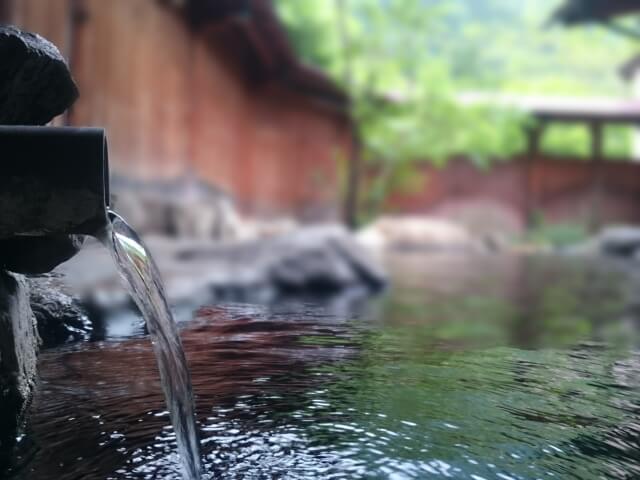
1. Hakone Yumoto Onsen (Kanagawa) 90 minutes
Hakone is widely known as one of the most popular onsen towns in Japan. In fact for many people, the natural hot springs are the first thing that come to mind when thinking of Hakone. There are 17 hot spring sources in the area of Hakone, also known as Hakone Ju-nana-yu (Hakone 17), including the most famous Yumoto, Kowakudani and Sengoku. Each onsen area offers different water quality and subsequent health and/or beauty benefits. Some require bathing suits and others allow tattoos .

Located in the west part of Kanagawa prefecture , Hakone attracts numerous tourists all year round with a range of tourist attractions and scenic spots around. Because Hakone is easily accessible from Tokyo, it takes only 1.5 hours to get to the area from Tokyo by train, it is a popular day trip destination as well!
Popular attractions around Hakone Yumoto Onsen
- Lake Ashi : a large crater lake offering a peaceful cruise with the stunning views of Mt. Fuji.
- Hakone Shrine : a sacred shrine dating back around 1,300 years that stands in the peaceful forests by the lake.
- The Hakone Open-air Museum : Beautiful museum with a variety of unique exhibits displayed inside and outside of the museum in harmony with nature around.
Take the Odakyu Romancecar from JR Shinjuku Station and get off at Hakone Yumoto Station (1.5 hrs, ¥2,330).

2. Kusatsu Onsen (Gunma) 3-4 hours
Kusatsu is a traditional onsen town that is located in Gunma prefecture . The town is famed for its high quality water and especially for its health benefits which are said to cure any kind of illness, except for lovesickness. The hot water field known as yubatake is the symbol of Kusatsu Onsen. A total of 32,000 liters of hot water gushes out of the hot spring per minute, and yubatake in the center of the town is the place where the piping hot water is cooled down. There are over 100 Japanese ryokan offering relaxing onsen experiences around the city. It also produces the largest amount of hot spring water as a solo onsen resort in Japan. Once you step into the city, you will soon realize the unique smell of sulfate that embraces the entire city!
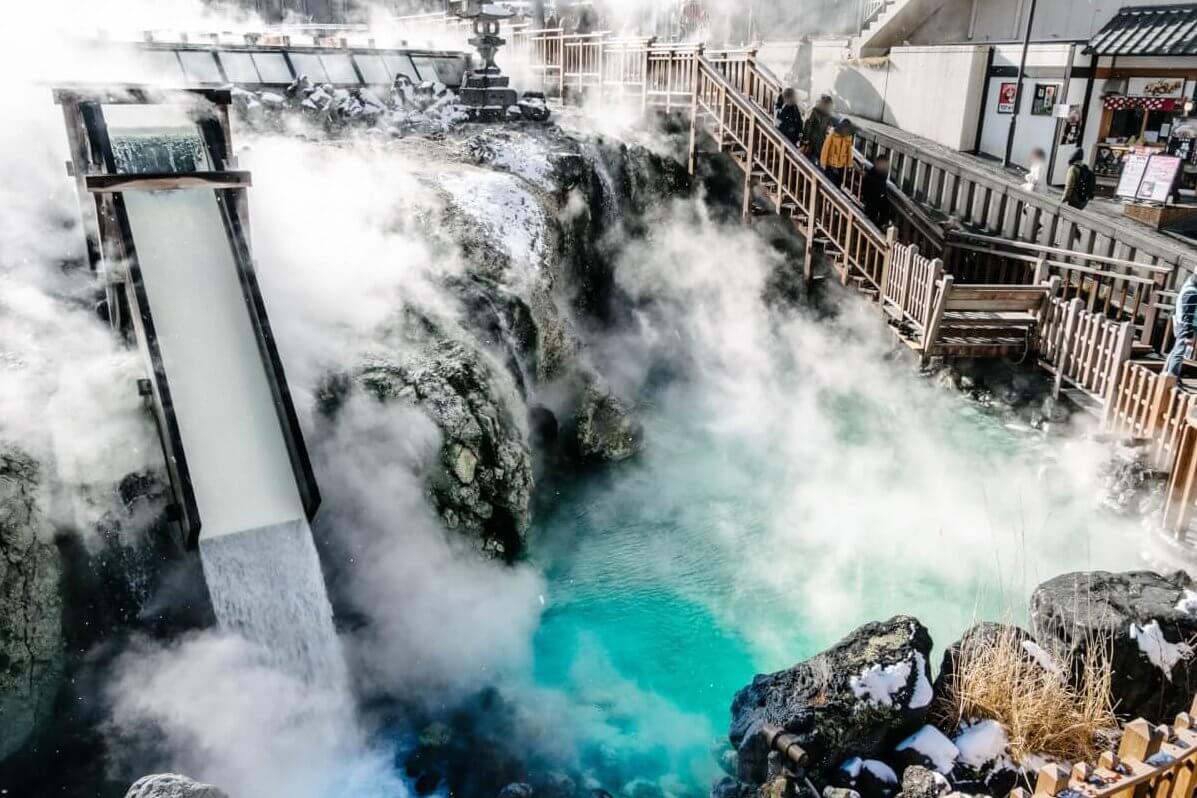
Popular attractions in Kusatsu Onsen
- Kusatsu Yubatake : The symbolic spot known as the “hot water field” that is situated in the center of the city. It looks like a giant pool storing a large amount of hot spring water and is especially beautiful when illuminated at night!
- Nishinokawara Park : This is a nice quiet park with a number of hot spring sources, free foot baths, and seasonal plants around.
- Yumomi (Netsunoyu) : Enjoy traditional performances to cool down the hot spring water!
Take the limited express Tokkyu Kusatsu from JR Ueno Station. Get off at Naganohara Kusatsuguchi Station. It takes 20 min to get to Kusatsu Onsen by bus (3-3.5 hrs, ¥5,450).

3. Ikaho Onsen (Gunma)
Gunma Prefecture is also home to another famous hot spring destination called Ikaho . It is located on the foot of Mt. Haruna and is known for the 365 symbolic stone steps running through the main district of the village. On each side of the steps, you can find a variety of attractions such as traditional Japanese inns, gift shops, restaurants, and other entertainment spots.
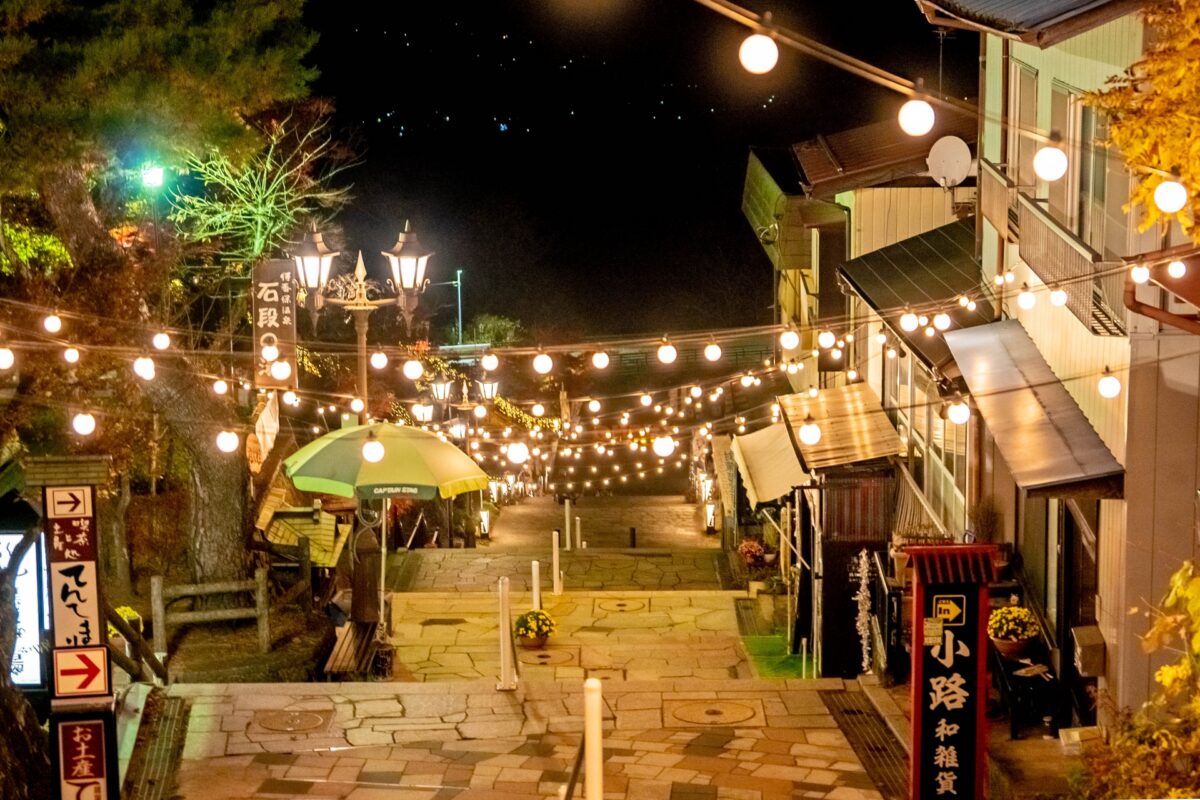
Explore the peaceful town along the stone steps until you finally reach Ikaho Shrine standing at the top. The colors of water of Ikaho also make it unique: golden and silver water that deliver different types of health benefits!

Popular attractions in Ikaho Onsen
- Ikaho Shrine : An iconic and historical shrine offering a panoramic view of Mt. Haruna & other surrounding peaks!
- Kajika Bridge : The perfect spot to enjoy stunning autumn leaves from the bridge beautifully painted in red.
Take the limited express Tokkyu Kusatsu from JR Ueno Station and get off at Shibukawa Kusatsuguchi Station. From there it takes 30 min to get to Ikaho Onsen by bus (2–2.5 hrs, ¥4,200)
4. Nasu Onsen (Tochigi)
Nasu is a famous hot spring resort in Tochigi Prefecture that draws almost 5 million visitors every year. The first hot spring facility is said to be founded around 630, and Nasu Onsen has since then developed as a popular onsen destination with its beautiful natural surroundings. It consists of 7 separate areas with different hot spring sources, scattered across the mountainside. Visitors can try each of them while receiving a range of benefits and effects!
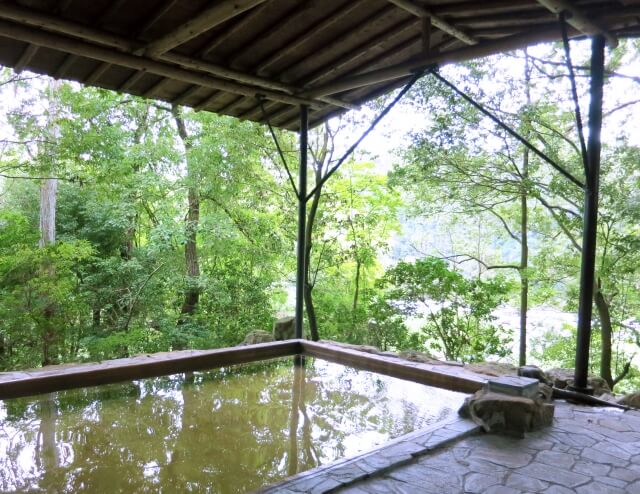
Popular attractions in Nasu Onsen:
- Mt. Nasu : A scenic mountain offering panoramic views.
- Killing Stone : A large rock that vents poisonous gasses.
- Minamigaoka Ranch : Admission-free ranch with a range of outdoor activities and interaction with animals.
Take the Tohoku Shinkansen to Nasushiobara Station (70 min, ¥5,390). From there switch to local buses from there, depending on which hot spring facilities you want to visit it will take about 40-60 min (¥300).

5. Kinugawa Onsen (Tochigi)
Kinugawa is another onsen resort in Tochigi Prefecture , near the popular Nikko area. It was discovered in the Edo period about 260 years ago and at the time only notable monks and feudal clans visiting Nikko were granted permission to enjoy the hot spring. It was later opened to the public, and developed as one of the most famous onsen resorts in the Kanto region . In the 1970’s tourism was booming here and many large ryokan facilities were built. After the recession in the 1990’s some went out of business and the abandoned buildings give an interesting vibe to the area. The water is relatively mild and safe even for those who have sensitive skin, and effective to treat a range of health problems such as fatigue and neuralgia.

Popular tourist attractions Kinugawa Onsen
- Nikko Toshogu Shrine : The famous UNESCO World Heritage Site which enshrines Tokugawa Ieyasu, the first shogunate of the Tokugawa Shogunate.
- Kinugawa river : An iconic river where you can join memorable river rafting!
- Tobu World Square : Unique theme park with a number of 1/25 scale reproductions of famous buildings and architectures from all over the world.
Take the Tobu Nikko Kinugawa train from JR Asakusa Station to Kinugawa-Onsen Station (2 hrs, ¥2,890)
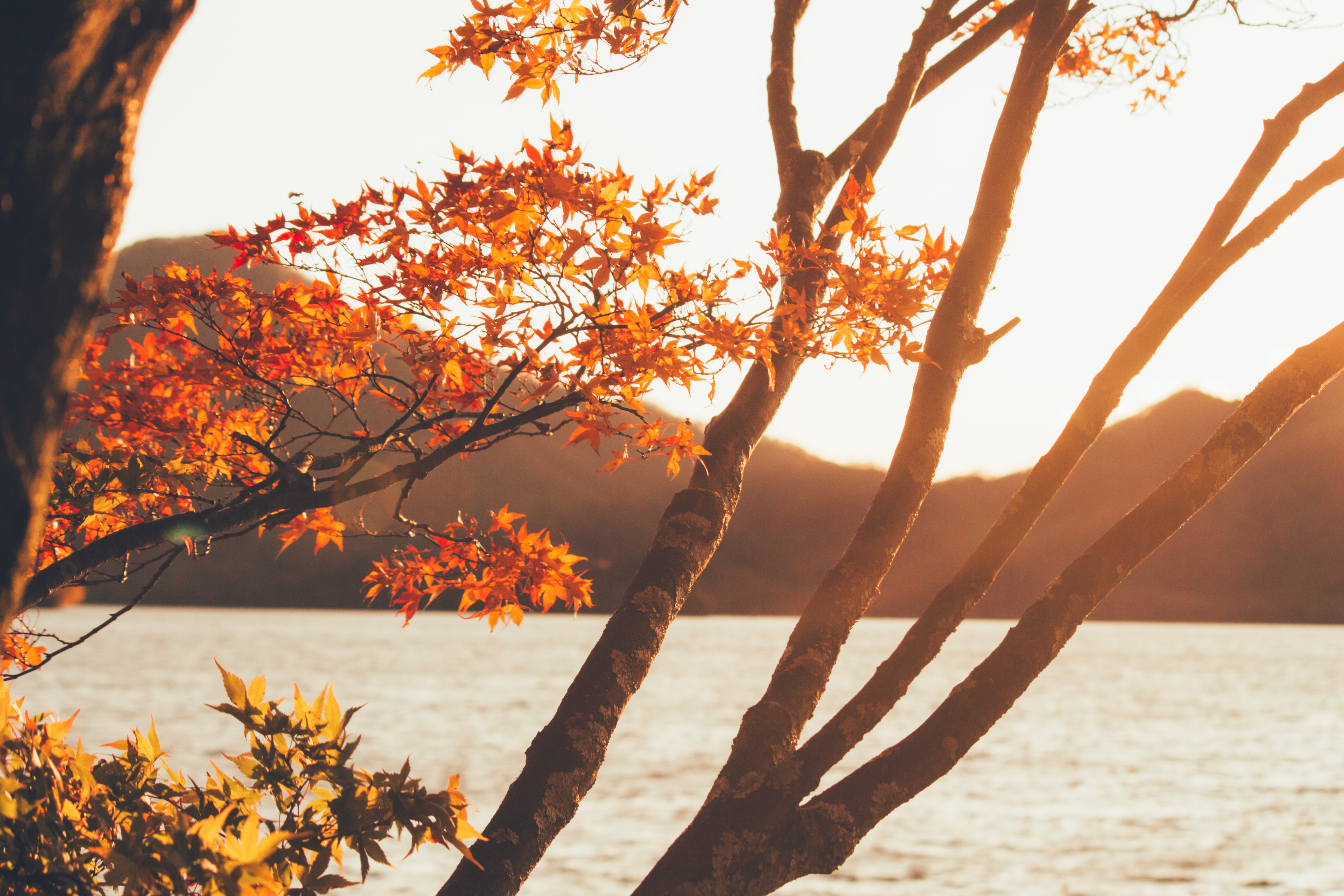
6. Gora Onsen (Kanagawa)
Gora Onsen refers to the hot spring area that covers the area around the Gora Station on Hakone Tozan Railway. It is sometimes considered as a part of Hakone Onsen, and welcomes visitors with luxurious inns and different types of hot spring sources. In the early 19 th century, the area experienced rapid development as a holiday villa area for celebrities along with the opening of Gora park. It currently boasts 46 hot spring sources which allows visitors to enjoy different colors of onsen classified into 5 types.
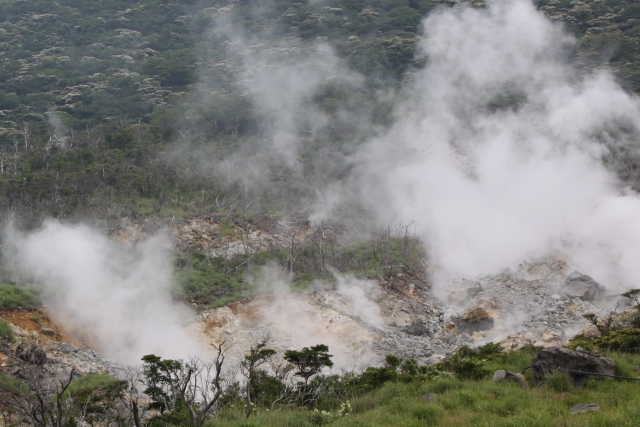
Popular attractions near Gora Onsen
- Hakone Ropeway : Symbolic transport system in Hakone area taking you to the popular tourist attractions such as Owakudani Hell Valley (大涌谷).
- Hakone Gora Park : French-style garden with a range of seasonal flowers, cozy cafes, and unique experiences.
Take the Odakyu Romancecar from JR Shinjuku Station to Hakone Yumoto Station. Transfer to Hakone Tozan Railway and get off at Gora Station (2 hrs, ¥2,720)
7. Ito (Shizuoka)
Izu Peninsula in Shizuoka Prefecture is a preferred holiday destination because of its easy access from Tokyo (less than 2 hrs) and rich nature. Ito is a coastal city located in the north eastern part of Izu Peninsula along with other famous onsen resorts such as Atami . Ito boasts the third largest output of onsen water per minute with more than 750 sources that can be found around the city. The large volume of onsen water allows visitors to enjoy the 100% natural hot springs directly from the sources without any additives at a number of inns and hotels in the area.
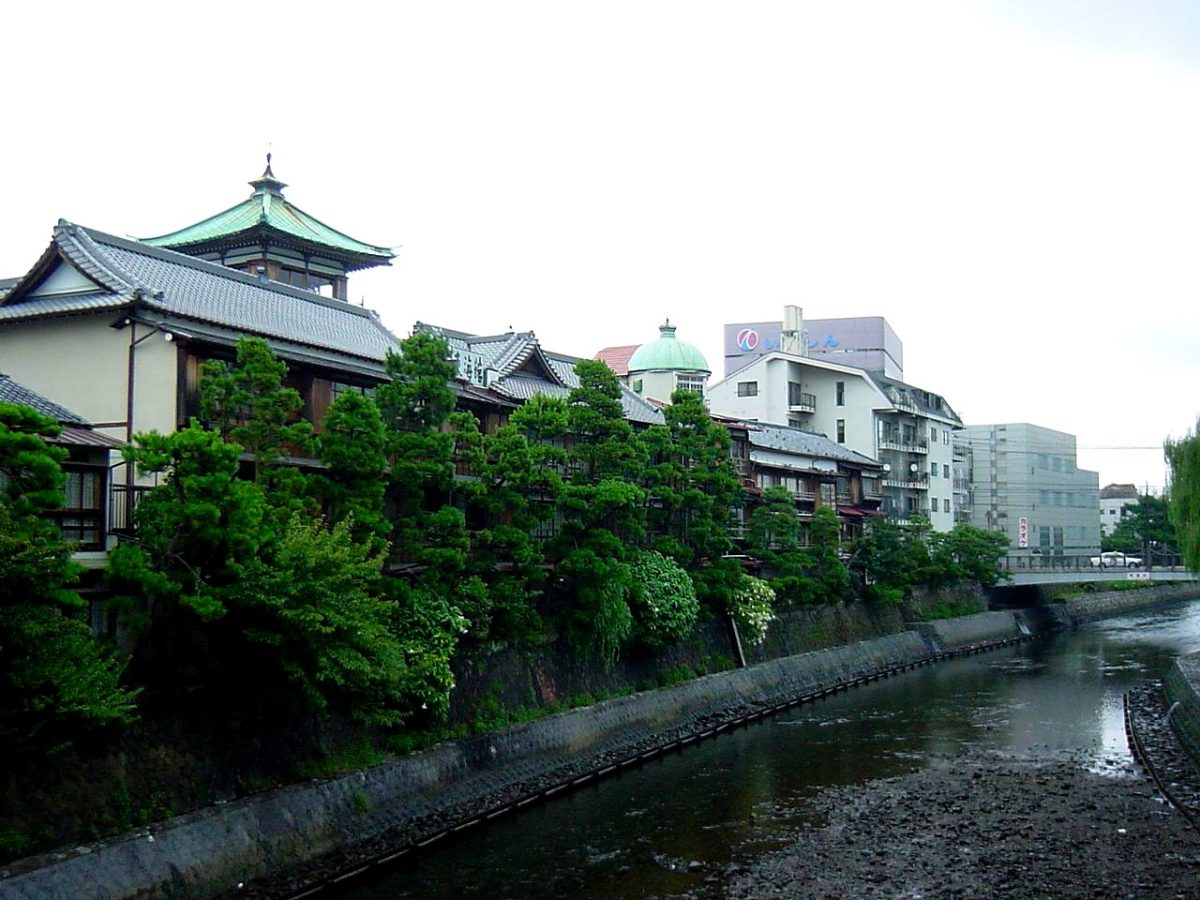
Popular attractions near Ito:
- Jogasaki Coast : Enjoy the stunning coastline scenery and enjoy a refreshing hike.
- Mt. Omuro : A 580 meters extinct volcano offering a panoramic view of Mt. Fuji!
Take the limited express JR Odoriko from Shinagawa Station. It takes you directly to Ito Station without transfer (1.5 hrs/ ¥4,200). You can also take the Shinkansen to JR Atami Station and transfer to JR Ito Line.

8. Shuzenji (Shizuoka)
A 1.5 hour train ride east from Ito city takes you to Shuzenji, another hot spring resort situated in the mountainous area of Izu Peninsula. Shuzenji is known as the oldest onsen resort on the Izu peninsula, it is said to date back to the early 9 th century. The peaceful area has also been visited and is loved by many famous novelists and writers such as Mori Ogai and Natsume Soseki.
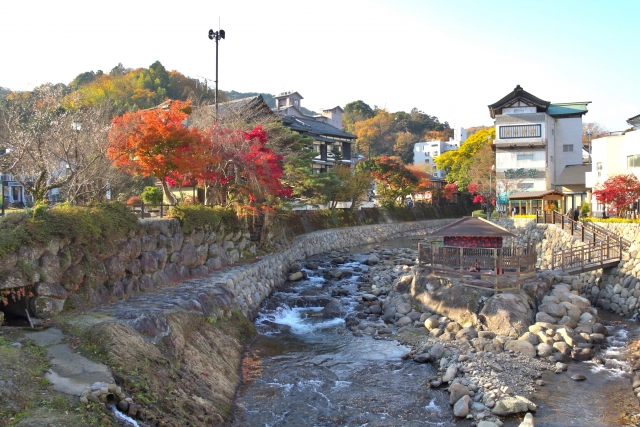
Popular attractions near Shuzenji:
- Shuzenji Bamboo Path : Walk through the beautiful bamboo grove while immersing yourself in the sacred atmosphere.
- Shuzenji Temple : Pay a visit to the symbolic temple located in the heart of the city.
- Joren Waterfall : The perfect spot for a refreshing stroll along with the scenic waterfall.
Take the limited express JR Odoriko from Shinagawa station that will take you to Shuzenji Station without transfer (2 hrs, ¥4,800). You can also take the Shinkansen to JR Mishima station and transfer to the Izu Hakone Railway.
9. Manza Onsen (Gunma)
Located at 1,800 meters above sea level, Manza Onsen welcomes visitors with some of the most fascinating landscapes that you can enjoy from an onsen. Manza Onsen is a part of Joshinetsu-Kogen National Park that covers vast areas including Gunma, Nagano, and Niigata prefecture across borders. The milky-white water contains a large amount of sulfur, which has a positive effect on your blood flow and metabolism. It is also known as a perfect ski destination during the winter season !
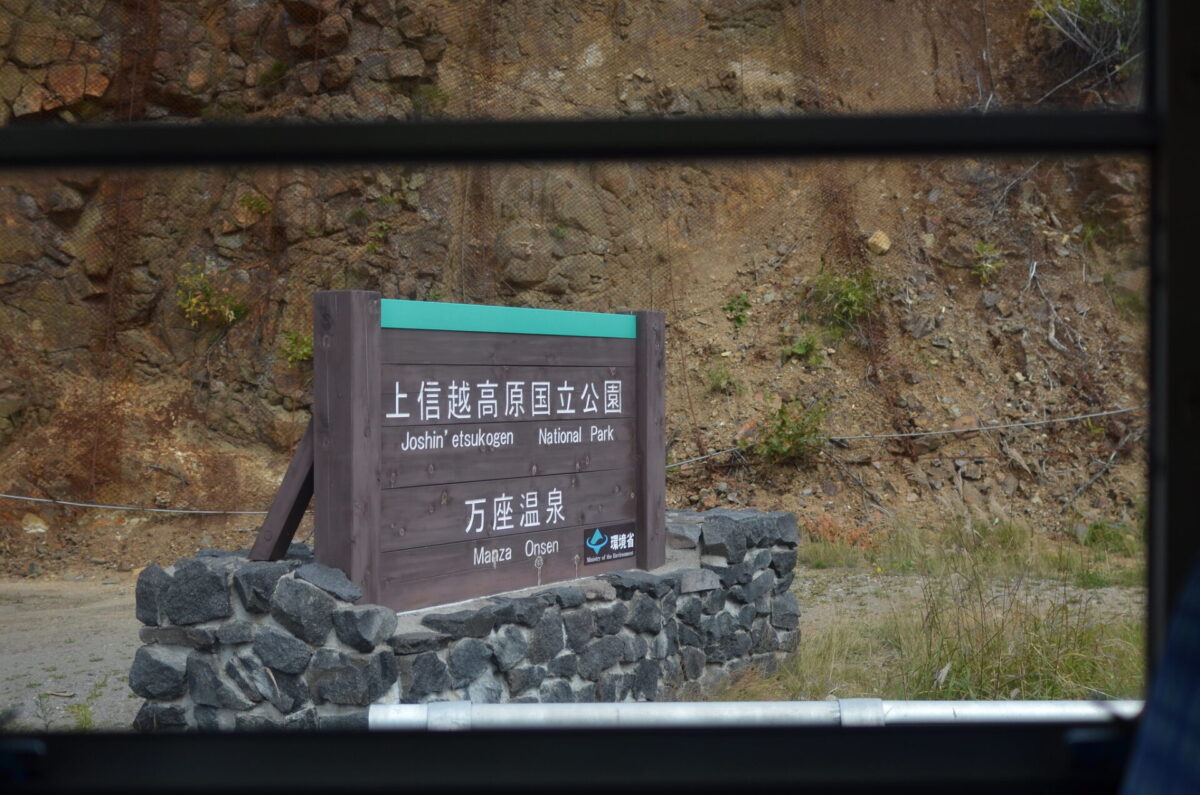
Popular attractions near Manza Onsen
- Manza Onsen Prince Ski Resort : Enjoy an exciting ski experience and refreshing hot springs!
- Manza Onsen Nisshinkan : Treat yourself to the open-air hot spring and buffet-style dishes!
Take the bus, Shinkansen, or local train to Karuizawa Station or Kazawaguchi Station. Transfer to the Seibu Kanko Bus and get off at Manza Bus Terminal (3-4 hrs, ¥5,000- ¥9,000, depending on your mode of transportation).
10. Shima Onsen (Gunma)
Shima is a nostalgic onsen resort stretching about 4 km along the Shima river running through Gunma prefecture. It consists of 5 districts that each feature unique tourist attractions and traditional Japanese ryokans.
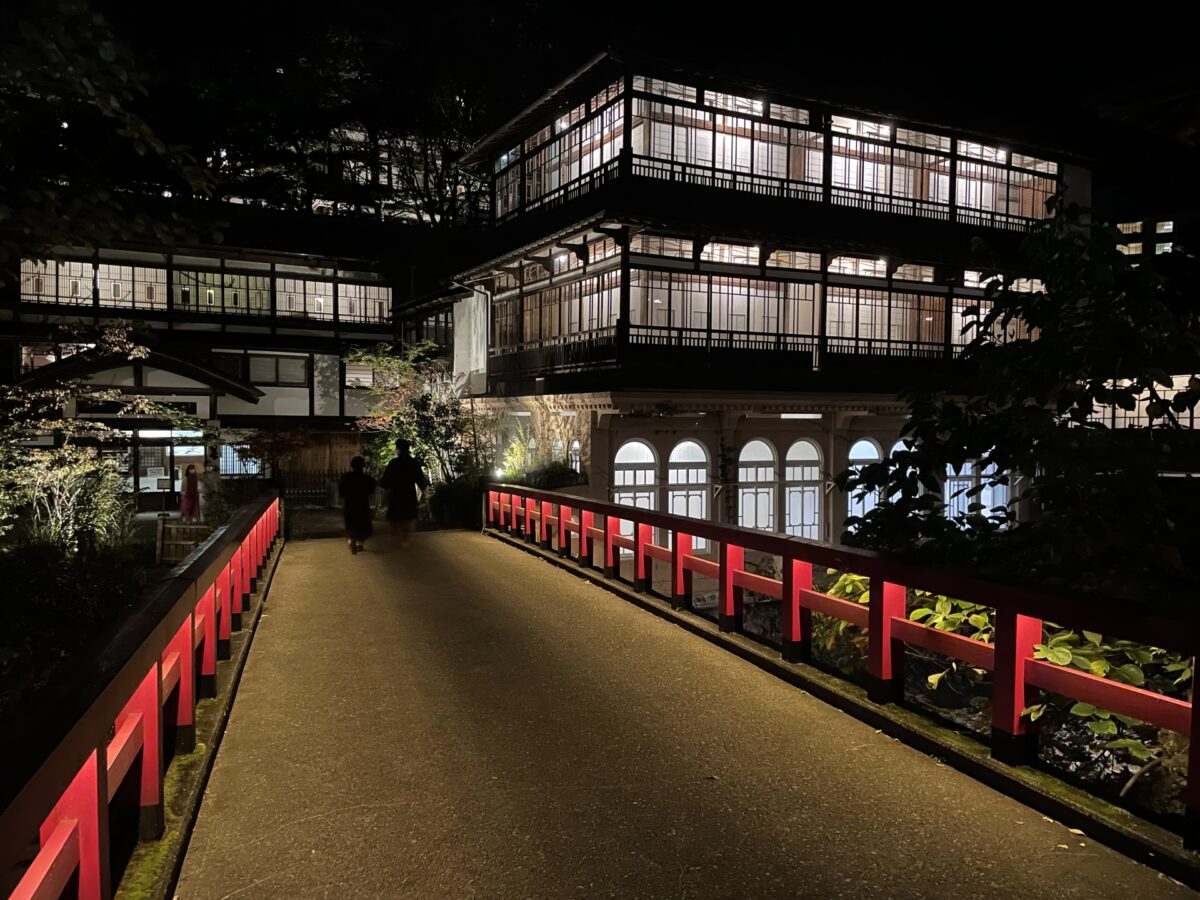
Sekizenkan is one of the most famous and renowned ryokan offering amazing services. The main building is known as the oldest wooden onsen facility in Japan and is designated as a Important Cultural Property. It is also said that the bath house of Spirited away , the world-famous Ghibli movie, is modeled after the building and the iconic red bridge in front!
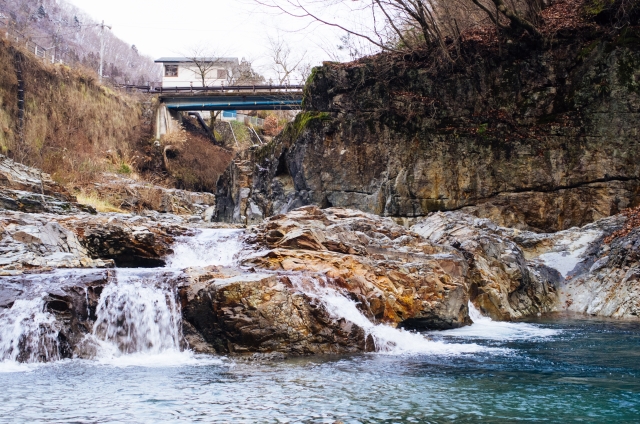
Popular attractions near Shima Onsen
- Okushimako : Take a refreshing stroll around the beautiful artificial lake while exploring the surrounding nature that changes for each season!
- Shima no Oketsu : Naturally created potholes that can be spotted in the crystal-clear flow of Shima river.
Taking the highway bus is the easiest and cheapest way to get to Shima Onsen from Tokyo (3.5 hrs, ¥3,150).
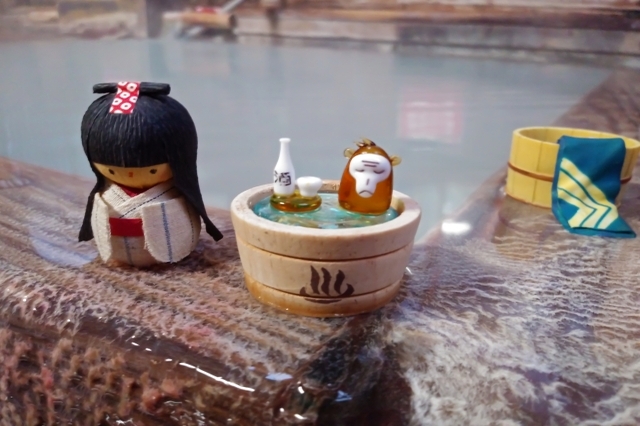
It can be a little bit challenging to take a public bath if you have no onsen experience before. You may feel embarrassed in the beginning, but gradually get used to it and start to feel comfortable as you soak your body in the relaxing hot water. It is also enjoyable to combine your onsen trip with exploring the surrounding area and trying local food or visit famous tourist attractions. You might think winter is not suitable for onsen because of the cold weather, but it is actually the perfect season to enjoy it as the temperature of onsen is generally higher than usual bath. Let yourself unwind in the natural-heated hot springs while enjoying the stunning sceneries created by the white snow!
▼Book our izakaya-hopping tour in Shinjuku!

Japan Wonder Travel is a travel agency that offers guided tours throughout Japan. From private walking tours to delicious Food and Drink tours, we can help organize the best tours just for you! If you want to explore Japan and learn more about the history and backstories of each area you are traveling in, our knowledgeable and friendly guides will happily take you to the best spots! In addition, we can provide you with any assistance you may need for your upcoming trip to Japan, so please feel free to contact us if you have any questions or need some help!
▶ Tokyo Tsukiji Fish Market Food and Drink Tour Explore the most lively and popular fish market in Tokyo, where you will have the chance to try some of the local’s favorite street foods and sake along with your friendly English-speaking guide!

▶ Tokyo 1–Day Highlights Private Walking Tour (8 Hours) There’s no better way to explore an area than taking a tour with a knowledgeable local guide. You will have the chance to learn about the history and interesting background stories of Tokyo, as well as discover some hidden gems which can be hard to do without a guide.

▶ Shinjuku Bar Hopping Tour: Experience Tokyo’s Nightlife in Izakaya Check out the best spots in Shinjuku while bar hopping through the lively and vibrant area. Try some delicious local food and drink as you explore the narrow yet photogenic alleys that the town has to offer. Experience Japanese izakaya culture and drink in Shinjuku like the locals!
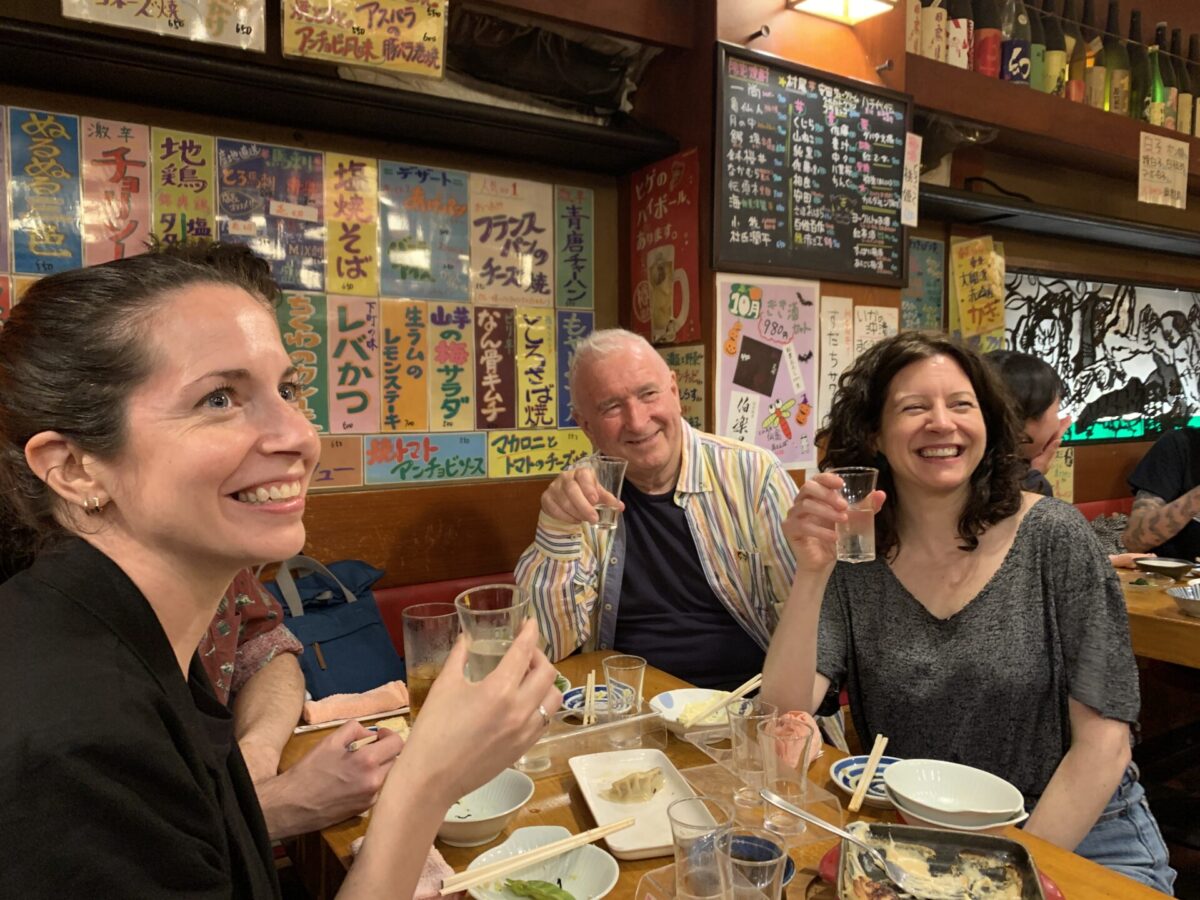
Follow us on Instagram or Facebook for more travel inspiration. Or tag us to get featured!
Happy traveling!
Stay informed of the best travel tips to Japan, the most exciting things to do and see, and the top experiences to have with the Japan Wonder Travel Newsletter. Once every two weeks we will introduce you to our latest content.

This post contains some affiliate links. When you click through and make a purchase we may receive some commission, at no extra costs to you.

- Popular destinations
- Hidden places in Japan
- Tours and workshop
- Food and drink in Japan
- Itinerary in Japan
- Places to visit in Tokyo
- Food and drink in Tokyo
- Seasonal events
- Tours & workshops
- Tokyo This Week
- Day trip from Tokyo
- Itinerary in Tokyo
- Places to visit in Kyoto
- Food and drink in Kyoto
- Itinerary in Kyoto
- Day trip from Kyoto
- Travel tips
- Accommodation
- Cultural tips
- Transportation
- Tokyo Tours
- Kyoto Tours
- Kimono Rental
- Fukushima Tours
- Mount Fuji Tours
- Tour Package
- Media Kit(English/日本語)
- Tokyo Cheapo (繁體中文)
5 Best Onsen Towns Near Tokyo for a Winter Escape
Japan has more hot spring facilities than almost anywhere in the world, so it’s the perfect place to warm up this winter with a good soak. Luckily, there are plenty of onsen towns near Tokyo to dip your toes into.
Winter in Japan is made bearable by sinking into a hot, steaming onsen (hot spring) so relaxing that you forget you’re in a room full of naked people. There are plenty of baths in Tokyo , but for a real escape head into nature to one of these resorts.
1. Kusatsu: A top-rated onsen
4 hours from Shinjuku or Shibuya stations by bus From ¥ 3,100 (one way)

An easy bus ride from Tokyo, Kusatsu is one of the better-known spots among onsen lovers due to its unique, open-air cooling technique. Stroll through the streets in the evening to admire the yubatake : a giant chute of hot water running through the center of the town and supplying the many onsen nearby.
You can try super-hot pools for free throughout the town and pay a small fee for some of the cooled ones with facilities. Although Kusatsu works as a day trip, you don’t want to miss the lights at night, so make this one an overnight stay. Don’t worry: Kusatsu can be done on a budget , so it shouldn’t break the bank.
Have a look at our guide to Kusatsu for all the info.
Getting there: Buses are a convenient way to reach Kusatsu as they run directly from Shinjuku and Shibuya stations and are affordable too! They take 4 hours and cost between [price amount=1500] and [price amount=3600] each way through Kosoku or Willer . -->
2. Hakone: Hot springs galore and Mt. Fuji views
1 hour 30 minutes from Shinjuku Station by train ¥ 2,470 (one way) or get the Hakone Free Pass

Hakone is just an hour and a half from Tokyo and famed for onsen with views of Mount Fuji , not to mention the pirate ship on the lake.
If you’re after a fun take on an onsen, check out Yunessun — an onsen theme park with wine baths, tea baths, and more. For a traditional approach, choose from the many ryokan (traditional Japanese inns) that open their doors to visitors, like Kohan-no-yu which looks out across Lake Ashi. If you have tattoos, head to Tenzan , which has a beautiful rock-lined rotenburo (outdoor bath) and is more accepting than most (i.e., be discreet and you’ll be fine).
Hakone has plenty more than onsen to keep you entertained, with the aforementioned pirate ship plus art galleries, teahouses, steaming valleys, and other attractions.
Pro tip: Make the most of your time in Hakone by booking this private sightseeing tour . It’s fully customizable and you’ll be accompanied by a nationally certified, English-speaking guide.
Read more about things to do in Hakone in our full Hakone guide and also check out how to get from Tokyo to the onsen town .
3. Ikaho: Iron-rich waters and slurp-worthy noodles
2 hour 30 minutes from Shinjuku Station by bus From ¥ 2,850 (one way)

Best known for the 300-meter staircase that leads up through the town, Ikaho is another of Gunma’s four famed onsen. The thermal waters here are reddish brown thanks to the iron presence and are believed to be good for poor circulation and fatigue.
Much like Kusatsu, you can see the source of the water here at the top of the steps, near the large public outdoor bath. There are two public baths in the town, and plenty of ryokan and hotels welcome visitors for between ¥ 410 – ¥ 1,500 a soak.
When you visit, be sure to make a short trip to nearby Mizusawa Temple, which is popular for the udon shops that line the route to its doors. The area is home to one of the three most famous types of udon in Japan, alongside Sanuki udon of Kagawa and Inaniwa udon of Akita.
Getting there: There are train options which are covered if you have a JR Pass (take the shinkansen to Takasaki and transfer to a local train to reach Shibukawa before hopping on a bus from there). Otherwise, a JR highway bus from Shinjuku Station is most convenient, as they run frequently each day direct (some continue to Kusatsu). The trip costs around [price amount=2600] each way and takes 2.5 hours.-->
4. Atami: A seaside resort
1 hour 40 minutes from Tokyo Station ¥ 1,980 (one way)

Once a major seaside destination for Tokyoites, Atami has seen a decline in visitors over the decades, but this gives it a special kind of yesteryear charm. There are unusual saltwater onsen with incredible sea views and plenty of traditional inns dating back way past Japan’s 1980s “bubble era.”
If you’re looking for a special romantic option, the Chikurinan Mizuno Resort , which overlooks the bay, has couple’s rotenburo (outdoor bath, requires reservation) in their forested grounds. While you’re there, you can visit the fake Atami Castle and even see the sex museum — it’s an unusual spot for sure! The area is well known for fishing, so you can also enjoy deliciously fresh seafood on your visit.
Check out our full day-trip guide to Atami and check out other nearby Izu spots .
Tip: For the non-Cheapo in a hurry, you can take the Shinkansen to Atami and slim the journey time down to 40 minutes.
5. Kinugawa: A riverside onsen town near Nikkō
2 hours 15 minutes from Asakusa Station by train ¥ 3,231 (one way)

Perfect if you’re looking to combine your trip with a visit to Nikkō , Kinugawa is less famous but still a popular option with beautiful scenery. Despite having been through a boom and decline, recently, abandoned hotels have been removed and the area is enjoying a new lease of life. There are new nature trails and foot baths near the river, as well as parks.
The water is mild and clear and has been soaked in since the Edo period — give it a try at the public or private baths dotted throughout the town. There is a small theme park recreating feudal Japan to visit between soaks, as well as a park featuring world landscapes in miniature — what more could you want from a weekend?
Getting there: The journey from Shinjuku takes 2 hours and costs [price amount=4080], as it includes a limited express service. The trains are partially covered by the JR Pass, but as they are jointly run by the Tobu Line and JR, additional fees must be paid. These trains require reservations and run frequently. Alternatively, if you're using the JR Tokyo Wide or another JR East regional rail pass , the trip is covered entirely. -->
See our guide to getting to Nikkō and our full area guide for more details on what to do.
Tip: If you want to leave behind the more built-up style of the town, visit one of the more rural spots like Okukinu Onsen (a collection of five onsen which require a bus from town and a hike to visit) or the small town of Yunishigawa (one hour by bus from Kinugawa), which is home to onsen as well as a snow house festival .
five onsen worth traveling for . Side note for the nervous: Being publicly naked may not be your idea of relaxing, but believe us (as some of the most prudish of prudes), it is so, so worth it. As long as you follow the onsen protocol , and after a few stares, the other people will soon lose interest and you can carry on your merry way.It's one of the most integral winter experiences you can have in Japan. -->
While we do our best to ensure it’s correct, information is subject to change. This article was first published in December 2017. Last updated November 2023.
- Hot springs
- Weekend-getaway
Get our Tokyo Cheapo Hacks direct to your inbox

Renting a Pocket Wifi Router in Japan: The Best Options

How and Where to Buy Shinkansen Tickets

TOP 20 Things to Do in Shinjuku, Tokyo

Top Japanese Phrases You Need Before Traveling to Japan

Best Budget Sushi Restaurants in Tokyo

A Beginner's Guide to Shibuya - Scramble Crossing, Shopping & Great Views!

When to See Cherry Blossoms in Japan

Tokyo Events This Week: Sanja Matsuri, Sumo, and Design Festa
Tokyo events for Monday, May 13 to Sunday, May 19, 2024.

Taste of Hakone: Easy Day-Trip Itinerary
From hot springs and museums to shrines and pirate ships, here's our DIY guide.

May 2024: 5 Events Not to Miss in Tokyo
May is the official start of festival season in Tokyo. With mega-fests like Sanja Matsuri and the Golden Week holiday, you're spoiled for choice!

7 Things To Do in Harajuku's Hottest New Attraction, Harakado
From rooftop bars to public baths, art spaces, and more — there's lots to keep you busy.

New Video: Hidden Gems — Tokyo's Most Underrated Shrines and Gardens
Tokyo is often described as busy, crowded and futuristic, but there are also traditional shrines and gardens where you can swap the hustle and bustle of the city for peace and quiet.

3 Hidden Sound, Art and Poetry Experiences in Tokyo
A different way to tune into the city.

Where To See Yaezakura: Late-Blooming Cherry Trees in Tokyo
8 perfect picks, from parks to shopping streets.

New Video: Top 20 Things to Do in Shinjuku
You'll need more than a day — there are LOTS of things to try!

Close without accepting
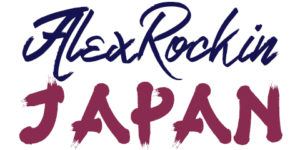
14 Amazing Onsen Towns Near Tokyo (Hot Springs & Ryokan)
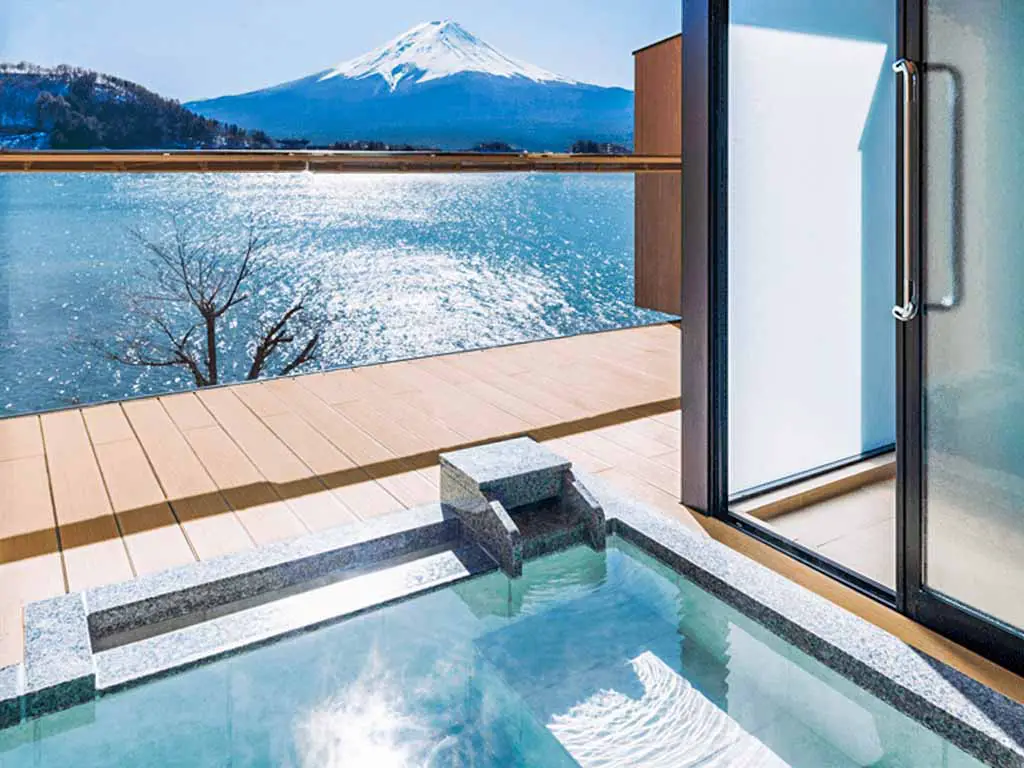
There are very famous and some of the best onsen towns near Tokyo that everybody has heard of. But did you know that there are so many more amazingly beautiful hot spring towns that you can visit as a day trip from Tokyo?
Hakone Onsen and Atami Onsen are some of the best onsen towns that can be reached in less than 90 minutes from Tokyo. Kusatsu Onsen and Manza Onsen are further away but the best choice for onsen hopping. Nasu Onsen and Minakami Onsen are serene onsen towns near Tokyo with wooden hot spring tubs.
Below you will find more information about all the 14 onsen towns near Tokyo. Get to know the top hot spring baths and onsen ryokans of each town so that you know where to start your onsen hopping adventure. You will also find more info about famous sightseeing spots and attractions nearby to help you select the best onsen town for your trip . I promise you it won’t be an easy decision, though!
1. Hakone Onsen (1.5h from Tokyo)
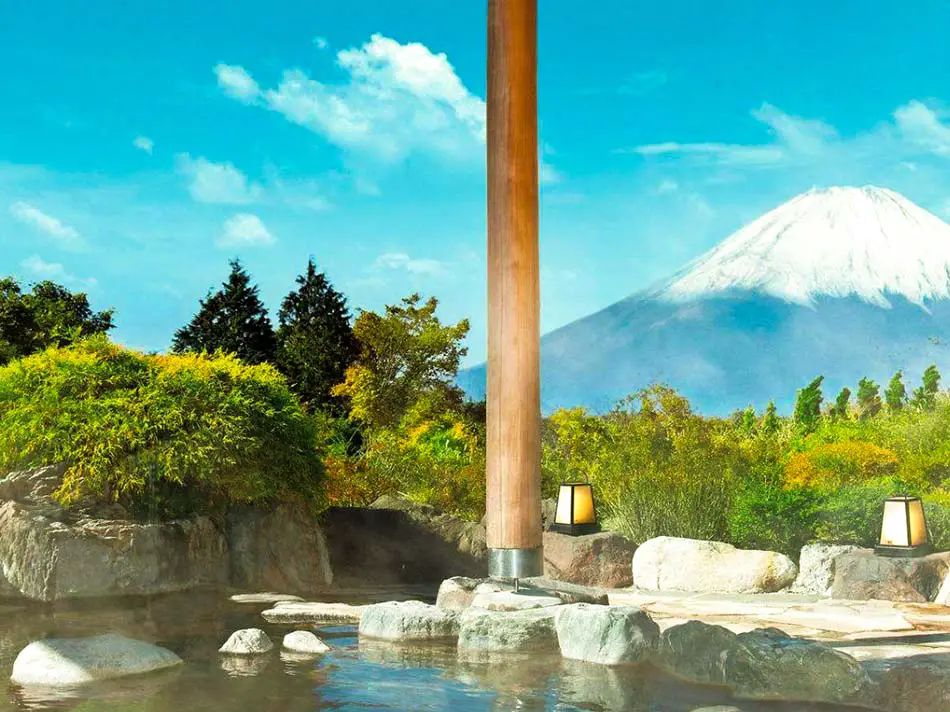
Location: Hakone, Fuji Hakone Izu National Park, Kanagawa Prefecture
General Information: Hakone Onsen (箱根温泉) is one of Japan’s most popular hot spring resorts and one of the most popular day trip destinations from Tokyo. It is part of the Fuji Hakone Izu National Park and offers plenty of beautiful hot spring baths and luxurious onsen ryokans. Hakone’s most famous attraction besides the hot springs is Lake Ashinoko with views of Mount Fuji.
Popular Onsen Town Near Tokyo: You can find more than 50 public bathhouses and onsen ryokans in Hakone. A lot of the ryokans open their doors to non-staying guests and so you can even enjoy their baths even as a daytime visitor. For bathing, I can recommend Tenzan Hot Spring Village (天山湯治郷), one of the best tattoo-friendly onsen near Tokyo, and Hakone Yuryo (箱根湯寮) is an onsen with beautiful forest views. In case you are staying overnight, I can recommend Hotel Green Plaza Hakone. It has one of the few outdoor baths from where you have views of Mount Fuji.
Access: Take a Kodama Shinkansen and get off at Odawara Station. From there transfer to a local bus or the Hakone Tozan Railway bound for Hakone-Yumoto or one of the other stops in the Fuji Hakone Izu National Park. It takes about 1.5 hours from Tokyo to Hakone Onsen. Since the Japan Rail Pass is only valid until Odawara you can also consider getting the Hakone Freepass.
2. Ito Onsen (1.5h from Tokyo)
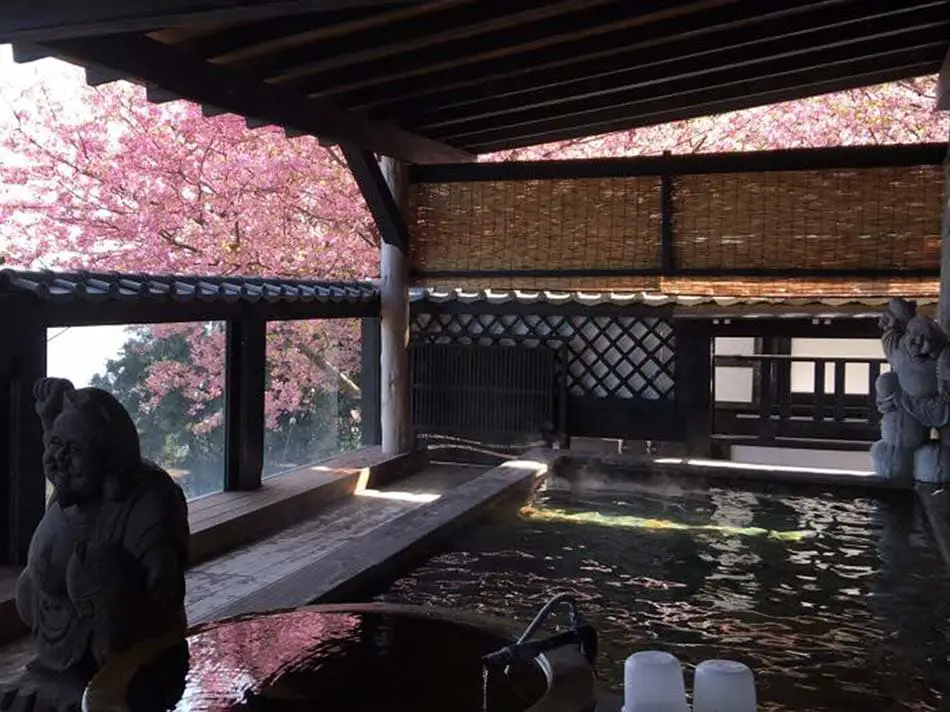
Location: Ito, Izu Peninsula, Shizuoka Prefecture
General Information: Ito Onsen (伊東温泉) is a famous hot spring resort that makes for a perfect day trip from Tokyo. It is located on the eastern coast of Shizuoka’s Izu Peninsula.
The peninsula is renowned for its onsen towns, Jogasaki’s rugged and scenic coastline, Shirahama’s white sand beach, and Kawazu’s early cherry blossoms.
Directly in Ito, you can also see Tokaikan, a historic hot spring ryokan that was built during the Showa period and is one of the few remaining wooden inns from that time.
Famous Onsen Town Near Tokyo: There are 8 public bathhouses and more than 30 hot spring inns. Each Sento is associated with one of the Seven Lucky Gods and you can find their statues nearby the bathhouses. The public onsen Wadayu, for example, is associated with Jurojin – the god of the elderly and of longevity. Its old-school indoor baths are not that pretty but very popular among day visitors and affordable for everyone.
For a real taste of Ito’s beautiful rotenburo I recommend you stay overnight. Toushinan Komeya (淘心庵 米屋) in Minami-Ito is one of my personal favorites featuring a cypress hot spring bath and a stone outdoor bath. There is also a really cheap hostel called K’s House Ito Onsen where I have stayed before. The building looks amazing and the private hot spring tubs were free of charge.
Access: You can take the Shinkansen to Atami Station and then transfer to the JR Ito Line which will bring you all the way to Ito and Minami-Ito. When I checked google maps it took 1 h 37 min from Tokyo Station to the ryokan in Ito. The JR Pass covers the whole trip until Ito Station, after that the pass is not valid anymore.
3. Atami Onsen (1h from Tokyo)
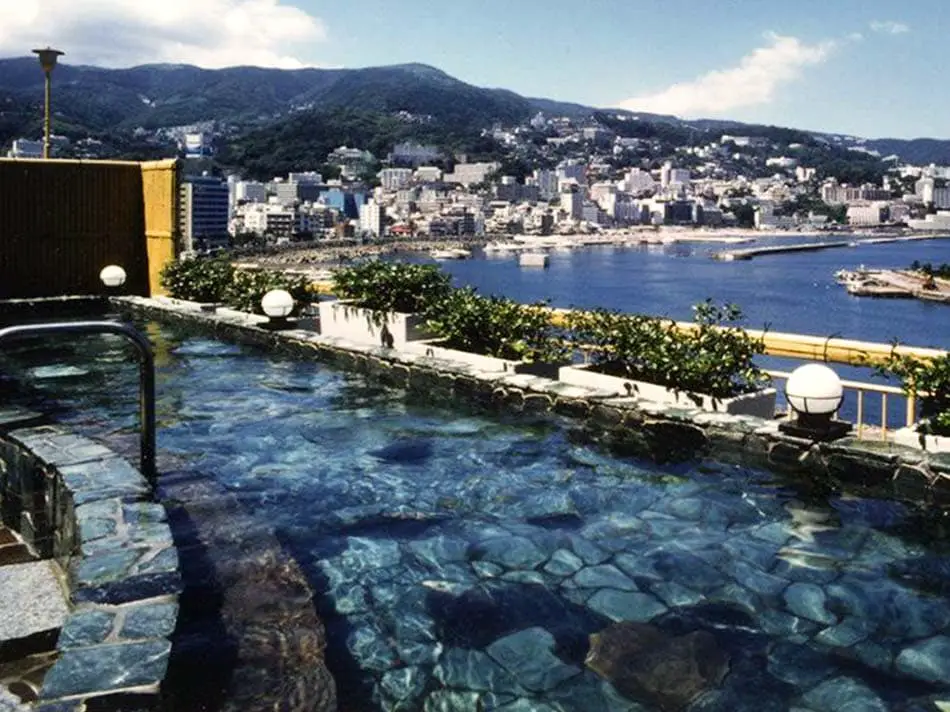
Location: Atami, Izu Peninsula, Shizuoka Prefecture
General Information: Atami Onsen (熱海温泉) is less than half an hour away from Ito Onsen and since the Shinkansen stops right at Atami Station you can get there in 45 minutes from Tokyo.
The hot spring town has a history of about 1,500 years and was loved by Tokugawa Ieyasu and other shoguns since the Nara Period. It has also been rated as one of Japan’s top 3 hot spring resorts.
Some of the top tourist attractions here are Atami Castle and the Atami Ropeway from where you have panoramic views of the ocean and an insanely beautiful night view.
Historical Hot Spring Town Near Tokyo: Fed by the Izusan Hot Spring this onsen town offers a rare opportunity to soak in a saltwater spring near Tokyo. This type of hot spring is good for the skin and is said to have a lot of beauty benefits.
In Atami Onsen, you can find a lot of really nice onsen baths for day-trippers so it is perfect if you do not want to stay overnight.
Atami Onsen Shukaen Yu No Hanazen (秀花園 湯の花膳), Nikkou-Tei Oo-Yu (日航亭 大湯) are the ones I can recommend.
Shukaen Yu No Hanazen is an onsen with beautiful ocean views located on top of the hill near the Atami Ropeway.
Yuyado Ichibanchi (湯宿一番地) is another really nice onsen but more expensive since bathing is only possible in combination with a dinner plan.
Access: Just hop on the Tokaido-Sanyo Shinkansen and you will be in Atami in less than 1 hour. With a JR Pass, the ride on the Shinkansen and the whole journey to Atami is covered, so I highly recommend you get one.
4. Ikaho Onsen (2.5h from Tokyo)
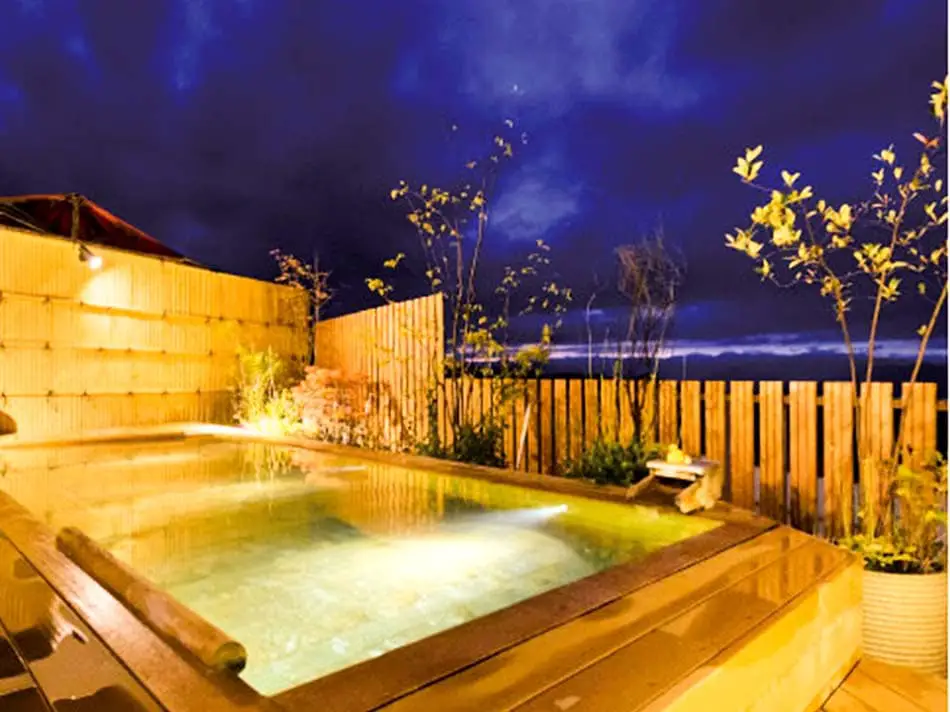
Location: Ikaho Onsen, Gunma Prefecture
General Information: Ikaho Onsen (伊香保温泉) is an onsen town near Tokyo that was formed more than 400 years ago. It is located on the eastern slopes of Mount Haruna and is famous for its reddish hot spring water.
The city’s symbol is a 300-meter-long staircase flanked by onsen ryokans and shops that many visitors explore in Yukata. Things to do in Ikaho Onsen include Kajika Bridge, a nice autumn color spot in late October and early November, the Ikaho Ropeway, a shrine, and a temple famous for Udon.
Famous Onsen Town in Gunma: Out of the 24 onsen ryokans and public baths I recommend Nagomigokoro No Yado Omori (和心の宿 大森) or Ikaho Rotenburo (伊香保露天風呂) for daytime visitors. They are both located near popular sightseeing spots and especially Naogmigokoro No Yado Omori is a beautiful onsen in the mountains .
Even though you can visit Ikaho Onsen as a day trip, it is definitely worth staying overnight. On my next visit, I am planning to stay at Hotel Tenbo (ホテル天坊). Check out their onsen facilities and you will know why.
Access: From the nearest station, JR Shibukawa Station, it is a 30-minute bus ride to Ikaho Onsen. The total journey from Tokyo takes 2.5 hours.
5. Kinugawa Onsen (2.5h from Tokyo)
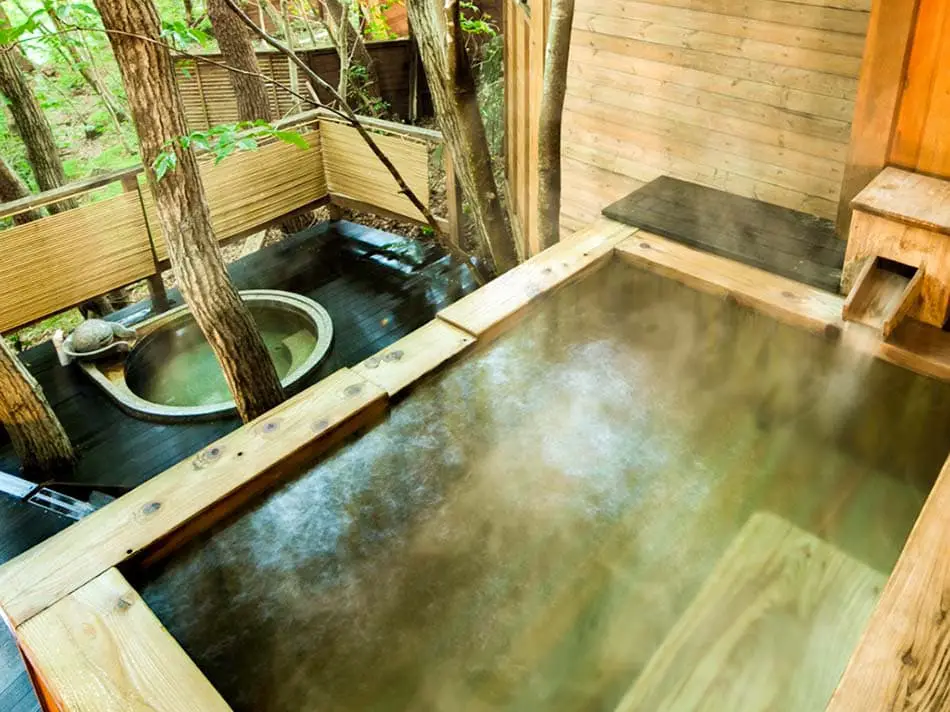
Location: Kinugawa Onsen, Near Nikko, Tochigi Prefecture
General Information: Kinugawa Onsen (鬼怒川温泉) is one of the most popular hot spring areas in the Kanto Region. In the past, only monks and daimyo of Nikko were allowed to use it. Later when it opened to the public during the Meiji period it became one of Kanto’s leading onsen destinations.
Near the onsen town, you can find the amusement parks Tobu World Square and Edo Wonderland Nikko Edomura. The latter is an Edo-style theme park imitating a traditional Japanese town featuring a Haunted Temple of Hell, a large Ninja Maze, and a Shuriken Dojo.
Popular Hot Spring Resort in Kanto: Kinugawa Hot Spring Town and its onsen stretch over a wide area along the Kinugawa River. While onsen hopping is still possible it involves more walking or short train rides than in other onsen towns.
Yudokoro Suzukaze (湯處すず風) is a traditional public onsen bath with a stone open-air onsen bath overlooking the river.
If you are looking for a more private onsen experience I would recommend Hanare No Yu Akebi (離れの湯 あけび) – extremely beautiful onsen baths as you can see in the picture but also more expensive. In total, there are about 25 onsen ryokans nearby.
Access: You can take the Ueno-Tokyo Line towards Utsunomiya and transfer at Urawa Station to the Nikko-Kinugawa Line to take the Special Kinugawa Limited Express to Kinugawa Onsen. For the onsen in Kinugawa get off at Kosagoe, Tobu World Square, Kinguawaonsen, Kinugawakoen, or Shin-Fujiwara. From Tokyo, you can get here in 2.5 – 3 hours.
6. Kusatsu Onsen (3h from Tokyo)
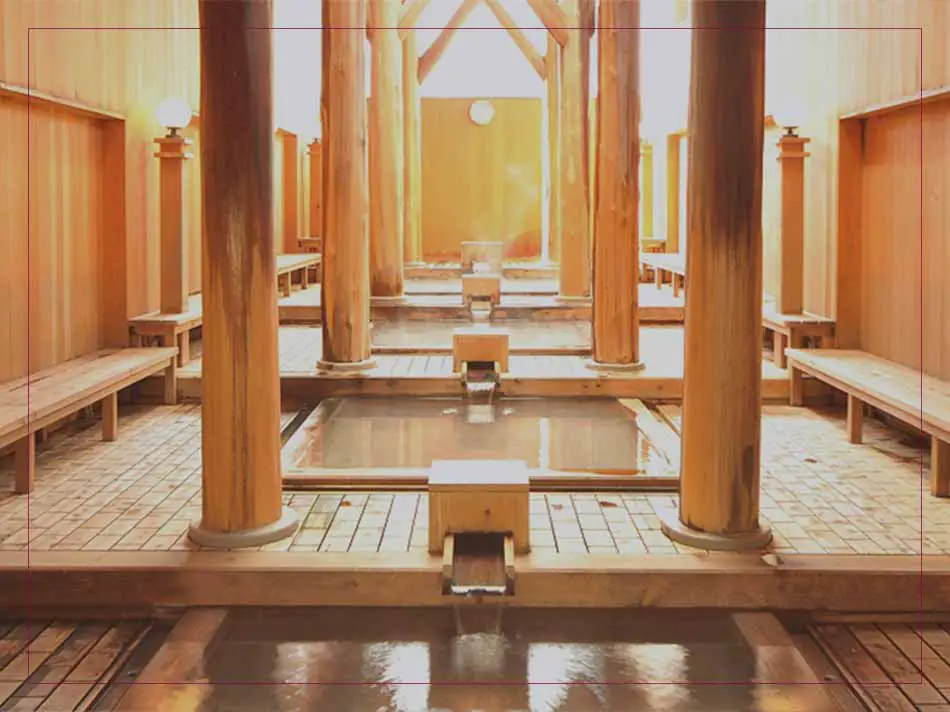
Location: Kusatsu Onsen, Joshinetsukogen National Park, Gunma Prefecture
General Information: Kusatsu Onsen (草津温泉) is one of my personal favorites and the only reason it is down here is that it takes a bit longer to get there. With 100 hot springs that produce 34,000 liters of water per minute, this tattoo-friendly onsen town near Tokyo is overflowing with hot spring water.
There are also all kinds of unique attractions like Yubatake, the hot spring waterfall in the center of the town, and Yumomi Performances that show how the water is cooled down.
Amazing Onsen Town Near Tokyo: Otaki No Yu, Goza No Yu, and Sainokawara Rotenburo are all tattoo-friendly hot springs with outstanding indoor and outdoor baths.
If you are traveling in a larger group you should go to Sainokawara because its outdoor bath can accommodate more than 100 bathers at once. I also highly recommend you stay overnight so that you can stroll around Yubatake when it is illuminated.
Yuyado Tokinoniwa (湯宿 季の庭) and O-Yado Konoha (お宿 木の葉) are my recommended onsen ryokans.
Access: Transfer to a bus bound for Kusatsu Onsen at the nearest JR station Naganohara-Kusatsuguchi Station. Most connections will bring you to the onsen town in about 3 hours from Tokyo.
7. Kawaguchiko Onsen (2.5h from Tokyo)
Location: Around Lake Kawaguchi, Yamanashi Prefecture
General Information: Kawaguchiko Onsen (河口湖温泉) is a tiny onsen town on the shores of Lake Kawaguchi, one of the Fuji Five Lakes. It is the best place to admire Mount Fuji and the best base to start your adventure of climbing up Japan’s sacred mountain.
You can come here all year round and enjoy the beautiful scenery of Fuji-san with cherry blossoms, blooming lavender, autumn leaves, or snowscapes. Soaking in one of the hot springs here is also another great reward after climbing Mount Fuji.
Onsen Town With Views of Mount Fuji: There are only a handful of onsen and hot spring ryokans in Kawaguchiko Onsen, but they offer some of the best views.
If you are planning to do a day trip to an onsen with views of Mount Fuji your choice should be Hotel Mifujien (ホテル美富士園).
If you want to spend the night at this beautiful destination you could stay at Koraku Onyado Fujiginkei (湖楽おんやど富士吟景), Fuji Kawaguchiko Onsen Hotel Konansou (湖南荘) or Kawaguchiko Ryokan Ubuya (河口湖旅館 うぶや).
A detailed blog post about Kawaguchiko Hot Spring Town and onsen with views of Mount Fuji will follow someday, I promise!
Access: The most convenient way to get to this onsen town near Tokyo is usually by bus, even though it isn’t covered by the JR Pass. You can also take the Chuo Line and then the Fujikyuko Line to Kawaguchiko Station. It takes 2 hours by bus and 2 – 3 hours by train from Tokyo.
8. Oku-Nikko Yumoto Onsen (4h from Tokyo)
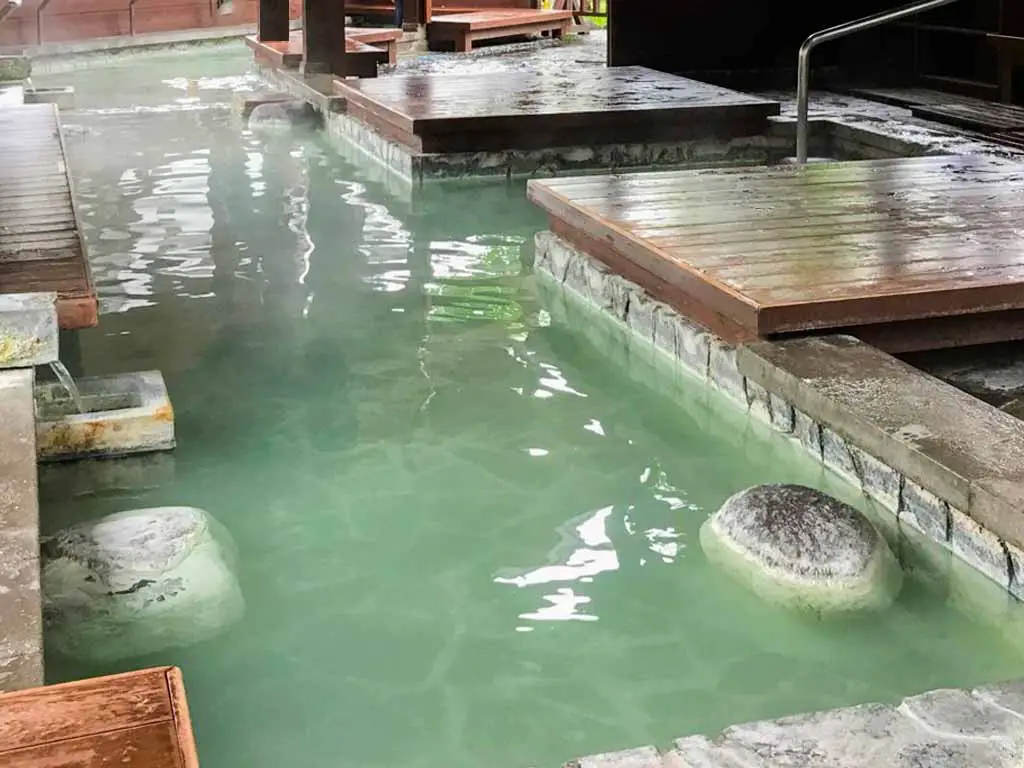
Location: Oku-Nikko, Near Nikko, Tochigi Prefecture
General Information: Oku-Nikko Yumoto Onsen (奥日光 湯元温泉) lies deeper in the Nikko National Park and is about 1.5 hours away from Nikko’s city center. Located on the northern shores of Yunoko Lake and at an altitude of 1,500 meters, this hidden gem of an onsen town is full of natural attractions like the Senjogahara Marshland or the Ryuzu Waterfall. The onsen town is most beautiful around mid-October when the autumn colors are at their peak.
Small Onsen Town Near Tokyo: On the official Oku-Nikko Yumoto Onsen webpage you can find more than 20 hot spring hotels and ryokans.
The onsen I find most intriguing is the Nikkosan Hot Spring Temple (日光山温泉寺). This is a real temple with one tiny and extremely hot onsen bath for women and one for men.
Larger onsen baths and outdoor baths as well as accommodation you can find at Okunikko Kogen Hotel (奥日光高原ホテル) or Yumori Kamaya (湯守釜屋).
Access: From Nikko Station take a bus bound for Yumoto Onsen and get off at the same-named bus stop. You can get to the onsen town in 1.5 hours from Nikko and about 3.5 – 4 hours from Tokyo.
Website: www.nikkoyumoto.com (Japanese only)
9. Minakami Onsen (1.5h from Tokyo)
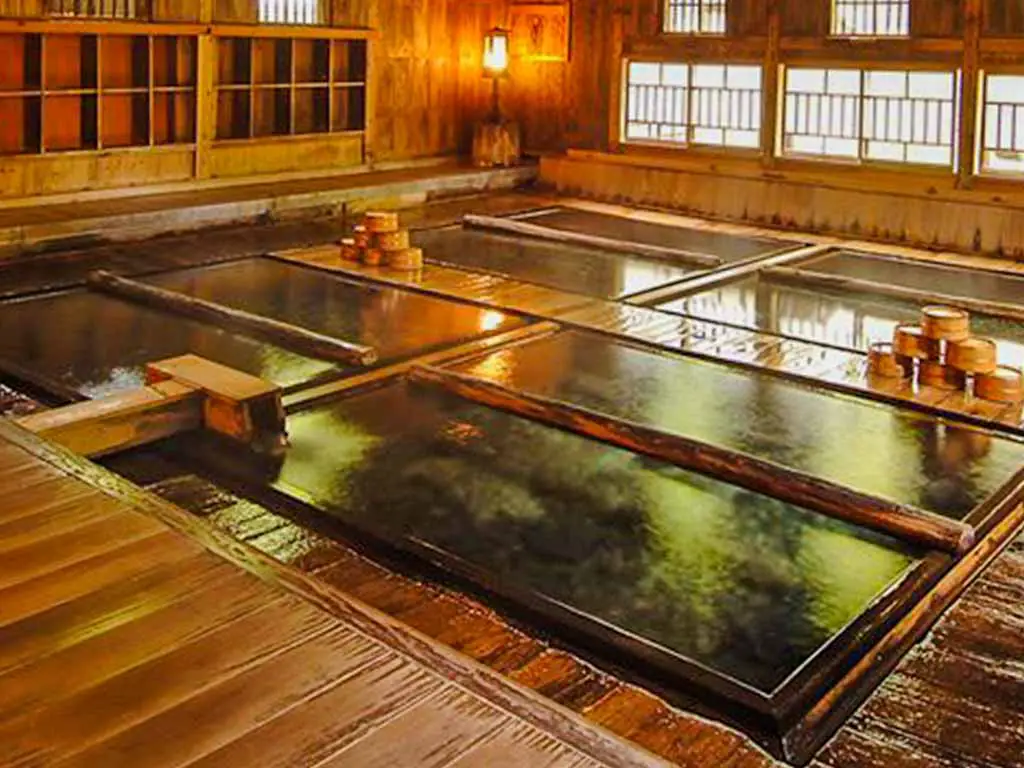
Location: Minakami, Gunma Prefecture
General Information: Minakami Onsen (水上温泉) is an old hot spring town with Ryokans lined up along the valley of the Tone River. This onsen town is a perfect choice if you love nature and want to soak in outdoor baths surrounded by green leaves or pretty autumn colors. Besides the hot springs, you can do all kinds of outdoor activities like rafting, canyoning, and hiking.
Old Hot Spring Town Near Tokyo: You can find a lot of hot spring hotels directly in Minakami Onsen. Minakami Hotel Juraku (みなかみホテルジュラク) looks very nice and welcomes day visitors. The most renowned onsen ryokans are nestled deeper in the mountains and further up the river, though.
Takaragawa Onsen Osenkaku (宝川温泉 汪泉閣) would be my first choice in winter. Its famous outdoor bath is unisex but everyone has to wear a special bathing garment.
Hoshi Onsen Chojukan (法師温泉 長寿館), although nearly a 1-hour bus ride away, would be my second first choice.
Access: The fastest way to get to Minakami onsen is to hop on the Joetsu Shinkansen, get off at Jomokogen Station and continue by bus. The bus ride is just about 13 minutes and the one-way trip from Tokyo takes about 1.5 hours.
Website: www.minakamionsen.com (English translation available)
10. Yugawara Onsen (1.5h from Tokyo)
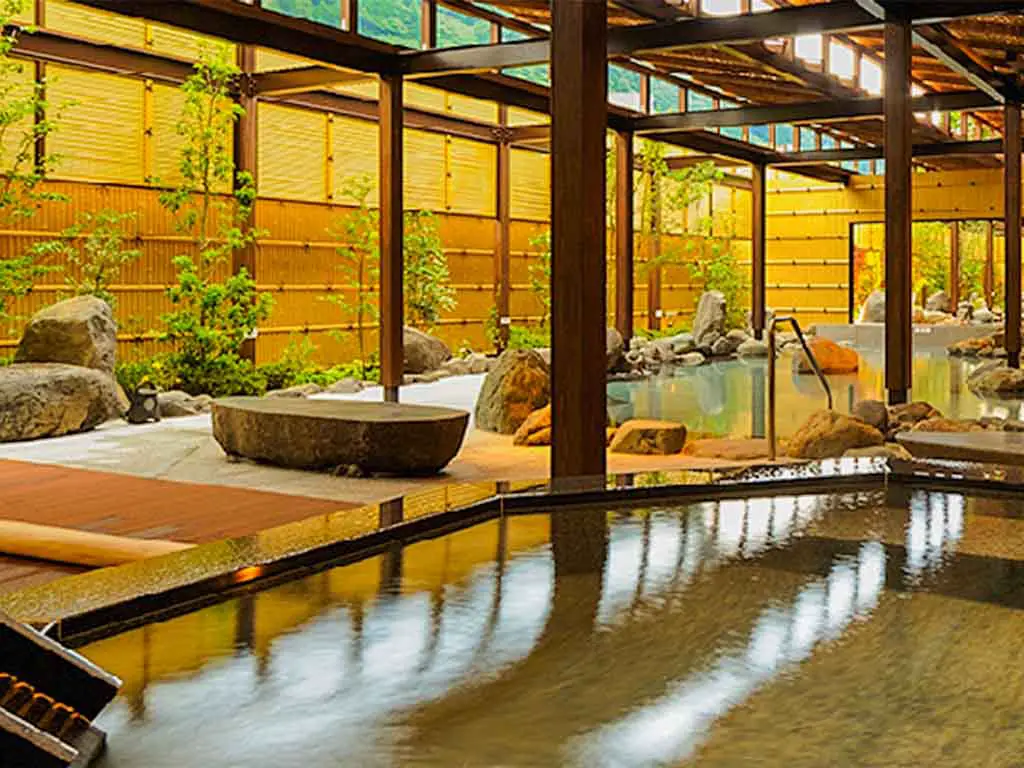
Location: Yugawara, Near Atami & Hakone, Kanagawa Prefecture
General Information: Yugawara Onsen resort (湯河原温泉) has a history of more than 1,250 years and is located between Atami Onsen and Hakone Onsen. It is less famous and less popular than the other hot spring towns in this area and therefore also less crowded. So if you are looking for a quiet little onsen town this is your place.
In the town, you will find an onsen footbath, and my personal highlight, the interesting-looking Head of Buddha at Fukusenji Temple. Apparently, nobody knows what happened to the body of the statue after its completion…
Quiet Onsen Town Near Tokyo: There are about 30 onsen ryokans in Yugawara. The best onsen for daytime visitors is New Welcity Yugawara (ニューウェルシティ湯河原) in my opinion. It offers modern onsen facilities with a variety of baths and a huge open-air bath.
For a traditional onsen ryokan experience, I would probably stay at Seiranso Ryokan (青巒荘). Just because of the incredible onsen open-air bath with a waterfall, but I also read a few reviews that the building is quite run down.
A safer option seems to be Hotel Chobosanso (ホテル眺望山荘) with a nice view from the onsen bath.
Access: Take the Shinkansen to Atami Station and transfer to the Tokaido Line. Get off at Yugawara Station. This takes about 1.5 hours. If you take the local train it will take about 2 hours.
Website: www.yugawara-resort.com
11. Shiobara Onsen (3h from Tokyo)
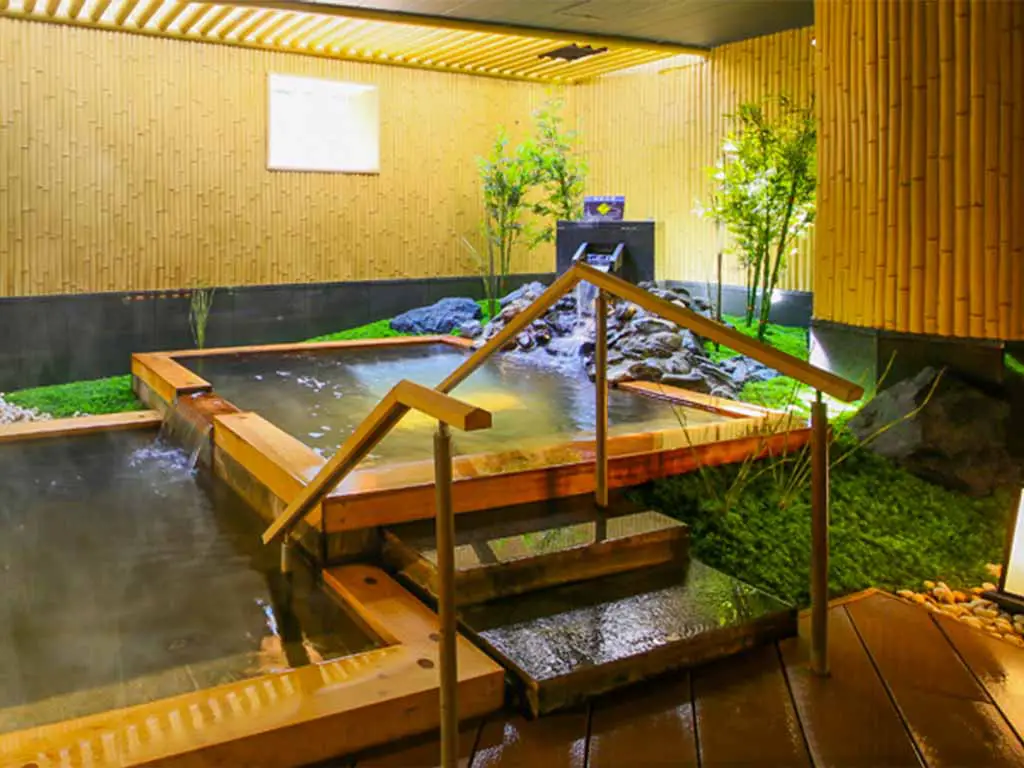
Location: Shiobara Onsen, Nasu-Shiobara, Tochigi Prefecture
General Information: Shiobara Onsen (塩原温泉郷) is another old onsen town with a history of 1,200 years. It is said that Shiobara’s hot springs are good for the skin and that they have a lot of beauty effects like detoxing and anti-aging effects.
Surrounded by a dense forest and mountains you can enjoy hot springs together with rivers, waterfalls, hiking trails, and autumn leaves. The Ashiyu here is also one of the largest in Japan with a total length of 60 meters.
Also, don’t miss the rare chance and find one of the hot spring water dispensers to try the drinkable spring water.
Old Onsen Town Near Tokyo: On the hot spring resort’s official homepage it says that there are 60 onsen ryokan and 150 hot springs. The water of the springs turns into 7 different colors due to oxidation: milky white, light green, gold, gray, brown, black, and transparent.
Hotel New Shiobara (ホテルニュー塩原) is one of the Ooedo Onsen Monogatari onsen theme parks that you can visit as a day-tripper. They have really lovely onsen facilities and a variety of hot spring baths.
Another onsen with beautiful river views is Myogaya Honkan (明賀屋本館). It’s a slightly older onsen ryokan with rustic baths but right next to the river. The open-air river baths are unisex, but you can wear a towel. For Hotel New Shiobara get off at the Shiobara Hatori bus stop.
Access: My recommendation is to take the train until Nishi-Nasuno Station (Shinkansen and Utsunomiya Line) and then transfer to a bus bound for Shiobara Onsen. The bus ride takes about 40 minutes.
Website: www.siobara.or.jp
12. Nasu Onsen (2h from Tokyo)
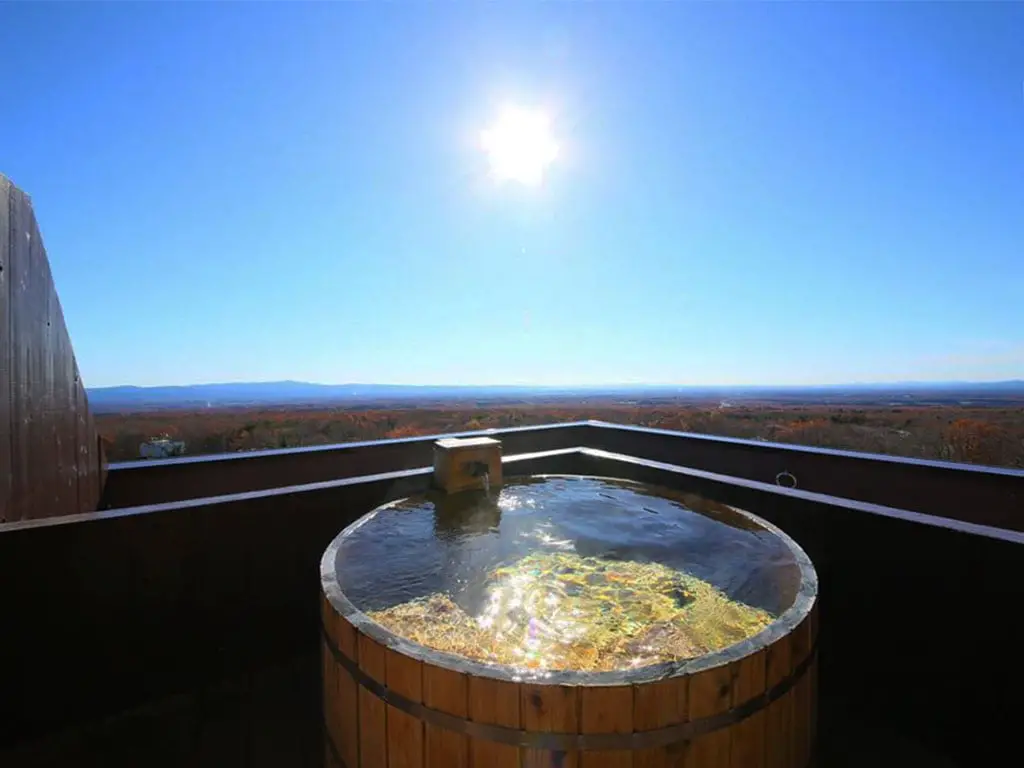
Location: Nasu Onsen, Near Shiobara Onsen, Tochigi Prefecture
General Information: Nasu Onsen (那須温泉) is another onsen town in Tochigi’s Nasu-Shiobara area. This onsen town is about 40 kilometers north of Shiobara Onsen but if you don’t have a car it takes more than 2 hours to travel from one of the hot spring towns to the other.
Nasu Onsen is very close to Natsudake, a 1,915 meters high mountain. You can either hike up or take the ropeway to the top. Another interesting attraction in Nasu Onsen is the Murder Stone which is linked to a legend of a nine-tailed fox. Does this also remind you of the anime Naruto dattebayo ?
Small Onsen Town Near Tokyo: Nasu Onsen is a little bit smaller than Shiobara Onsen. I know that the family-friendly onsen Hotel Epinard Nasu (ホテルエピナール那須) has a beautiful outdoor bath with a waterfall and welcomes day-trippers.
Nasu Ichiya Hotel (那須いちやホテル) is another great hotel with a wooden tub bath on the rooftop that offers spectacular views over the mountainous area.
One of my students recommended me Wellness Forest Nasu (ウェルネスの森 那須) and I have to say the rustic onsen facilities look great.
Access: Take the train to Nasushiobara Station and then transfer to a local bus bound for the Nasu Ropeway. From Tokyo Station, you can get to the onsen town in about 2 h 12 min.
13. Shimoda Hot Springs (3h from Tokyo)
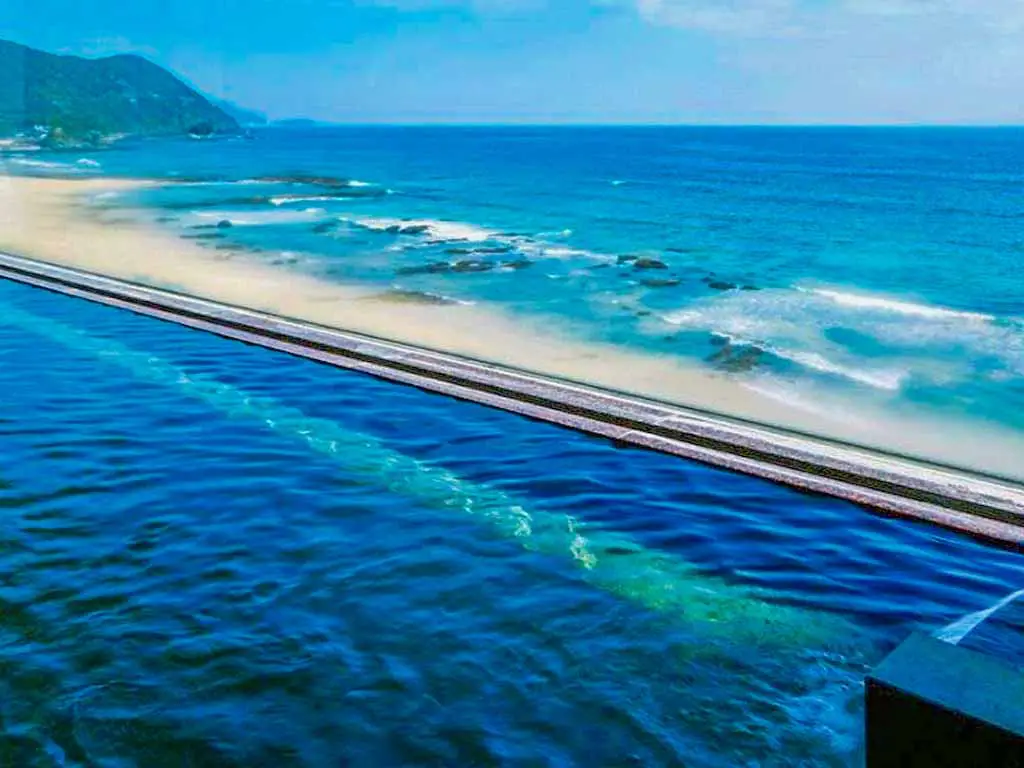
Location: Shimoda, Izu Peninsula, Shizuoka Prefecture
General Information: When you check out Shimoda Onsen (下田温泉) be careful not to confuse it with Shimoda Onsen in Kumamoto. Shizuoka’s Shimoda Onsen is located at the south tip of the Izu Peninsula. Just like Ito Onsen and Atami Onsen but way further south. Shimoda is a good base for the nearby Kawazu Seven Waterfalls and Shirahama Beach.
Beach Onsen Town Near Tokyo : This onsen town has a little bit of a tropical feeling to it thanks to the mild climate and onsen overlooking the blue ocean and white sand beach.
Higaeri (day trip onsen visit) is possible at Shimoda Prince Hotel (下田プリンスホテル). It doesn’t look or feel like a traditional onsen but you have a beautiful view over Shirahama beach.
Shimoda Jyuraku Hotel (下田聚楽ホテル) and Kurofune Hotel (黒船ホテル) are the onsen hotels I can recommend if you want to stay overnight.
Access: Unfortunately the Japan Rail Pass is only valid until Ito. So in order to get to Shimoda, you have to pay an additional fee. There is a direct limited express train that brings you all the way to Izukyu-Shimoda in about 3 hours. Another possibility is to take the Shinkansen to Atami Station and transfer to the limited express train or the Ito Line. This is less convenient but about 20 minutes faster
14. Manza Onsen (4h from Tokyo)

Location: Manza Onsen, Joshinetsukogen National Park, Gunma Prefecture
General Information: I was a little bit torn to put Manza Onsen (万座温泉) on this list because it takes way longer to get there from Tokyo than the other onsen towns. But then again it has one of the most beautiful open-air snow onsens near Tokyo .
Manza Onsen is famous for having the most sulfuric hot spring water in Japan and it is renowned for the quality and health benefits of its springs. If you are into skiing or snowboarding or want to soak in an onsen with snow around you this is the place to go near Tokyo.
Snow Onsen Town Near Tokyo: There aren’t too many hot spring inns in Manza Onsen, but they are some of the best in Japan.
Nisshin Kan (日進舘) is always my first choice. It has 8 different outdoor and indoor baths and you could also soak in a private onsen.
However, Manza Prince Hotel (万座プリンスホテル), Manza Kogen Hotel (万座高原ホテル), and Manza Tei Hotel (万座亭) are at least as good. So try to soak in as many as you can.
Access: Taking the Shinkansen to Karuizawa and then transferring to a bus to Manza Onsen is the fastest way (3.5 hours), but the bus ride isn’t covered by the JR Pass. With a JR Pass, it is cheaper to take the train all the way to Manza-Kazawaguchi, the nearest station, and continue by bus from there. That will shorten the nearly 2-hour bus ride to a 45-minute one.
More Beautiful Onsen Towns in Japan
Onsen Towns Near Kyoto & Osaka : Read more about Kinosaki Onsen, Japan’s most picturesque onsen town. Arima Onsen and Shirahama Onsen, are two of Japan’s most ancient hot spring towns. I will also introduce a few great onsen towns that are just 1 hour away from Kyoto or Osaka.
Onsen Towns in Hokkaido : Here you can soak in hot springs next to the Hell Valley and snow onsens right next to ski slopes with tons of powder snow. In Hokkaido, you will also find some of the most beautiful and mysterious crater lake hot springs in all of Japan.
Hey. I'm Alex. I've been living in Japan since 2015. Before moving to Tokyo, I traveled through Japan for 7 months to visit all 47 prefectures. Traveling and living in Japan has been so much fun and such an incredible experience that I decided to write about it. Hopefully, my articles help you to get the most out of your trip and to fully enjoy your time in Japan! Feel for free follow me on Twitter and/or Instagram .
Recent Posts
All About Meiji Jingu: What to See & Do, Hours, Fee, Access
Meiji Jingu (明治神宮), also known as Meiji Shrine, is a famous Shinto shrine in Tokyo that is surrounded by a large evergreen sacred forest and known for its beautiful wooden architecture. It is...
How Much is an Onsen in Japan? 15 Examples from 100円 ($1,1€)
Before you are actually planning a trip to a hot spring you might be wondering how much it costs to visit an onsen in Japan. Luckily, there are a lot of awesome but affordable hot springs and...

10 Best Spots for Onsen Day Trips from Tokyo
www.travel.co.jp
Tokyo is an exciting and popular tourist destination, but sometimes you want a break from the hustle and bustle of Japan's iconic metropolis. On days like that, why not take a short trip out of Tokyo to the nearby prefectures and experience a traditional, luxurious part of Japanese culture?
10. The grand nature of Oku Nikko Hot Spring

http://www.travel.co.jp/guide/photo/11546/1/
The Oku Nikko Hot Spring is one that has been serving people for a very long time – it has a history of over 1,200 years. Oku Nikko is hence one of the most popular hot spring destinations in Japan, and it can be visited from Tokyo in less than 3 hours! One of the recommended places to enjoy the Oku Nikko Hot Spring is Spa Village Kamaya. This affordable hotel is extremely popular among tourists and families. Many hot spring sites usually mix water with the natural hot spring for reasons like temperature regulation, but the hot spring at Spa Village Kamaya is 100% natural. The water is hence very rich in minerals and is said to provide healing abilities for a myriad of health issues. The open air hot spring at Spa Village Kamaya offers great views of the lush nature of the area. Not only that, Spa Village Kayama is well-known for fantastic Japanese style meals. Fresh seafood and local vegetables are provided in the full-course meal, and this is definitely a place worth checking-out when planning a day-trip from Tokyo!
9. The historical city Ikaho in Gunma
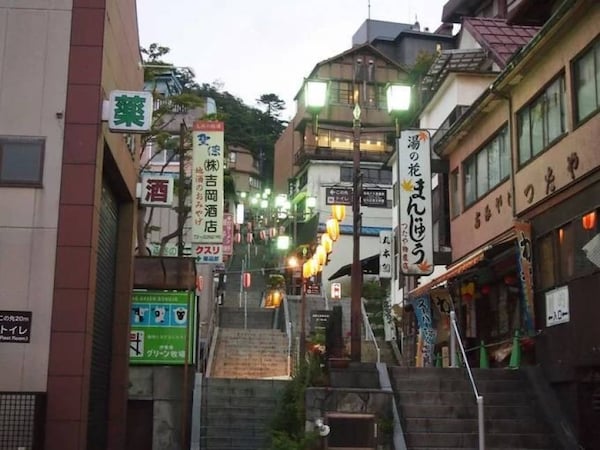
https://www.travel.co.jp/guide/article/1286/
Ikaho is about 2 hours from Tokyo by car and is a hot spring town with over 400 years of history. The first icon that will greet you when you reach Ikaho is the “stairs of Ikaho”, a flight of 365 stairs that have been around since the beginning of Ikaho (of course, with many renovations in between, so don’t worry about safety) that will bring you up to the town centre. The retro town centre is filled with a variety of shops selling souvenirs and great local food. The hot spring at Ikaho can be enjoyed at many of the facilities within the town. There are two types of natural hot springs in Ikaho, the “golden onsen” and the “silver onsen”. The former contains iron particles and is golden in color, while the latter doesn’t, and they are both said to provide different healing properties. Do check out the different facilities in the town to enjoy both types of hot spring!
8. The multi-purpose facility of Akazawa Hot Spring in Ito, Shizuoka
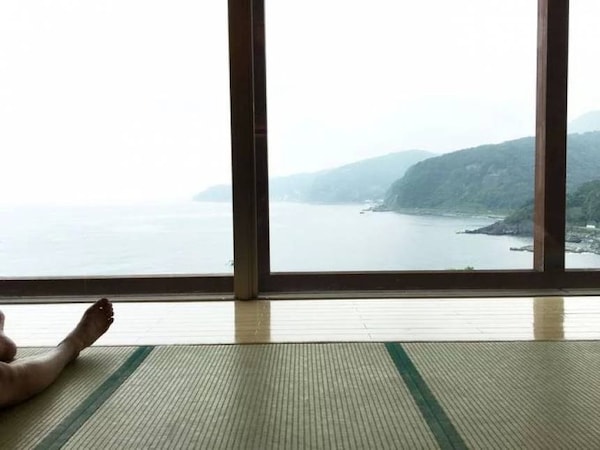
https://www.travel.co.jp/guide/article/20334/
Just 3 hours from Tokyo is the DHC Akazawa Onsen Kyo. Unlike other hot springs, this place is run by DHC, a resort company, and a trip to Akazawa will not only be about the natural hot springs there! DHC Akazawa Onsen Kyo is a multi-purpose resort with a wide array of facilities including fitness clubs and swimming pools. There are also tennis courts and bowling alleys available. The hot spring here is named the “Infinity Onsen”, and it offers a magnificent view of the ocean and mountain surrounding the area. Panoramic scenery can be enjoyed from the hot spring and this is certainly a fantastic place to spend a day away from Tokyo.

This website uses cookies.
STARS AND STRIPES
- Middle East
- Asia-Pacific
- Map Of Memorials
- Entertainment
- - Video Games
- Europe Travel
- - Quick Trips
- - After Hours
- Pacific Travel
- The Meat and Potatoes of Life
- U.S. Travel
- Storm Tracker
- Rewards for readers
- Get Stripes
- Stripes Lite
- Archives/Library
- Special Publications
- Mobile Apps
- Email Newsletters
- Digital Access
- Home Delivery
- Marine Corps
- Coast Guard
- Space Force
- Archive Photo Of The Day
- - Military Matters
- - Force For Hire
- Out of Uniform
- Communities
- Stripes Europe
- Stripes Guam
- Stripes Japan
- Stripes Korea
- Stripes Okinawa
- Our Other Websites
- In Memoriam
- Month of the Military Child
- Best of Germany
- Best of the Pacific
- Letters to Santa
10 best onsen towns near Tokyo for perfect hot springs escape
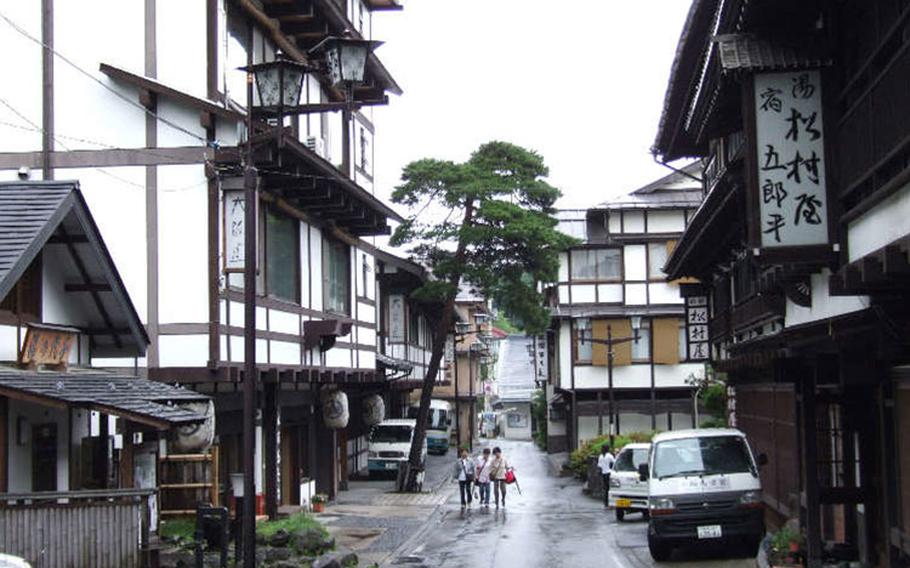
Hot springs near Tokyo offer the perfect retreat to warm up during the cooler months, as Japan boasts an array of such soothing destinations. Fortunately, there are numerous onsen towns in proximity to Tokyo, allowing you to relax and rejuvenate in mineral-rich waters.
Here, we'll present ten of the best onsen near Tokyo, all of which are easily accessible by train or bus. Utilize our recommendations, which delve into the unique features and benefits of each hot spring , to curate your ideal winter escape in Japan.
1. Kusatsu Onsen (Gunma): Famous as one of Japan's Top Three hot springs areas
Kusatsu Onsen is a charming hot spring town located in the Agatsuma district of Gunma Prefecture in the Kanto region. It is well-known for its Yubatake, a hot water field that is the town's centerpiece and helps to adjust the temperature of the hot spring water for bathing.
Kusatsu Onsen is also considered one of Japan's top three hot springs , alongside Arima Onsen in Hyogo Prefecture and Gero Onsen in Gifu Prefecture.
The hot spring water at Kusatsu Onsen is very hot, around 55 degrees Celsius, and is believed to offer numerous health benefits.
Visitors can purchase "Yunohana," the sediment that is extracted from the Yubatake, which is highly concentrated in hot spring minerals and is sold as a bathing agent. Additionally, visitors can enjoy the "yumomi" show , where the hot spring water is stirred to cool it down, and watch the beautiful illumination of the Yubatake at night.
About Kusatsu Onsen
Kusatsu Onsen boasts the highest natural hot spring water output in Japan. More than 32,300 liters of hot spring water gushes out every minute. The water's quality is highly acidic, which contributes to its potent sterilizing properties.
Size of spa resort area
There are over 100 hotels and hot spring inns in Kusatsu Onsen , with a concentration of souvenir shops and restaurants around the Yubatake area.
Getting there
To reach Kusatsu Onsen from JR Ueno Station, take the "Tokkyu Kusatsu" limited express train to Nagano-Kusatsuguchi Station, then transfer to a JR bus and disembark at the "Kusatsu" stop. This journey takes approximately three hours.
Spring qualities and benefits
Cuts and burns, neuralgia, bruises, diabetes, hypertension, etc.
Main hotels in the area
Kusatsu Onsen Nagataya, Kusatsu Hotel , Kusatsu Onsen Ozu no Koyado Hanaingen
Kusatsu Onsen Eidaya 草津温泉 永田屋 Address: Kusatsu 464-285, Kusatsu, Gunma, 377-1711 View Map Nearest Station: Haneo Station (JR Agatsuma Line)
Kusatsu Onsen Kusatsu Hotel 1913 草津温泉 草津ホテル 1913 Address: Kusatsu 479, Kusatsu, Gunma, 377-1711 View Map Nearest Station: Haneo Station (JR Agatsuma Line)
Hanaingen 草津温泉 お豆の小宿 花いんげん Address: 92, Kusatsu, Gunma, 377-1711 View Map Nearest Station: Haneo Station (JR Agatsuma Line)
2. Ikaho Onsen (Gunma): A town of stone steps and hot spring manju sweets
Image Courtesy of Gugutto Gunma Photo Gallery
Ikaho Onsen is a delightful hot spring town located in Gunma Prefecture that has been thriving since ancient times. Records dating back over 600 years reveal the existence of hot springs in the area. The heart of the town is a flight of 365 stone steps, and as you make your way up, you'll find souvenir shops , restaurants, and game centers, making it a fun and lively destination.
One must-try treat in Ikaho Onsen is the famous "Yunohana Manju," a classic souvenir of Japanese hot spring towns that is said to have originated here. These unique treats have a brown outer layer and a taste that is hard to forget. Be sure to grab some before you leave!
About Ikaho Onsen
Features There are two types of hot springs in Kusatsu Onsen : the "Golden Water" and the "Silver Water." The Golden Water turns a brownish color due to oxidized iron content, while the Silver Water is clear and colorless, hence the name.
Size of spa resort area There are around 50 lodging facilities affiliated with the Ikaho Onsen Ryokan Cooperative. Visitors can purchase souvenirs at the shops along the stone steps, and there are also nearby museums and art galleries to explore.
Getting there The "Tokkyu Kusatsu " limited express train from JR Ueno Station takes about 1 hour and 30-40 minutes to reach Shibukawa Station.
Spring qualities and benefits Golden Water: Neuralgia, skin diseases, high blood pressure, etc. Silver Water: Recovery from illness and fatigue, health promotion, etc.
Main hotels in the area Oyado Tamaki, Kishigon Ryokan , Kaichoro
Oyado Tamaki お宿玉樹 Address: Ikaho 87-2, Shibukawa, Gunma, 377-0102 View Map Nearest Station: Ubashima Station (JR Agatsuma Line)
Kishigon Ryokan 岸権旅館 Address: Ikahomachi, Ikaho 48, Shibukawa, Gunma, 377-0102 View Map Nearest Station: Ubashima Station (JR Agatsuma Line)
3. Manza Onsen (Gunma): Hot springs located in a national park near a popular ski resort
Images Courtesy of Gugutto Gunma Photo Gallery
Manza Onsen is a cute hot spring located in Tsumagoi Village , Agatsuma District, Gunma Prefecture , within the Joshinetsu Kogen National Park . With a rich history dating back 400 years, it's been a go-to spot for many people seeking the healing properties of the hot springs .
Whether you visit in spring to take in the fresh greenery or in fall to enjoy the beautiful autumn leaves, you're sure to enjoy the natural scenery in all four seasons . At an altitude of 1,800 meters, it's also a popular summer resort to escape the heat. And during winter , it's recommended to combine your hot spring experience with a visit to the nearby Manza Onsen Ski Resort for some fun in the snow. Plus, with its convenient location near Karuizawa, you won't have any trouble finding shopping opportunities.
About Manza Onsen
Manza Onsen is known for its abundant hot spring water, with a daily output of approximately 5.4 million liters. It is said to have over 20 types of hot spring sources, making it a unique and diverse onsen near Tokyo.
There are around nine hotels near the Joshinetsu Kogen National Park , which are designed with skiers in mind. These hotels are conveniently located near Manza Onsen and offer a range of facilities.
To get to Manza Onsen from Tokyo, you can take the Hokuriku Shinkansen to Karuizawa and then take a bus to the onsen , which takes about 2 hours and 45 minutes.
Sulfur spring . Beneficial for respiratory disease, gastrointestinal disease, rheumatism, skin disease, etc.
Manza Kogen Hotel , Manza Prince Hotel
Manza Kogen Hotel 万座高原ホテル Address: Hoshimata 2401, Tsumagoi, Gunma, 377-1595 View Map Nearest Station: Fukurogura Station (JR Agatsuma Line)
Manza Prince Hotel 万座プリンスホテル Address: Manzaonsen, Tsumagoi, Gunma, 377-1595 View Map Nearest Station: Fukurogura Station (JR Agatsuma Line)
4. Shima Onsen (Gunma): These hot springs are believed to have healing powers
Shima Onsen is a fascinating hot spring with an interesting legend behind its name. The Chinese characters "四万" mean "40,000," and according to the legend, bathing in the hot springs can cure all 40,000 known illnesses. Who wouldn't want to give that a try?
Aside from the beautifying effects of the hot spring water, there are several drinking fountains on the premises where visitors can enjoy the health benefits of the water, which is said to be good for the stomach and gut.
The Sekizenkan Ryokan located within Shima Onsen is also rumored to have inspired the bathhouse in the Ghibli movie Spirited Away, adding to the onsen 's unique charm. With a free foot bath and communal bathhouse, it's easy for visitors to enjoy the hot springs , even if they're only there for the day. And don't forget to take a leisurely stroll by the nearby clear streams and waterfalls to enjoy nature while visiting these hot springs near Tokyo.
About Shima Onsen
Features Shima Onsen features sodium-calcium-chloride-sulfate hot spring waters. Of the 42 hot spring sources in the area, approximately 39 of them are natural springs.
Size of spa resort area In the hot springs town, there is a concentration of restaurants and souvenir shops for visitors to enjoy.
Getting there From Tokyo Station , visitors can take the Shima Onsen bus for approximately 3.5 hours to reach Shima Onsen, or take the Kusatsu Limited Express from JR Ueno Station to JR Nakanojo Station and transfer to a bus bound for Shima Onsen for about 3 hours to reach the final destination.
Spring qualities and benefits Bathing in the hot spring s is said to be effective for gastrointestinal disease, neuralgia, skin disease, scratches, cuts, and atopic dermatitis. Drinking the hot spring water is said to be effective for gastrointestinal disease and increasing appetite.
Main hotels in the area Sekizenkan Kashotei Sanso, Shima - Onsen Toshimaya, Shima Onsen Kashiwaya Ryokan
Sekizenkan Kashotei Sanso 積善館 佳松亭・山荘 Address: Shima Ko 4236, Nakanojo, Gunma, 377-0601 View Map Nearest Station: Nakanojo Station (JR Agatsuma Line)
Shima-Onsen Toshimaya Address: Shima 3887, Nakanojo, Gunma, 377-0601 View Map Nearest Station: Nakanojo Station (JR Agatsuma Line)
Shima Onsen Kashiwaya Ryokan 四万温泉 柏屋旅館 Address: Shima 3829, Nakanojo, Gunma, 377-0601 View Map Nearest Station: Nakanojo Station (JR Agatsuma Line)
5. Nasu Onsen (Tochigi): A leading hot spring resort near Tokyo
Nasu Onsen Resort is a group of amazing hot springs situated in the area surrounding Mt. Chausu, the only active volcano in Tochigi Prefecture . The resort includes 11 different hot springs, with Nasu Onsen (also known as "Kanoyu") being the most well-known, having been discovered in 630 AD.
The area is also called "Nasu Jikkyu-yu" or "Nasu Eleven Hot Springs ," and one of the hot springs within the Nasu Onsen Resort is Kitayu, which is known for its unique tengu masks and has even been featured in movies.
In addition to the hot springs , Mt. Chausu is known for its season al flowers and is an excellent hiking destination outside of the snowy season. For families, the area also offers many theme parks , such as Nasu Safari Park and Nangaku Ranch, making it a perfect spot for a day trip.
About Nasu Onsen
Features The source temperature of the hot spring s ranges from 63 to 80 degrees Celsius, making them high-temperature hot springs. The most famous Nasu Onsen , Kanoyu, is a sulfur hot spring, while Omaru Onsen, located at an altitude of 1,300 meters, is a simple hot spring. The quality of the hot springs varies depending on the location of the hot spring resort.
Size of spa resort area If you're looking to dine out, there are plenty of restaurants near the hotels and theme parks . For souvenirs, you can find them at roadside stations or large commercial facilities.
Getting there From Tokyo Station , visitors can take the Tohoku Shinkansen to Nasu-Shiobara Station and then take a bus to Nasu Onsen for about 2 hours and 15 minutes.
Spring qualities and benefits Sulfur hot spring s , such as Kanoyu, are believed to be effective for skin disease, women's health issues, gastrointestinal disease, and fatigue recovery. The effects may vary depending on the hot spring.
Main hotels in the area Jizaiso, Resort Hotel Laforet Nasu, Hotel Epinard Nasu
Jizaiso こころのおやど 自在荘 Address: Yumoto 206-98, Nasu, Tochigi, 325-0301 View Map Nearest Station: Kurodahara Station (JR Tohoku Main Line)
Resort Hotel Laforet Nasu リゾートホテル ラフォーレ那須 Address: Yumoto 206-959, Nasu, Tochigi, 325-0301 View Map Nearest Station: Kurodahara Station (JR Tohoku Main Line)
Hotel Epinard Nasu ホテルエピナール那須 Address: Takakuhei 1, Nasu, Tochigi, 325-0302 View Map Nearest Station: Takaku Station (JR Tohoku Main Line)
6. Kinugawa Onsen (Tochigi): Scenic hot spring resort near Tokyo particularly beautiful during the autumn foliage season
Kinugawa Onsen is a delightful hot spring resort nestled along the Kinugawa River in Tochigi Prefecture . Located in a mountainous hot spring town, visitors can unwind and take in the fresh air and serene atmosphere.
The Kinugawa River is famous for its rapids and rocky cliffs, making it an ideal spot for river rafting. And when combined with a hot spring experience, especially during the autumn foliage season when the area is particularly stunning, it's truly an unforgettable experience.
The area also offers a wealth of nearby attractions, including the Nikko Toshogu Shrine , Edo Wonderland , Tobu World Square, and the popular SL Taiju steam train that runs between Shimotsuma Station and Kinugawa Onsen Station. With so much to see and do, you'll never get bored in this amazing hot spring town.
About Kinugawa Onsen
Features The hot springs are odorless and tasteless, making them easy for children and the elderly to enter. The water is gentle on the skin and does not have a distinct flavor, making it easy to enjoy.
Size of spa resort area There are 28 lodging facilities that belong to the Kinugawa and Kusatsu Onsen Ryokan Cooperative Association, and souvenir shops and restaurants are clustered in the hot spring town near Kinugawa Onsen Station.
Getting there From JR Shinjuku Station, visitors can take the JR/Tobu through express train, or from Tobu Asakusa Station, they can take the Tobu Spacia train to Kinugawa Onsen Station, which takes about 2 hours.
Spring qualities and benefits Alkaline simple hot springs are believed to be effective for various health conditions such as neuralgia, stiff shoulders, fatigue recovery, and overall health improvement.
Main hotels in the area Tsuganoki, Monogusa no Yado Hanasenkyo, Ooedo- Onsen Monogatari Kinugawa Kanko Hotel
Monogusa no Yado Hanasenkyo ものぐさの宿 花千郷 Address: Kinugawa Onsen Taki 482-6, Nikko, Tochigi, 321-2526 View Map Nearest Station: Kinugawa-Onsen Station (Tobu Kinugawa Line), 18 minutes on foot
Ooedo-Onsen Monogatari Kinugawa Kanko Hotel 大江戸温泉物語 鬼怒川温泉 鬼怒川観光ホテル Address: 359-2 Kinugawa Onsentaki , Nikko, Tochigi, 321-2526 View Map Nearest Station: Kinugawa-Onsen Station (Tobu Kinugawa Line), 16 minutes on foot
7. Hakone Onsen (Kanagawa): Relax in a hot spring with Mt. Fuji views!
Hakone Onsen is a group of fantastic hot spring resorts located in the Hakone area of Kanagawa Prefecture . These 20 hot springs are the result of the thermal activity of the Hakone volcano. Two of the most famous hot springs are Hakone Yumoto, which is also a stop on the Odakyu Romancecar from Tokyo, and Ōwakudani within the national park .
One of the biggest draws of Hakone Onsen is the opportunity to soak in an outdoor bath while taking in the breathtaking views of Mount Fuji . It's no wonder that this area is a popular hot spring destination within Japan, with the highest number of annual visitors.
With so much to explore and enjoy in this beautiful area, it's no surprise that Hakone Onsen is a must-visit spot for anyone looking to experience the natural beauty and rejuvenating power of Japanese hot springs .
About Hakone Onsen
Features This is the largest hot spring resort in Kanagawa Prefecture , with a discharge rate of about 19,500 liters per minute. Due to the complex geological features of the hot spring source, the 20 hot spring resorts have varying spring qualities.
Near the Hakone Yumoto Station, the gateway to the Hakone hot spring resort, there is a shopping street with a variety of restaurants and souvenir shops .
From Odakyu Shinjuku Station, take the Odakyu Romancecar to Hakone Yumoto Station, which takes approximately 1 hour and 25 minutes.
Sodium chloride springs can provide relief from ailments such as sensitivity to cold, stiff shoulders, and lower back pain at Hakone Yumoto Onsen , while other hot springs offer different types of benefits.
Tsukino Yado Sara, Hotel Zagakukan, Hakone Yumoto Onsen Hotel Kajikaso
Tsukino Yado Sara 箱根湯本温泉 月の宿 紗ら Address: 588-1, Hakone, Kanagawa, 250-0311 View Map Nearest Station: Hakone-Yumoto Station (Hakone Tozan Railway), 11 minutes on foot
Hotel Zagakukan 坐樂閑 Address: Yumoto 642-1, Hakone, Kanagawa, 250-0311 View Map Nearest Station: Hakone-Yumoto Station (Hakone Tozan Railway), 7 minutes on foot
Hakone Yumoto Onsen Hotel Kajikaso 箱根湯本温泉 ホテル河鹿荘 Address: Yumoto 688, Hakone, Kanagawa, 250-0311 View Map Nearest Station: Hakone-Yumoto Station (Hakone Tozan Railway), 6 minutes on foot
8. Yugawara Onsen (Kanagawa): A therapeutic spring that has been beloved by cultural figures
Yugawara Onsen is a fantastic hot spring resort located in the southwest of Kanagawa Prefecture . With 109 hot springs , each with its own unique water quality, including chloride springs, simple springs, and sulfuric acid springs, it's a treasure trove of "medical treatment springs" that are believed to be good for healing and recuperation.
The water quality, combined with the opportunity to enjoy both the sea and mountain scenery, has attracted many cultural figures, such as painters and novelists, who visited for therapeutic purposes.
If you're looking for souvenirs, be sure to check out the citrus fruit cultivation in the nearby area. Many souvenirs featuring oranges are sold in the hot spring town, making it a great spot to pick up a unique and tasty memento.
Whether you're seeking relaxation, rejuvenation, or just a fun getaway from Tokyo, Yugawara Onsen is definitely worth checking out. With so many hot springs to choose from, you're sure to find the perfect one for you.
About Yugawara Onsen
Features The main spring quality, which is the saline spring, is said to have an excellent heat retention effect that prevents the body from getting cold. Some of the springs are known as "wound healing springs" and are reputed to be effective in recovering from bruises, wounds, and post-surgical recovery.
Size of spa resort area There are many souvenir shops and restaurants concentrated around Yugawara Station. Additionally, souvenirs can also be purchased at roadside stations and along the coast.
Getting there It takes about 34 minutes from Tokyo Station by the Shinkansen (Kodama).
Spring qualities and benefits This type of hot spring is characterized by its chloride and sulfate content, and is said to be effective for conditions such as poor circulation, bruises, and recovery after injuries or surgery.
Main hotels in the area Yugawara Retreat Goen no Mori, Yugawara Onsen Ryokan Uohan
Yugawara Retreat Goen no Mori 湯河原リトリート ご縁の杜 Address: Doi 5-4-6, Yugawara, Kanagawa, 259-0303 View Map Nearest Station: Yugawara Station (JR Tokaido Main Line / JR Ueno Tokyo Line), 5 minutes on foot
9. Atami Onsen (Shizuoka): A refreshing hot spring town facing the sea
Atami Onsen is a wonderful hot spring resort town located on the eastern edge of the Izu Peninsula in Shizuoka Prefecture . It's a fantastic spot to relax and enjoy the healing properties of the hot springs , making it a popular getaway from Tokyo.
One unique feature of Atami Onsen is the Atami Sun Beach, which is lined with palm trees and offers a tropical atmosphere. It's hard not to feel relaxed and refreshed here! Atami Onsen has a rich history that dates back to 713 when it was discovered. Over the years, many Japanese royalty, samurai warriors, and cultural figures built villas in the area.
Thanks to its warm climate, Atami experiences an early arrival of spring , and visitors can enjoy the plum blossoms and Atami cherry blossoms as early as late January. And for those who love fireworks, Atami is famous for its long-lasting fireworks festivals held from April to December. There's always something happening in this amazing hot spring town near Tokyo!
About Atami Onsen
Atami boasts a total output of approximately 16,600 liters per minute and a large amount of hot water. The water is characterized by its lack of smell and colorless transparency. It is said that there are many sulfuric acid springs along the mountains and chloride springs along the coast.
There are nearly 300 ryokans and hotels in the city of Atami . Souvenir shops and restaurants are located in the shopping district in front of Atami Station.
It takes about 45 minutes by the Tokaido Shinkansen (Kodama) from Tokyo.
Sulfate spring : effective for arteriosclerosis, cuts, burns, chronic skin diseases, etc.
Chloride spring : effective for cuts, burns, chronic skin diseases, chronic women's diseases, etc.
Uminohana, Shin Kadoya, Fufu Atami
Uminohana 時間を旅する宿 海のはな Address: Shimotaga 37-9, Atami, Shizuoka, 413-0102 View Map Nearest Station: Ajiro Station (JR Ito Line / JR Ueno Tokyo Line), 15 minutes on foot
Shin Kadoya 新かどや Address: Koarashi 14-8, Atami, Shizuoka, 413-0029 View Map Nearest Station: Kinomiya Station (JR Ito Line / JR Ueno Tokyo Line), 11 minutes on foot
Fufu Atami ふふ 熱海 Address: Minaguchi-cho 11-48 , Atami, Shizuoka, 413-0016 View Map Nearest Station: Kinomiya Station (JR Ito Line / JR Ueno Tokyo Line), 5 minutes on foot
10. Chichibu Onsen (Saitama): Saitama's premier hot spring resort with stunning views
Chichibu is a wonderful destination located in the southwest part of Saitama Prefecture that's known for its seasonal scenic views, including Shibazakura (pink moss phlox) and breathtaking Ashigakubo-no-Hyochu ice columns , as well as its hot spring s . What could be better than taking in breathtaking views while enjoying the healing powers of a hot spring?
Most of the hot springs in Chichibu are day-use facilities, making them perfect for visitors on a sightseeing trip. Plus, the alkaline hot springs are said to be great for the skin, leaving you feeling rejuvenated and refreshed.
One onsen complex that you won't want to miss is " Matsuri -no-Yu," located in front of Seibu Chichibu Station. It's a unique place that not only features hot springs but also a food court and retail space. You'll get to experience the festive atmosphere of Chichibu's festivals while enjoying the hot springs. It's truly an unforgettable experience!
About Chichibu Onsen
The water has a strong alkaline level of about pH 9-10, rich in hydrogen ions.
The area around Chichibu Station is crowded with souvenir shops and restaurants, and there are also many restaurants in the nearby Nagatoro Town.
It takes about 1 hour and 20 minutes from Seibu Ikebukuro Station.
Sulfuric simple springs are said to be effective for neuralgia, fatigue recovery, chronic skin diseases, health promotion, diabetes, and beautiful skin (Manganoyu). However, it varies depending on the type of hot spring .
NIPPONIA Chichibu Monzenmachi, KAMENOI HOTEL Nagatoro Yorii, Comfort stay Miyabi
KAMENOI HOTEL Nagatoro Yorii 亀の井ホテル 長瀞寄居 Address: Sueno 2267, Yorii, Saitama, 369-1205 View Map Nearest Station: Hagure Station (Chichibu Railway), 13 minutes on foot
Comfort stay Miyabi みやび Address: Kumaki 24-14-B, Chichibu, Saitama, 368-0032 View Map Nearest Station: Ohanabatake Station (Chichibu Railway), 8 minutes on foot
There are many fantastic onsen towns in the greater Tokyo region. That's right! You don't have to go far to experience the natural beauty and rejuvenating power of Japanese hot springs . Gunma, Tochigi, and Kanagawa prefectures all have amazing hot springs that are easily accessible by train or bus from Tokyo.
One of the best things about these hot springs is the opportunity to take a break from the hustle and bustle of the city and relax in the beautiful natural scenery. It's a great way to recharge and refresh yourself!
Note: The information in this article is current as of February 2023. Please check official websites and other sources for the latest information.
Via Live Japan
related stories
- Did you know?: Japanese public baths Onsen and Sento
- Helpful tips for foreigners visiting a Japanese onsen
- Learn basic etiquette of Japan's onsen culture
- Bathing in Japan: Difference between sento and onsen
The best stories from the Pacific, in your inbox
Sign up for our weekly newsletter of articles from Japan, Korea, Guam, and Okinawa with travel tips, restaurant reviews, recipes, community and event news, and more.
Sign Up Now
- 100% tailor made
- 100% value guarantee
- Expert consultant
- Ground support
- No hidden cost
- Why Tailor-made Travel ?
- Our Promise
- Responsible tourism
- Best & Reasonable Price

- Thailand and Vietnam
- Thailand and Cambodia
- Thailand Vientam Cambodia
- Vietnam and Cambodia
- Southeast Asia Tours
- Japan Tours
- Japan Family Tours
- Japan Senior Tours
- Japan Food Tours
- Japan Autumn Tours
- Japan Nature Tours
- Japan Walking&Hiking Tour
- Custom Japan Honeymoon
- China Tours
- China Guides
- Thailand Tours
- Thailand Guides
- Vietnam Tours
- Vietnam Guides
- Cambodia Tours
- Cambodia Guides
- Indonesia Tours
- Philippines Tours
- Tailor-Made Trip
- expert consultant
- ground support
- no hidden cost
- Japan Travel Guide
Tokyo Onsen Guide: The Best Hot Springs In and Near Tokyo
Are there onsens in Tokyo? Tokyo Onsen , or Tokyo Hot Springs , may not be as famous as other hot springs such as Beppu Onsen and Ginzan Onsen among all the Onsen Japan , there are also excellent hot springs worth visiting during your trip to Tokyo. If you visit neighboring hot spring areas such as Hakone and Nikko, you can enjoy also delicious Japanese food in Japanese-style buildings and explore the best onsen village near Tokyo. Here is the ultimate guide to the best onsen in Tokyo, the popular onsen town near Tokyo, Tokyo hotel with onsen, tattoo friendly onsens Tokyo, and a transportation guide to the onsen city near Tokyo.
Table of Contents
1. 10 Best Onsens in Tokyo
2. Top 8 Onsen Towns Near Tokyo
3. Tattoo Friendly Onsen in Tokyo
4. Recommended Tokyo Onsen Ryokan
5. Transportation Guide to Onsen Town Near Tokyo
1. 10 Best Hot Springs in Tokyo
There are so many best places in Japan for onsen , does Tokyo have good onsen? Tokyo is a vibrant and modern city in Japan, but it's also a place with an abundance of hot springs. Here are some great places to soak in hot springs in and around the Tokyo city area, enjoying the Tokyo private onsen.
●Spa LaQua: Enjoy the Best Natural Hot Spring in Tokyo
LaQua Spa is not a hot spring facility, but more specifically a spa where you can experience onsen Tokyo. It is located on the 5th to 9th floors of the LaQua building in TOKYO DOME CITY. Spa Laqua Tokyo is surrounded by various railroad routes, making it very convenient for travelers to depart from Tokyo Station or Shinjuku. The Spa LaQua uses natural hot spring water, "Sodium Salt Spring", which gushes out of the ground under TOKYO DOME CITY, and is good for sore shoulders and necks, cold hands and feet, and fatigue recovery. In addition, this hot springs Tokyo has excellent moisturizing and heat preservation properties, so it is a good place to go for beauty treatments.
Address: 1 Chome-1-1 Kasuga, Bunkyo City, Tokyo 112-0003, Japan
Hours: Closed at 9:00 AM
Phone: +81 3-3817-4173
● Thermae Yu Shinjuku Tokyo: Experience the Super Public Bath in This Natural Hot Springs
Newly opened in August 2015, Thermae Yu is located in the Shinjuku Ward, which is the next street from Kabukicho. In the hustle and bustle of Shinjuku, a place that never sleeps, Thermae-Yu is exceptionally peaceful. The spacious bath in the Thermae Yu Shinjuku is filled with highly concentrated bubbling carbonated spring water, which is known for its beauty-enhancing properties. Since this is a newer onsen Shinjuku Tokyo, the environment and facilities from indoor to outdoor, from changing rooms to relaxation rooms are all new and clean in the Thermae Yu Tokyo.
Address: 1 Chome-1-2 Kabukicho, Shinjuku City, Tokyo 160-0021, Japan
Hours: Open 24 hours
Phone: +81 3-5285-1726
● Times SPA RESTA: A Spa in Tokyo Featuring Indoor and Outdoor Hot Baths
Times SPA RESTA is located in Ikebukuro, a shopping paradise, next to the famous Sunshine City Ikebukuro. It is an elegant spa club that is only an eight-minute walk from Ikebukuro Station. The well-designed spring pool on the top floor creates a high-end feel like a Western-style hotel, and this hot springs in Japan Tokyo is very popular among female office workers.
Address: Japan, 〒170-0013 Tokyo, Toshima City, Higashiikebukuro, 4 Chome−25−9 12F タイムズステーション池袋10F
Hours: Closed at 8:30 AM
Phone: +81 3-5979-8924
● Asakusa Rox Matsuri Yu: Featuring Open-air Bath with a Stunning View of Tokyo Skytree
Asakusa Rox Matsuri Yu , which is open all year round until late at night, can be reached in less than 10 minutes from the station. There are as many as hot spring baths and 3 types of saunas, so you can choose from a wide variety of options to experience hot spring in Tokyo. Best of all, the open-air hot springs of Asakusa Rox Matsuri Yu offer a great view of Tokyo's first landmark, the SKYTREE, which is one of the best views in Tokyo, with Tokyo cherry blossoms in the spring season and maple leaves in the autumn season decorated the Skytree as a stunning background.
Address: Japan, 〒111-0032 Tokyo, Taito City, Asakusa, 1 Chome-25-15 ROX 7th floor
Phone: +81 3-3845-7526
● Toshimaen Niwa No Yu: Best Onsen Day Trip from Tokyo
When it comes to the best onsen in Tokyo, how can we ignore the Toshimaen Niwa No Yu Onsen , a one-day hot spring facility located next to a quiet Japanese garden of approximately 1,200 square meters? At Toshimaen Niwa No Yu Tokyo, you can enjoy a relaxing onsen while admiring the Japanese garden with its seasonal flowers and grasses. The hot springs of Toshimaen Niwa No Yu are divided into men's area, women's area, and a mixed-gender area (with swimsuits), so you can enjoy the Japanese hot springs with friends and family. There are also 3 kinds of saunas, massages, and SPA here, which can definitely make people relax completely. After taking a bath, you can also enjoy delicious food in this best onsen in Tokyo for foreigners.
Address: 3 Chome-25-1 Koyama, Nerima City, Tokyo 176-8531, Japan
Hours: Closed at11 PM
Phone: +81 3-5984-4126
● Tokyo Somei Onsen SAKURA: Enjoy the "Beauty's Hot Spring" in Tokyo
When it comes to the best onsen in Tokyo, how can we ignore the Somei Onsen SAKURA , which is located an 8-minute walk from Sugamo Station Exit A1 and a 10-minute walk from Komagome Station Exit 3? It is a "high-end hotel" concept, where you can spend time relaxing in a calm and modern space. The natural hot spring gushes out from 1,800 meters underground at a high temperature of 48.8 degrees. Tokyo Somei Onsen SAKURA is rich in minerals. It is said that soaking in hot water will make the skin smooth, and moisturize the skin. This Japan hot springs Tokyo also is perfect for relaxing after a tiring journey.
Address: 5 Chome-4-24 Komagome, Toshima City, Tokyo 170-0003, Japan
Hours: Closed at 11:00 PM
Phone: +81 3-5907-5566
● Maenohara Onsen Sayano Yudokoro: A Tokyo Onsen with Salt Sauna and Rock Bath
Maenohara Onsen Sayano Yudokoro basically meets tourists' requirements for Tokyo hot springs. The indoor bath has a high-concentration carbonated spring, and three types of massage pools, a shower, a sitz bath, and a cold water bath. The open-air hot spring is also great, which is a courtyard-style hot spring with a relatively high water temperature and three pots of hot springs. On a good day, you can also see the stars and clouds when dipping yourself in this onsen in Japan Tokyo. There are two saunas, one of which is a sauna with salt, to offer a very unique experience. There is a rock bath on the second floor.
Address: 3 Chome-41-1 Maenocho, Itabashi City, Tokyo 174-0063, Japan
Hours: Closed at 12:00 AM
Phone: +81 3-5916-382
● Tokyo Odaiba Oedo Onsen Monogatari: One of the Best Onsens in Tokyo That Is Permanently Closed
Tokyo Odaiba Onsen Monogatari is a natural hot spring facility where you can soak in natural hot springs that are very rare in Tokyo. Its spring water comes from weakly alkaline spring water that gushes out 1,400 meters underground. It is helpful for people with cold hands and feet, muscle pain, and other symptoms. In addition, Odaiba Tokyo Oedo Onsen Monogatari also features baths such as the "kini-no-yu" that promotes blood circulation and cleans pores, and the "hot spring fish therapy" that removes old dead skin cells. In addition to soaking in hot springs, you can also choose your favorite yukata at Odaiba Oedo Onsen Monogatari, enjoy delicious food in 17 restaurants, or experience interesting games such as shuriken and ninja blowguns. Ooedo Onsen Odaiba is a place where both adults and children can enjoy themselves. Regrettably, Odaiba Tokyo Oedo Onsen is permanently closed. When there is another new Odaiba onsen in Tokyo, we will keep updating.
Address: 2 Chome-6-3 Aomi, Koto City, Tokyo 135-0064, Japan
Phone: +81 3-5500-1126
● Musashi Koyama Onsen Shimizu Yu: A Well-known Sento in Tokyo Popular among Female
Musashi koyama onsen shimizu yu is a local sento that has been in use since 1924. It is located on the west side of the center of Tokyo. It is very convenient to get from Shinagawa and Shibuya. The peculiarity here is that there are only two hot springs available. In addition to Tokyo's unique black hot spring, you can also enjoy a golden hot spring that shines with gold color. In addition, this Tokyo onsen is also equipped with rock bath facilities (extra fee needed), which is very rare in sento in Japan. This Tokyo Sento is very popular and well-known among female customers. Because this is the best sento in Tokyo, it can be quite crowded, so please keep in mind.
Address: 3 Chome-9-1 Koyama, Shinagawa City, Tokyo 142-0062, Japan
Phone: +81 3-3781-0575
● Spadium Japon: The Largest Hot Spring Paradise in the Kanto Region
How can you travel to Japan without taking a hot spring bath? But options on the best Onsens in Tokyo are limited. " Spadium Japon " is only about 30 minutes away from Ikebukuro, making it the best onsen day trip from Tokyo. There are 15 natural hot springs and 5 rock baths in Spadium Japon for everyone to enjoy. The hot spring water here is taken from the same water source as "Higashikurume Musashino Hot Spring". It is collected from an underground area between 1,200 meters and 1,500 meters. It has 37-38 degrees transparent springs, which is rare in the Kanto region. The spring water contains a large amount of bicarbonate, which has beauty and skin-beautifying ingredients. It can effectively remove exfoliation, skin keratin, and dirt. It is known as the "miracle skin-beautifying hot spring". In addition, because the concentration of ingredients is close to the human body, it is easy to absorb hot spring ingredients. The pH value is slightly alkaline at 7 to 8. The hydrogen ion index is almost the same as natural water. Therefore, it is also a hot spring suitable for children and the elderly.
Tips on Spadium Japon Tattoos: Small covered tattoos are allowed as long as they are covered and they sell tattoo seals to hide them. Large tattoos are not allowed.
Transportation: Take the Seibu Ikebukuro Line to the east exit of "Higashi-Kurume Station", change to a Seibu Bus, and get off at "Higashi-Kurume Danchi Station".
Dip yourself in the private onsen Tokyo to relieve your tiredness for the wonder time of the next day's Tokyo tour itinerary. If you head to Kyoto after you finish your Tokyo Onsen tour, a guide to the best hot springs in Kyoto will be helpful for you to experience different Onsen in Japan.
2. Top 8 Hot Springs Near Tokyo
When it comes to the "keywords" for traveling in Japan, "onsen" is a must! Don't think that all of Japan's 3,000 hot springs are far away from the city. In fact, there are several excellent hot springs not far from Tokyo, including Kusatsu Onsen, which is the top 1 famous onsen in Japan. Let's check out the best Onsen near Tokyo here.
● Kusatsu Onsen: Visiting the Yubatake and Experiencing the Yumomi Performance
Kusatsu Onsen is Japan's number one hot spring in terms of natural spring water, with a staggering 4,000 liters per minute or more of source water. The water, which gushes out from over a hundred outlets, is 100% natural and is not heated, boiled, cooled, or recycled in any way, but is piped through wooden pipes to reduce the temperature of the hot water and transported to various onsen facilities and ryokan in Kusatsu.
Yubatake is located in the center of Kusatsu Onsen Gunma Prefecture and is an enclosed source of hot spring water about the size of a soccer field, with clouds of white smoke rising from everywhere. The pungent odor that you can smell when you are standing around Yubatake is the smell of sulfur. Even though some people are not used to it, it is undeniable that it is this unique smell that creates the premium enjoyment of Kusatsu Onsen Japan. When visiting Kusatsu Onsen Gunma, be sure to experience the traditional "yumomi dance", (stirring of the hot spring water) at Kusatsu Onsen Netsunoyu, which aims to evenly mix the medicinal elements in the hot spring, lower the temperature, and increase the therapeutic effect.
How to Go to Kusatsu Onsen from Tokyo:
(1) JR Limited Express + Bus: JR Ueno Station → JR Naganohara Kusatsuguchi Station → Take the bus to Kusatsu Onsen
(2) Highway Bus: Take the bus from Shinjuku West Exit Bus Station to Kusatsu Onsen.
● Atami Onsen, Shizuoka: Take a Dip in an Island Resort-style Seaside Hot Springs near Tokyo
Atami on the east coast of the Izu Peninsula in Shizuoka Prefecture has always been a popular hot spring spot in Japan. Atami Onsen Shizuoka is only a 40-minute Shinkansen ride from Tokyo. It is very convenient to soak in hot springs and enjoy the sea view from Tokyo. It is also a cherry blossom viewing spot not to be missed during the cherry blossom season . Atami and the Izu Peninsula are rich in Onsen Ryokan resources, as well as coveted local seafood. But if you go to Atami hot springs in the summer, you need to book an Atami Onsen Ryokan at least one month in advance because it coincides with the fireworks display.
Hot to get to Atami Onsen from Tokyo: Take the "JR Tokaido Shinkansen" from Tokyo Station to Atami Station.
● Nozawa Onsen: Enjoy the Onsen Close to Tokyo after Skiing
Nozawa Onsen is generally hot, and some of the hot springs are large with two pools of different temperatures. It may be hard to get used to it at first, but once you do, you will feel great, and you can turn on the cold water faucet to cool it down properly, but do remember to turn off the water when you feel it's okay or when you leave. In addition, there are some basic onsen etiquettes such as washing your body before entering the bath, do not soak for too long time as you will feel dizzy, etc.
The Nozawa hot springs are not open 24 hours a day, and are closed from 11:00 p.m. to 5:00 p.m. the next day. Occasionally it will be temporarily closed for a few hours due to cleaning and filming.
How to get to Nozawa Onsen from Tokyo: Take the Hokuriku Shinkansen to Iiyama Station from Tokyo Station. The journey typically takes around 1.5 to 2 hours. Then transfer to the bus from Iiyama Station, and take a bus to Nozawa Onsen. The bus ride is approximately 25 minutes.
● Hakone Onsen: The 17 Hot Springs of Hakone Await You to Experience
Located a short distance from Tokyo, Hakone is a famous hot spring town in Japan and is well-known around the world. There are many wonders in Hakone, such as the Owakudani Valley, the remains of a volcano that has been smoldering for 2,000 years. There are famous Hakone 7 Baths (seven hot springs) and Hakone Hachiri (historical sites). It's no wonder why it's so popular. Other facilities and attractions to visit in addition to the Hakone Onsen include Hakone-Yumoto Shopping Street, Taikanzan, Hakone Venetian Glass Museum (Glass Forest), Hakone Gōra Park, and Hakone Shrine.
Access to Hakone Onsen from Tokyo: Just take the Odakyu Electric Railway (Shinjuku→Hakone-Yumoto) from Shinjuku, Tokyo.
● Kinugawa Onsen: One of the Hidden Gems Worthy Visit among Japanese Hot Springs
Kinugawa Onsen is located along the Kinugawa River in Nikko National Park and is one of the most representative and favorite hot springs in the Northern Kanto region of Japan, so a visit to Onsen Kinugawa Japan is a must. This Onsen town near Tokyo has been in existence for more than 300 years and has been known as the "town of secret hot springs" since ancient times, but it was not until the Meiji period that this beautiful mountain hot spring was opened to the general public. Today, Kinugawa Onsen has grown into one of Japan's famous Onsen Towns, with nearly 100 Kinugawa Onsen hotels lining the Kinugawa Valley.
How to get to Kinugawa Onsen from Tokyo:
Take the "Tsukuba Express" from Tokyo Akihabara Station to Kitasenju Station, transfer to the "Nikko/Kinugawa" train to Kinugawa Onsen Station, and walk for 5 minutes from the station.
● Takaragawa Onsen, Gunma: Enjoy the Open-air Mixed Gender Bath in Japan
In addition to the famous Kusatsu Onsen, Tone-gun in the northern part of Gunma Prefecture also has some excellent hot springs such as Takaragawa Onsen , and a number of superb ryokans with private onsen. Among them, the Takaragawa Onsen Osenkaku has the largest open-air mixed-sex bathing hot spring in Japan. You must take a dip in this mixed bath when you come to Gunma!
Opened in 1923, Takaragawa Onsen Onsenkaku was built next to the Takaragawa River and is the largest open-air hot spring in Japan with a natural forested landscape. The biggest feature of Takaragawa Onsen Osenkaku Japan is that it has 3 large mixed-gender areas and 1 female-only bath. Among them, the "子宝の湯" has an area of 330 square meters, which is really huge! The spring water gushing from four springs with a capacity of 1800 liters per minute is really spectacular! You can also enjoy the superb natural scenery while soaking in Takaragawa Onsen Japan, and the snow scenery here in winter is also beautiful.
Address: 1899 Fujiwara, Minakami, Tone District, Gunma 379-1721, Japan
How to get to Takaragawa Onsen : You can take the free shuttle bus from JR Kamige-Kogen Station or Minakami Station.
● Lake Kawaguchi Onsen: Soaking in the Japanese Onsen with Mt Fuji View
Lake Kawaguchi Onsen is located in Lake Kawaguchiko at the foot of Mt. Fuji, a symbol of Japan's hot spring area, from where you can see Mount Fuji up close and experience the stunning views of Mount Fuji and the natural hot springs. When the weather is good, you can also try to see if you can take a picture of Mount Fuji in reverse. The spring quality of Fuji Lake Kawaguchi Onsen is sodium, calcium, sulfate, and chloride spring. Fuji Kawaguchiko Onsen is very suitable for travelers who want to take a bath in a hot spring while admiring the spectacular Mount Fuji, or for those who want to visit Tokyo.
Address: Kawaguchi, Fujikawaguchiko Town, Minamituryu County, Yamanashi Prefecture 401-0304 Japan
How to get to Kawaguchiko Onsen from Tokyo: JR Shinjuku Station → JR Otsuki Station → Transfer to the Fujikyu Express → to Lake Kawaguchiko
● Shibu onsen: Experience the 9 Public Bathhouses in the Hot Spring Street
Shibu Onsen is located in Yamanouchi Town, Shimotakai County, Nagano Prefecture, and has a history of more than 1,300 years. Shibu Onsen has a unique landscape due to the addition of complex wooden buildings from the Taisho to the early Showa period of Japan. One of the famous features of Shibabu Onsen Nagano is experiencing 9 public baths, which are nine outdoor baths that are open to residents free of charge. Not only do these nine public bathhouses have different names, but they also have different effects on hot springs. The "Kanaguya" hotel is highly recommended as a tourist attraction in Shibu Onsen Japan, whose atmosphere and special design are indeed worth a visit.
How to get to Shibu Onsen Japan : Take the Nagano Dentetsu-Nagano Line to Yudanaka Station. And then walk for a half-hour or take a short taxi ride to arrive at Shibu Onsen.
Overall, there are many great places to soak in onsens near Tokyo, whether you want to experience a traditional Japanese onsen or a modernized onsen theme park, there is something to suit every visitor's needs. Whether it's the cold winter or the hot summer, soaking in a hot spring in Japan is a great way to relax. Which one do you think is the best onsen near Tokyo? Leave us a message to tell us which Japanese onsen near Tokyo do you want to visit the most?
3. Tattoo Friendly Onsen Tokyo
Most of the Onsens in Japan don't allow visitors with tattoos; fortunately, there are still a few tattoo-friendly Onsens welcome tourists. Is there any tattoo friendly onsen in Tokyo? Here are some Tokyo onsens that allow tattoos for you to enjoy the private onsen in Tokyo without any worries.
● Mikokuyu: Tokyo Tattoo Friendly Onsen to View the Tokyo Skytree
Mitaniyu is located in the middle area between Kinsincho, which is famous for its bustling streets, and Oshiage, where the Tokyo Skytree is located. The open-air bath of the Mikokuyu onsen is a great spot to overlook the Tokyo SkyTree. It was just renovated in 2015 and is characterized by a modern and stylish interior decoration. In addition to the "Mount Fuji painting" that is typical of sento baths, Mikokuyu Tokyo also has tile paintings based on the "red and white plum screen". It is an onsen in Tokyo that allows tattoos.
Address of Mikokuyu Bathhouse: 3 Chome-30-10 Ishiwara, Sumida City, Tokyo 130-0011, Japan
Hours: Closed at 2:00 AM
Phone: +81 3-3623-1695
● Togoshi Ginza Onsen: Dipping into the Black Water Hot Springs to Beautify Your Skins
Togoshi Ginza Onsen is a Japanese-style bathhouse that welcomes tattoos. It was built in 1960 and underwent major renovations in 2007. The overall style has been completely renewed, combining traditional style with modernity. It is a must-visit place for many people when they come to Togoshi Ginza. More importantly, Togoshi Ginza Onsen has the very rare natural hot spring in Tokyo, Kuroyu Hot Spring. There are very few natural hot springs in Tokyo, and Kuroyu Hot Spring is rare in Japan. The water quality of Togoshi Ginza Onsen is transparent and slightly black, so it is called beauty hot spring. After soaking the Togoshi Ginza Onsen, you will feel your skins refreshed and smooth. Girls who like skincare should not miss this Onsen in Tokyo.
Address: 2 Chome-1-6 Togoshi, Shinagawa City, Tokyo 142-0041, Japan
Hours: Closed at 1 AM
Phone: +81 3-3782-7400
● Koganeyu: Tattoo-friendly and Serving Beer on-site to Enjoy a Good Sento Experience in Tokyo
Koganeyu Tokyo features a harmonious blend of traditional and contemporary styles, attracting a diverse and youthful crowd, particularly women. With a variety of baths available, including a scorching sauna exceeding 100℃, patrons can experience the invigorating contrast of a very cold water bath, registering below 10℃, all while basking in the rejuvenating outdoor air. Renowned as one of Tokyo's premier sauna public baths, Koganeyu onsen stands out for its inclusive policy toward tattoos and boasts an impressive selection of quality beers to savor afterward. A visit to Koganeyu Sento is highly recommended for a unique and refreshing experience.
Address: 4 Chome-14-6 Taihei, Sumida City, Tokyo 130-0012, Japan
Hours: Closed at 12:30 AM
Phone: +81 3-3622-5009
For more options on tattoo friendly onsens Tokyo, we will try our best to figure out and keep updating the onsens in Tokyo that allow tattoos. Stay tuned.
Onsen Hotels in Tokyo: Experience a Tokyo Ryokan with Private Onsen
There are so many funny things and stunning views and iconic attractions to explore in Tokyo. After a tiring day trip, a relaxing soak in the soothing hot springs at a Ryokan is a great satisfaction. Is there any onsen Tokyo hotel where you can experience the ryokan in Tokyo with onsen? Yes, here are our three best hand-pick hotels with onsen Tokyo to enjoy the Tokyo Ryokan Onsen and you can choose your favorite one according to your itinerary schedule.
● Mitsui Garden Hotel Nihonbashi Premier
Mitsui Garden Hotel Nihonbashi Premier Tokyo is a very good Tokyo hotel with onsen in Japan. The hotel is located on Nihonbashi's main street, providing easy access to many restaurants and shops. The area is not too crowded and it feels nice walking down the street. Mitsui Garden Hotel Nihonbashi Premier / Tokyo includes hot spring facilities. The large public bath is one of the attractions of the Mitsui Garden Hotel Nihonbashi, which is a bonus for visitors after a long day tour, as it is very helpful for taking a bath to relieve fatigue after a tiring day. The hot spring in the Mitsui Garden Nihonbashi is clean and tidy, and the quality and hospitality here are top notch throughout the stay. You will like the Japanese bath in this Tokyo onsen hotel.
Address: Japan, 〒103-0022 Tokyo, Chuo City, Nihonbashimuromachi, 3 Chome−4−4 9階
Phone: +81 3-3270-1131
● Yuen Shinjuku
Onsen Ryokan Yuen Shinjuku is located in the Shinjuku area, which is very convenient for transportation and shopping. The source of the high-rise open-air hot springs in the Yuen Shinjuku Onsen Ryokan is from Hakone, so you don't have to go all the way to Hakone to experience the same therapeutic benefits. The large indoor bath of Onsen Yuen Shinjuku is filled with yuzu, calamus, ginger, etc. in accordance with the seasons, so you can experience the change of seasons and Japan's unique bathing culture while soaking in the Yuen Shinjuku hotel.
Address: 5 Chome-3-18 Shinjuku, Shinjuku City, Tokyo 160-0022, Japan
Phone: +81 3-5361-8355
● Onyado Nono Dormy Premium Asakusa Natural Hot Springs
Is there a natural Tokyo hot spring hotel in Asakusa? Yes, among the Onyado Nono series of the Dormy Inn Hotel, which is based on the concept of "Japanese-style inns in the city", its Asakusa branch, Onyado Nono Asakusa Hot Springs offers a natural hot spring "Kuroyu" that is rich in minerals. Onyado Nono Asakusa natural hot spring also features semi-open-air baths and saunas. A one-night stay at Onyado Nono Asakusa for two people costs about 15,000 to 20,000 yen, which is a good value in terms of cleanliness, abundant facilities, and spaciousness of the room among hotels with onsen Tokyo.
Transportation to Onyado Nono Asakusa Natural Hot Springs: About 8 minutes walk from Asakusa Station on Ginza Line.
Address: 2 Chome-7-20 Asakusa, Taito City, Tokyo 111-0032, Japan
Phone: +81 3-5830-0510
Apart from these three Tokyo onsen ryokans, there are also some other Tokyo hotels with private onsen, such as Onsen Ryokan Yuen Bettei Tokyo Daita , Ryokan Kamogawa Asakusa , Villa Fontaine Grand Tokyo Ariake , etc. If you have a special preference for the Onsen Hotel Tokyo or Onsen Ryokan Tokyo, don't hesitate to contact us .
5. Transportation Guide to Onsen Town near Tokyo
As we all know there are many excellent hot springs near Tokyo, and because of the convenient location, it is easily accessible to these onsens near Tokyo. Check out the transportation guide to the best onsen close to Tokyo here.
●How to get to Kusatsu Onsen from Tokyo?
How far is Kusatsu Onsen from Tokyo? You can take JR and then transfer to a bus, or take the highway bus from Tokyo to Kusatsu Onsen:
1) Take the Hokuriku Shinkansen from Tokyo Station to Karuizawa Station for about 1 hour and 10 minutes, then transfer to take a bus to Kusatsu Onsen in about 1 hour and 20 minutes.
Time required: approximately 2 hours and 40 minutes, excluding transfer time
2) Take the Highway bus from Shibuya at Shibuya Mark City 5F to arrive at Kusatsu Onsen.
Time required: 4 hours and 40 minutes, excluding transfer time
3) Take the JR Highway Bus from Tokyo Station/Shinjuku Station to Kusatsu Onsen.
Time required: 4 hours and 30 minutes, excluding transfer time
●How to Get to Hakone Onsen from Tokyo?
How far is Hakone Onsen from Tokyo? From Tokyo Station, take the "Tokaido Shinkansen" to "Odawara" station and transfer to the Hakone Tozan Railway to "Hakone Yumoto" station. In addition, there is also a direct bus from Tokyo Station to Hakone "Togendai" "Station, which takes about 125 minutes.
●How to get from Tokyo to Nozawa Onsen?
How far is Nozawa Onsen from Tokyo? Take the Hokuriku Shinkansen from Tokyo Station, get off at Iiyama Station in 1 hour and 39 minutes at the fastest, and transfer to the "Nozawa Onsen Liner" bus that goes directly to Nozawa Onsen. Check Nozawa Onsen from Tokyo for more details on various transportation options to Nozawa Onsen by Bus & Taxi, or by train.
● How to Get to Ginzan Onsen from Tokyo?
Take the JR Yamagata Shinkansen from Tokyo to JR Oishida Station, which takes about 3.5 hours, then transfer to the Obanazawa Municipal Bus up the mountain, which takes about 40 minutes directly to Ginzan Hot Spring.
● How to Get to Takaragawa Onsen from Tokyo?
From Tokyo Station, how to get to Takaragawa Onsen ? Take the Joetsu Shinkansen for about 75 minutes to Jomo-Kogen Station and transfer to a bus bound for Minakami Station for about 25 minutes. After arriving at Minakami Station, you can take the bus directly to Takaragawa Onsen and then arrive in about 35 minutes.
● How to Get to Shibu Onsen from Tokyo?
When it comes to Tokyo to Shibu Onsen , you can take the Hokuriku Shinkansen from Tokyo Station to get off at Nagano Station in about 1.5 to 2 hours. Then transfer to the Nagano Dentetsu Line (Nagaden Line) towards Yudanaka Station, which takes approximately 45 minutes. From Yudanaka Station, you can take a bus or taxi to Shibu Onsen. The bus ride is about 10 minutes, and taxis are also readily available.
● How to Get to Zao Onsen from Tokyo?
Take the Yamagata Shinkansen from Tokyo Station to Yamagata Station for about 2.5 to 3 hours, then transfer to the Senzan Line and head to Yamagata Zao Station in around 40 minutes. Finally, you can take a bus or taxi to Zao Onsen from Yamagata Zao Station. The bus ride is approximately 30 minutes.
● How Far is Kurokawa Onsen from Tokyo?
Kurokawa Onsen is located in the Aso region of Kumamoto Prefecture, Japan. It is approximately 1,000 kilometers (about 620 miles) southwest of Tokyo. Traveling from Tokyo to Kurokawa Onsen typically involves taking a combination of trains and buses, which can take around 6 to 8 hours depending on the routes and connections.
When it comes to Japan's unique cultural experiences, the most representative one is "Onsen". A hot springs bath is a must when visiting Japan. With our complete guide to the onsen Tokyo, start planning your tailor-made Tokyo onsen trip by contacting one of our specialists now .
▲More Travel Guides to Experience Onsen in Japan:
>>> Private Onsen Osaka Japan
>>> Hokkaido Noboribetsu Onsen
>>> Best Hokkaido Onsen
>>> Public Onsen in Takayama
>>> Spa World Osaka Private Onsen
>>> Solaniwa Onsen Osaka Bay Tower Tickets
Destinations
- Singapore Tours

- Why trailor-made travel?
- our promise
- responsible tourism
- best & reasonable price
- Philippines

Onsen for a day visit
An introduction to hot springs for day visits
Yazikitanoyu
A New Fresh and Resonable option for the discernable Traveler
Hakone Pax Yoshino
Enjoy their Day tip plan comes with a private room and special lunch and ONSEN!
Hakone Onsen Sanso Nakamura
Enjoy Hakone's secret hot spring
Hakone Izumi
Traditional Hot Springs overlooking Hakone`s oldest hot spring source. Enjoy the flowing water of 7 natural hot springs.
Yunosato Okada
Mountain Views from the Hot Springs of Hakone
RYUGUDEN onsen
The superb view hot spring which looks at Lake Ashi and Mount Fuji from a country registration tangible cultural property
Rest on the Old Tokaido Road. Outdoor Hot Springs for one day visits
KAKUINOYADO SHIUNSO
Great scenery all year round
Hakone Kowakien Yunessun
Hakone`s Hot Spring Theme Park
Tonosawa Ichinoyu Honkan
Founded in 1630 as a pioneer of the hot spring hotel industry in Hakone
Fuji Hakone GuestHouse
Comes directly from the Owakudani Volcano Opaque and white in color!
Hakone Yuryo
A hot spring resort that's easily accessible from Tokyo as a day trip
MAMANEYU-Masutomi Ryokan
Masutomi Ryokan features open-air hot spring baths, spacious guest rooms and free Wi-Fi. Guests can reserve the rooftop bath at an additional fee.
Hakone Kowakien MORINOYU
A Traditional Japanese Bathing Experience
This unique hotel is highly reputed for its large rooftop open-air communal baths which feature an abundant sense of openness and its garden with its natural waterfalls and shrine.
Yumoto Fujiya Hotel
Hakone lake hotel.
A Great Experience in the Outdoor Hot Spring Open-air bath / Steam sauna
Yoshiike Ryokan
Kappa tengoku, hakone travel ideas, hotellerie mille coeur shougetsu, hotel hakone suimeisou.
This Japanese-style hotel has well-appointed rooms overlooking Hakone`s Hayakawa River. Located a short walk from Hakone-Yumoto Station and with 5 different hot springs to enjoy. Public open air hot spring All rooms face the Hayakawa River for refreshing views.Japanese kaiseki dinner
15 Best Places to visit in Hakone
15 Best Places to Visit in Hakone
Hakonenomori Okada
Hotel okada.
Located just 73 minutes from Tokyo
The Tsutaya Guesthouse
The Tsutaya Guesthouse has a long and storied history of more than 300 years in one of Hakone`s premier hot spring areas. Recent renovations have added comfortable amenities to accommodate the modern traveler with private rooms, female dormitories, or mixed accommodation in addition to the well designed traditional common spaces and hot springs.
Hakone Attractions
- INFORMATION
Plan and Enjoy your visit to the area
Find special moments
THINGS TO DO
There is a lot to discover and experience
PLAN YOUR TRIP
Information for a wonderful trip
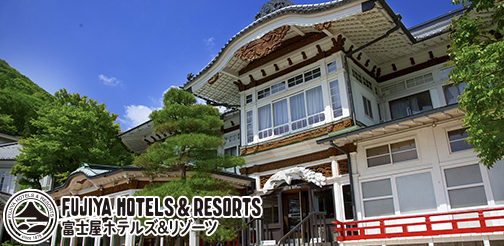
© hakone tourist association, All rights reserved.
- EXPERIENCES
- NATIONAL PARK
- FOODS & SHOPS
- EVENTS & FESTIVALS
- SIGHTSEEING
- GETTING AROUND
- ITINERARIES
- ACCOMMODATIONS
- HELPFUL INFO
Japan Travel & Culture Guide

5 Best Onsen Towns to Visit near Tokyo
Onsen are very popular experiences, especially if you are a newcomer to Japan . These hot spring baths take advantage of the natural volcanism of Japan to offer visitors the opportunity to bath in soothing warm waters. Onsen have been a part of Japanese culture for a very long time and have a rich tradition built around them.
If you’re visiting Tokyo , there are plenty of onsen towns that offer tourists a relaxing experience. They offer an excellent break from busy city life.
We feature the ones that are not located in Tokyo but outside the city and they are often considered the best when you plan on visiting as part of your day trips from Tokyo . Don’t worry as they are easily accessible by trains. You’d better visit one of these at the weekend and stay a night there for the best onsen experience .
Are you ready to explore them and witness Japan’s iconic landmarks along the way?
Here are five great and most popular onsen towns near Tokyo:
1. Hakone Onsen

Hakone has been a popular area for natural hot spring baths for centuries. The town has many bathhouses, drawing from more than a dozen springs.
There are a number of inns you can stay at that have their own onsen. Many of these also open their doors to day visitors, as well.
Tenzan , a traditional Japanese style onsen and one of the most popular bathhouses in Hakone, has some lovely onsen pools, including many outdoor ones and restaurants and cafe nearby. Many of the bathhouses offer spectacular views of the surrounding area and sit in peaceful woods.

The Hotel Green Plaza Hakone is another awesome onsen hotel where you can stay overnight if you want to with stunning views of Mount Fuji . It offers its baths both for hotel guests and day-tripper. It’s a 3-minute walk from Ubako Station on the Hakone Ropeway .
You can easily reach Hakone by rail, taking the Odakyu Railway from Tokyo’s Shinjuku Station to Hakone-Yumoto station, a ride of about 85 minutes at a cost of 2330 yen.
2. Kusatsu Onsen

Located in Gunma Prefecture , this small mountain town has the largest flowing water volume of all the hot springs in Japan. There are also some of the most acidic waters in Japan, which kills all bacteria and other microorganisms in the water.
Because of the unique properties of the waters, Kusatsu has developed its own bathing traditions. There are two bathing styles that are unique to Kusatsu and you should experience them both separately for skin beautification and blood circulation.
The Jikan-yu style has bathers pray at a small indoor shrine. The water is then stirred by the bathers, lowering its high temperature and helping the body absorb the steam after vigorous exercise.
The act of stirring the water is called Yumomi , which you can see in the Netsunoyu building located adjacent to yubatake (Hot Water Field, the symbol of Kosatsu).

Everyone usually sings a song at this point, too, opening up the lungs. When bathers enter the water, they cover their heads with towels and pour water on the back to help benefit from the healing properties.
This is a more coordinated onsen ritual than many and bathers will follow the bath leader’s call, staying in the water for only three minutes.
Awase-yu, a traditional bathing culture, is more relaxed. Bathers soak in four or five tubs of increasing water temperature to help them take the heat.
You can experience this bathing tradition at Otakinoyu, a popular hot spring in Kusatsu. Besides, this onsen offers private “Shakunage” baths for rent at 2,000 yen per hour, available for couples and families to bathe together.
There are only few restaurants and shops that serve guests to this unique onsen town, as well.
You can reach Kusatsu by taking the JR limited express from Ueno Station to Naganohara-Kusatsuguchi Station, then taking a bus thirty minutes to the town, or by taking a number of buses.
3. Atami Onsen

For centuries, the waters of Atami have appealed to bathers. Located on the Izu Peninsula , Atami is a very popular destination for couples with many excellent hot springs resorts. The most famous spring is the saltwater spring, which is very unique among Japan’s many onsens.
This is a very romantic trip, with plenty of food and shopping for visitors, including Onsen-manju , a sweet dumpling that Atami is famous for.
There are also plenty of other sights to see besides the onsen, including Atami castle , some wonderful museums, and the Akao Herb and Rose Garden.
Atami Korakuen Hotel is one of the largest hotels with natural onsen in the Atami area offering a panoramic view of the ocean, a large public bath and reserveable open-air baths.
You can reach Atami by taking the Tokaido Shinkansen , or limited express trains (80 mintues), which go straight there. Your fastest option, the Shinkansen, takes 50 minutes.
4. Ikaho Onsen

In Gunma Prefecture, Kusatsu Onsen is not the only onsen resort town you can explore rather it has some and one of the most popular among them is Ikaho Onsen . One interesting fact and the uniqueness you find here is it provides you iron enriched hot spring water.
The charming small town is centered on a 300-meter-long set of stone stairs that lead through the middle of town. These stairs are lined by shops and places to eat.

A visit here will seem like a trip back in time. The town has a hidden feel. There are many onsen, as well as some excellent sightseeing on the Ikaho Ropeway . Depending on the season, you can go fruit-picking or enjoy some spectacular fall foliage .
In this area, many tourists also visit Mizusawa Temple, Mount Haruna and Lake Haruna to enjoy picturesque nature.
To reach Ikaho by train, take the Shinkansen from JR Tokyo Station to Takasaki Station, which is a 60-minute ride. From there, take the Joetsu Line to Shibukawa Station, for a grand total trip time of around 3 hours.
You can stay at Mimatsukan for a pleasant and memorable stay in the area of Ikaho Onsen Town. It offers a spacious indoor hot spring bath and a rooftop outdoor one, which I particularly like.
5. Kinugawa Onsen

For most visitors to Nikko, they want to explore its historic buildings including Toshogu Shrine, and Rinnoji Temple, and Okunikko area to enjoy the beautiful landscapes of Lake Chuzenji, Ryuzu Waterfall, Mount Nantai, Kegon Waterfall, Mount Hangetsuyama, Irohazak – the winding roads and so on.
Nikko is at its best in autumn when surrounding areas are blanketed by stunning fall colors. To find out more about Nikko’s exclusive autumn nature, click here.
If you plan to visit Nikko and stay overnight in a perfect place with onsen baths, choose Kinugawa Onsen.

You can stat at Nanaeyae that offers open-air hot spring baths, beautiful views of the valley, and authentic Japanese dishes. The hotel is a 5-minute walk from Kinugawa Onsen Station .
This onsen town is a place to sightsee in the morning and then relax in hot springs for the rest of the day. Stay at one of the many inns along the river Kinugawa. It is a good idea to book a ride on a riverboat to get some of the best views of the area.
Don’t forget to enjoy the foot baths that you find here, they are free!

For the more athletic, there are plenty of excellent hikes that allow you to get closer to nature. You can also visit the nearby theme park of Edo Wonderland, which is an educational park that immerses visitors in life during the Edo period.
Kinugawa can be accessed by train. In Tokyo, take the Tobu Nikko line toward Nikko from Asakusa Station .
Onsens often have gender-segregated bathing areas, though this can vary, as can the clothing requirements. Some ban tattoos, as these are associated with organized crime.
You can learn some important onsen etiquette . Be sure to learn and follow the onsen rules.
Share this:
- Click to share on Facebook (Opens in new window)
- Click to share on X (Opens in new window)
- Click to share on Pinterest (Opens in new window)
- Click to share on LinkedIn (Opens in new window)
- Click to share on Reddit (Opens in new window)
Leave a Reply Cancel reply

Hello there, looking to plan your next Japan adventure? You’re in the right place! We’re your go-to source for all things travel-related, especially when it comes to exploring Hokkaido. We share Hokkaido travel tips and free itineraries to make your trip truly memorable. Read our guides and for further inquiries, feel free to contact us!
Follow us on Facebook
Hot spring bath with great views of Mt. Fuji!!!!


The 8 Best Onsen in and Around Tokyo
David Taylor
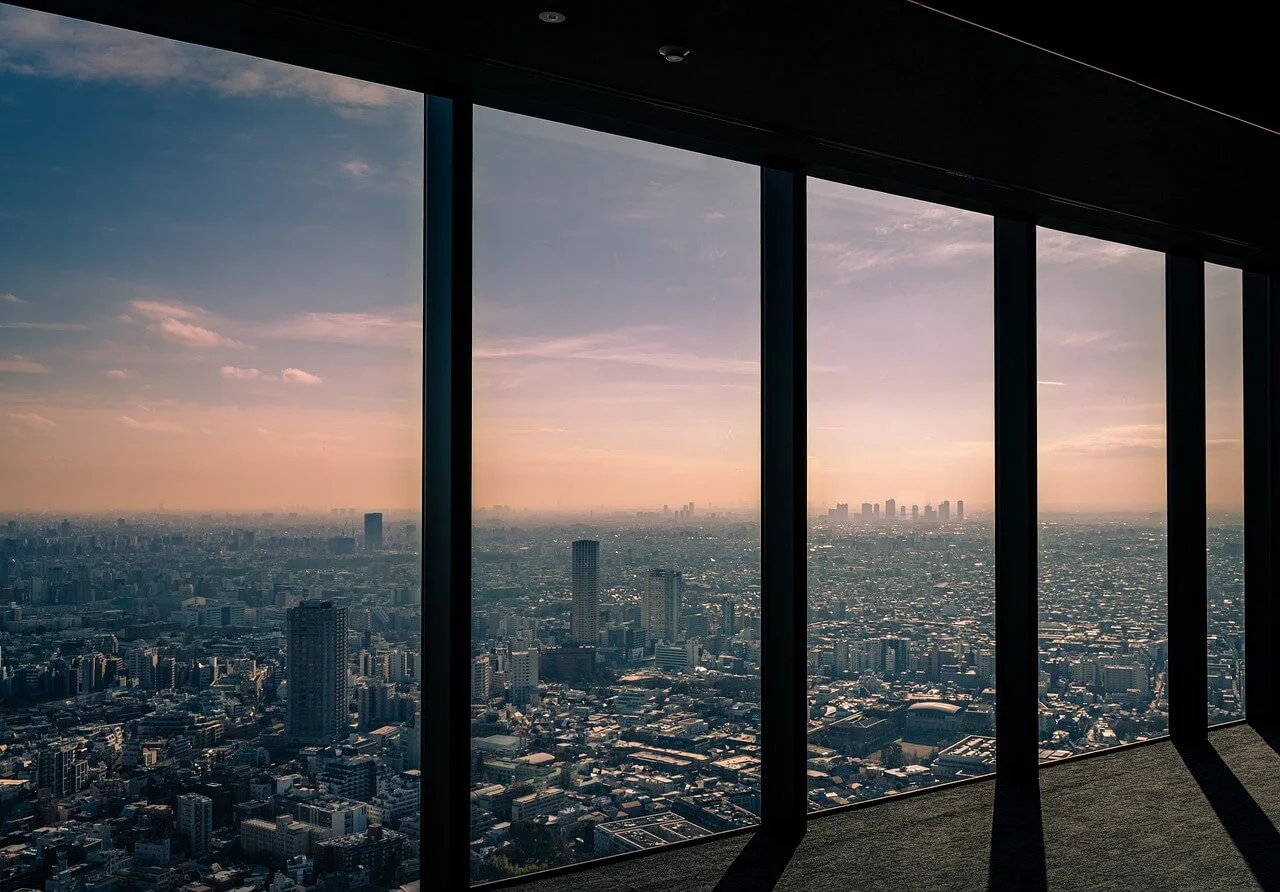
Looking to take a dip in Japan’s capital city? There are more spas in Tokyo than you can count, and while they’re all fantastic options, some lack the natural qualities that make hot springs the best way to relax.
Here are the 8 best onsen in and around Tokyo:
- Takaragawa Onsen
- Hakone Yuryo
- Ooedo-Onsen Monogatari Urayasu Mangekyo
- Sakura Onsen
- Yugara Onsen
Each option offers some unique blend of traditional charm, modern amenities, and rejuvenation. Prepare to unwind, recharge, and embark on a blissful onsen journey in or very near the capital.
What goes better than winter and onsen? Well, maybe nothing… But illumination displays in Tokyo might be the closest second. Check out Forever Foreign’s top 8 and give an extra spark to the winter season.
1. Takaragawa Onsen

Location: Gunma Prefecture
To get the good stuff, sometimes you gotta take a little trip. Located just a couple of hours from Tokyo, Takaragawa Onsen offers just that in the more rural and mountainous Gunma Prefecture. What sets it apart is its picturesque outdoor baths along the rushing Tone River.
A trip to this nearby prefecture means serene nature packed with beautiful mountains and soothing hot springs. Very different from the hustle and bustle of Tokyo.
If you take a trip to Takaragawa Onsen, go through the list of ryokan (traditional Japanese inn) and book yourself a traditional onsen stay.
2. Niwa no Yu
Location: Nerima Ward, Tokyo
Looking for something a little closer to home base? Niwa no Yu could be the best choice available.
This not-so-hidden oasis in the heart of Tokyo is conveniently located in Nerima next to the old Toshimaen theme park grounds. The hot spring boasts indoor and outdoor baths, Finnish saunas, and a relaxation area among several spa services.
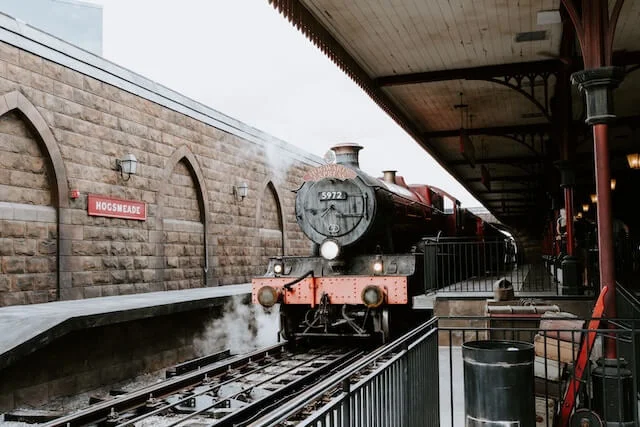
Step into the peaceful atmosphere of the Japanese garden-inspired interior and soak away your worries in the therapeutic waters. Oh, and consider using this as your final stop of the day after wandering around the nearby Warner Brothers Harry Potter Studio Tour .
3. Hakone Yuryo
Location: Hakone, Kanagawa Prefecture
Stepping away from Tokyo once more – but not too far! – there’s one of the most famous onsen locations in all of Japan in Hakone. At least it’s one of the most famous among tourists because of its combination of high quality facilities and proximity to the capital.
Don’t let the idea of tourists scare you away, though. A trip to Hakone means being surrounded by breathtaking landscapes and staying at some of the best ryokans in Japan with both indoor and outdoor bathing options.
And if you’d rather not stay the night, you can always pop in for a day trip from Tokyo or hit Hakone Yuryo on your way to Kyoto. There’s plenty to do in the area from boat rides to day hikes.
4. Thermae-Yu
Location: Shinjuku Ward, Toyko
If you’re heading to Tokyo, there’s a good chance you’ll end up in Shinjuku at some point. And if you do, you’ll have a fantastic Tokyo onsen at your fingertips.
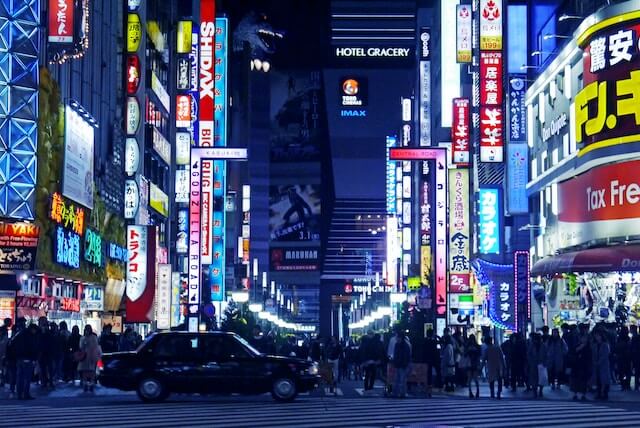
Thermae-Yu features a variety of baths, ranging from traditional to themed and medicinal. There’s even a unique moisturizing choral bath that you won’t find almost anywhere else.
While there, you can also take advantage of the different traditional saunas or lie down in a stone sauna (ganbanyoku) for an additional ¥850 fee. When it’s all said and done, you can cool down in one of Golden Gai’s many bars with a beer or cocktail.
5. Ooedo-Onsen Monogatari Urayasu Mangekyo
Location: Urayasu, Chiba Prefecture
Not to be confused with the Odaiba Oedo-Onsen that closed down in 2021, the Urayasu Mangekyo location offers a similar vibe. This onsen resort replicates the vibrant atmosphere of the Edo period, featuring hot spring baths, foot baths, and various entertainment options.

You can either stay at the hotel or you can pick up a day pass to access the baths. Either way, you’ll have your pick of 38 (that’s right, 38) different baths, some indoors, some outdoors, some with a classic wooden bath house feel, others set up in a rock garden that can feel a bit like you’re in the mountains.
And if the Tokyo area onsen theme park wasn’t enough for you, there’s another theme park nearby. A short car ride away is Tokyo Disneyland and DisneySea, so if you’re still itching for more theme park action, head on down!
6. Yunessun
If you haven’t had enough of onsen theme parks, then head on down to Yunessun in Japan’s onsen capital of Hakone. Tickets start at ¥1,500 for the onsen area, but if you pay ¥3,500 you also gain access to the water park with different swimming pools, water slides, and themed baths.
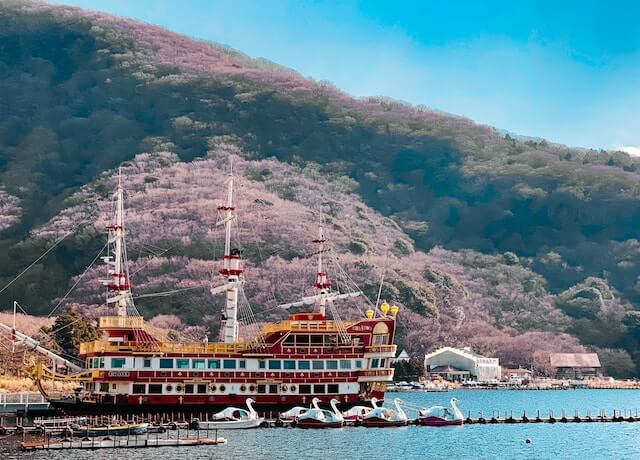
Looking to hop into a red wine-themed pool? They’ve got you covered. Want to feel like you’re soaking in coffee? They have that too. There’s a whole list of other attractions to choose from too:
- Swimming pools with a current
- Dr. Fish foot baths
- Outdoor camping options
Yunessun combines relaxation with entertainment for an unforgettable onsen adventure.
7. Sakura Onsen
Location: Toshima ward, Tokyo
Sakura Onsen is a popular destination whether you’re looking for the basic layout of indoor and outdoor baths, more intimate overnight stays with private baths , or even full-day spa pampering.

The building sources its mineral-rich hot spring water from deep underground, making it something of a modern miracle. The surrounding gardens also add to the serene atmosphere, making it a perfect hideaway from the city’s hustle and bustle.
Oh, and if you’re a fan of drama, you can put the cherry on top of your day by visiting the Tokyo Metropolitan theater.
8. Tokyo Yugara Onsen (Manyo-no-Yu)
Location: Machida, Tokyo
Located on the western edge of the Tokyo metropolitan area, Manyo-no-Yu is a towering complex that offers just about every relaxation service you could want. You can stay the night, go for a day trip, order fantastic Japanese food, and, of course, slip into all-natural onsen baths right in Tokyo.
Manyo-no-Yu is a great option for those looking for a break from the hustle and bustle of a typical Tokyo stay. You can plop it into the middle of a week in the capital or bookend your trip with a relaxing stopover.
Look forward to the following if you decide to head to Manyo-no-Yu:
- Terrace baths
- Indoor baths and saunas
- An array of wellness services like lymph massage and aromatherapy
- Rock saunas
If you’re looking for an onsen in Tokyo or nearby, there are plenty of options for overnight stays or day trips. Take your pick from traditional ryokan villages or onsen theme parks with wine baths. Tokyo has it all.
Choose the stop that works best with your itinerary and soon your troubles will be sliding off your back just like the mineral-rich hot spring water.
Share the adventures Share this content
- Opens in a new window X
- Opens in a new window Facebook
- Opens in a new window Pinterest
- Opens in a new window LinkedIn
- Opens in a new window Reddit
- Opens in a new window Tumblr
- Opens in a new window WhatsApp
You Might Also Like

Relax and Rejuvenate in Nagano’s Top 7 Onsen

Japan’s 11 Most Famous Onsen
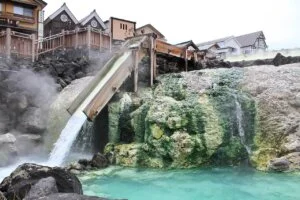
The 9 Best of the Best Hot Springs in Japan
This post has 2 comments.
What a cool article it is! I wonder if you’ve already checked out Kamata onsen in Tokyo?
I haven’t, but I’ll have to give it a look! Thanks 🙂
Comments are closed.
- Things to Do
10 Best Onsen in Japan's Kanto Region to Soak in After Your Tokyo Trip (2023 Editon)

- ikumiwatanabe
After shopping and sightseeing in Tokyo, there's no better relief for tired muscles than hot springs surrounded by nature. This article will introduce 10 of the best onsen (hot spring) resorts in Japan's Kanto region, including popular areas such as Nikko or Kusatsu. These onsen are easily accessible from Tokyo, with some even doable on a day trip! We will also introduce the highlights and characteristics of each hot spring as well as some of the best places to stay, allowing you to take your pick and discover the best one for you!

This post may contain affiliate links. If you buy through them, we may earn a commission at no additional cost to you.
What Makes Kanto's Hot Springs Special
Many onsen resorts exude a distinctly Japanese ambience and are always popular with those seeking the ultimate Japan experience. We've picked out 10 quintessential Japanese hot springs encompassed by picturesque towns perfect for strolls and sightseeing, along with those boasting iconic scenery and leisure facilities to explore and enjoy.
Furthermore, many Kanto onsen are easily accessible from Tokyo , making them great destinations for an overnight stay after whirling around Japan’s capital. To further help your planning, we will also discuss the defining characteristics of each hot spring so that you can choose one that best suits your needs.
Ikaho Onsen: Iconic Stone Steps Just 90 Minutes From Tokyo (Gunma)
The symbol of the 400-year-old Ikaho Onsen is its stone walkway of 365 steps. As the step numbers are written on each, it's common for visitors to work out which step corresponds to their own birthday and take a commemorative photo on it. There are 3 free footbaths at the bottom, middle, and top of the stone steps, perfect for soaking in between strolls!
Our Top Tips
JR Pass for Whole Japan
Explore Japan in the most convenient and economical way with a Japan Rail Pass! It is valid for the majority of railways and local buses operated by JR.
Both sides of the steps are lined with unique stores, such as retro shooting shops where you can play with cork guns to hit prizes like toys and sweets and ones selling manju buns, a traditional sweet made by wrapping red bean paste boiled in sugar in a thin dough and steaming it. Ikaho Shrine, located at the very top of the stone steps, is a popular shrine to pray for good luck in love and marriage. At night, the stone steps are illuminated in an enchanting display.
There are two types of hot spring water in Ikaho Onsen: the "Golden Hot Spring," which is actually more brown and contains calcium and sodium, and the "Silver Hot Spring," which is clear, odorless, and suitable for those recovering from illnesses. There is a beautiful vermilion red bridge near the source of the Golden Hot Spring, which is about a 15-minute walk from the stone steps and a famous spot for lush greenery and autumn leaves.

Shima Onsen: Straight Out of a Ghibli Movie?! (Gunma)
Shima Onsen is a deeply historical hot spring resort with 1,000 to 1,200 years of history and a legend that it can cure 40,000 diseases. The hot spring water here is said to be good for the digestive system when drunk and great for the skin when bathed in, which explains the many drinking fountains available. With numerous inns utilizing seasonal ingredients to craft exquisite Japanese dishes, visitors can get a taste of tradition through local cuisine alongside its atmospheric streets.
Ghibli fans will also love how Shima Onsen’s Sekizenkan Ryokan looks like the bathhouse in the hit Ghibli anime "Spirited Away." In fact, many of the town’s hot spring inns with 300+ years of history bear a striking resemblance to those in Spirited Away.
With the Hinata Miyakushido shrine and Lake Okushima nearby, Shima Onsen is the ideal place to appreciate the fresh greenery and vibrant fall colors of Japan.

Kusatsu Onsen: Japan's Largest Natural Spring Water Yield with Antibacterial Powers! (Gunma)
The Yubatake is the symbol and heart of Kusatsu Onsen. It has a high acidity level of pH 2.1 and a hot spring water output of 3,000 to 4,000 liters per minute! The source of the hot spring is located right in the city center of Kusatsu, and is lit up in a magnificent display come the evening.
When exploring Kusatsu Onsen, a visit to the hot spring facility "Netsunoyu" to see the tradition of "yumomi" should not be missed. Yumomi is a method of lowering the temperature of Kusatsu's extremely hot spring water, which can range from 50°C to 95°C, by stirring it up without diluting it. Visitors can watch the jovial song and dance performance that accompanies the stirring of the bath, and you can even have a go at it yourself!
Another recommended spot is Sainokawara Park, a 10-minute walk from Yubatake. The park is filled with greenery and natural hot springs gushing out from the ground, providing the ultimate onsen landscape. There are also free foot baths with different temperatures depending on the location, so choose one just right for you for a relaxing soak. Just don't forget to bring your own towel!
Nasu Onsen: Nature, Theme Parks, and 1,300 Years of History! (Tochigi)
Nasu Onsen is located in a highland resort close to renowned sightseeing spots like Komagataki, famous for the amusement park Nasu Highland Park and stunning autumn foliage, as well as Mt. Chausu, which can be ascended via ropeway.
While there are lots of accommodation facilities including ryokan (traditional Japanese inns), resort hotels, and guest houses, as well as various hot springs scattered throughout the area, we recommend visitors take a dip at Shikanoyu, which has a 1,300 year history. The wooden building was built in 1936 and, while being clean and well-maintained, one can definitely sense its long history.
Shikanoyu, which was said to have been discovered from deer healing their wounds in the water, has a special bathing method called "kaburi-yu." Before hopping in, bathers are meant to use a “hishaku” (a Japanese water ladle that has a small cup with a long handle) to pour hot water over the back of the head and neck 200 times for adults and 100 times for children. This ritual is said to increase the effect of the hot spring and to prevent people from getting dizzy when bathing. The hishaku is free to borrow, so don't hesitate to give it a try! The spring is a plain acidic sulfur hot spring, filling the area with the smell of sulfur typical of a hot spring resort.
Kinugawa Onsen: Hot Springs by a Magnificent Valley (Tochigi)
Kinugawa Onsen is a hot spring resort boasting hotels and ryokan dotted along a stunning valley. The gentle spring water has a weak alkalinity and is said to be effective for burns.
There are plenty of sightseeing activities in the area, such as visiting the Edo Wonderland Nikko Edomura, a theme park that recreates the streets and lifestyle of the Edo period (1603-1867), or enjoying a boat ride down the valley river.
Another must-see in the area is Nikko Tosho-gu Shrine, a UNESCO World Heritage Site. It has a history of approximately 400 years and is chock full of gems to discover and appreciate, including the magnificent gate and exquisitely detailed sculptures.
Japan Shinkansen, Narita Express (N'EX) & Express Train Tickets
Plan ahead by booking your shinkansen, airport train, and express train tickets online in English. Have the tickets sent to you by mail or collect them at the station once you're in Japan.
Hakone-Yumoto Onsen: Appreciate Art with Hot Springs! (Kanagawa)
Taking only 85 mins from Shinjuku on the Odakyu Romance Car and located right in front of Hakone-Yumoto Station, Hakone is a very convenient hot spring resort easily accessed from the Tokyo metropolitan area. It also boasts an extensive history spanning roughly 1,200 years and currently offers around 40 hot spring hotels right by the station, making it the prefered onsen for day-trippers from Tokyo. It is also a great place to savor fresh seafood caught at the nearby Sagami Bay, making it a hit with gourmands, too. Within Hakone are hot springs with simple water, simple alkaline water, and ones containing sodium chloride, which are said to be effective against muscle pain and cold sensitivity.
Nearby are several art museums including the Hakone Open-Air Museum, Pola Museum of Art, and Okada Museum of Art. Also worth checking out is the Hakone Museum of Art, a fantastic place to enjoy Japanese gardens and pottery, along with the Narukawa Art Museum at Ashinoko, which is renowned for its collection of contemporary Japanese paintings.
Yugawara Onsen: Spectacular Flowers and Mouthwatering Seafood (Kanagawa)
Yugawara Onsen is a hot spring resort sandwiched by Sagami Bay on one side and mountains on the other. Here you can fully relish the essence of nature in every season, seen at its pinnacle in the Yugawara plum grove, Satsuki no Sato in Hoshigayama Park, and the autumn colors of Okuyugawara.
With Sagami Bay being close by, Yugawara Onsen is also an excellent place to enjoy fresh seafood. Being only 80 mins away from Tokyo on a direct train, its stress-free accessibility is also a big factor in its popularity. The spring water here is slightly saline and alkaline, making it foam well with soap, feel soft on skin, and preventing it from being easily cooled.
Chichibu Onsen: An Easy Day Trip From Tokyo (Saitama)
Chichibu is recommended for those seeking an easy day trip from the Tokyo metropolitan area. Being only 78 mins away from Ikebukuro Station and the location of the beautiful Nagatoro Valley, it contains a vast wealth of untouched wilderness despite its proximity to the city.
There are many day-trip hot spring facilities and hotels offering day-trip bathing packages in Chichibu. Seibu-Chichibu Ekimae Onsen Matsuri no Yu offers excellent access from the station, Seine no Yu has a sauna and hot stone spa, Mangan no Yu allows you to bathe while gazing at a mountain stream and waterfall, Chichibu Onsen Hananoya offers day-trip visitors the use of open-air baths within guest rooms, Wado boasts a spectacular open-air bath, and Ofuro Cafe Hakuju no Yu provides hammocks to relax in after bathing. With each one offering a different atmosphere and experience, take the time to research and pick your favorite to make the most out of your journey!
Kominato Onsen: Hot Springs on the Beachside! (Chiba)
With a 300-meter-long white sandy beach and clear waters, Shirosaki Beach in Chiba overflows with swimmers in the summer. Alongside this picturesque coastline sits Kominato Onsen. After bathing in the sea, relax in the nourishing hot spring waters and take a stroll to soak up the spectacular view of the clear blue sea tinted by the setting sun. The springs are bicarbonate and chloride and are effective against nerve pain, arthritis, stiff shoulders, poor circulation, and skin ailments.
While you’re here, treat yourself to a lavish helping of fresh seafood or take a sightseeing boat tour to see the schools of fish at Tai-no-ura.
Kamogawa Onsen: Hot Springs with a Seaside Resort Atmosphere (Chiba)
Of all the onsen resorts in the Kanto area, Kamogawa Onsen is the most resort-like. With panoramic views and a charming seaside atmosphere heightened by a mild year-round climate, it’s a fantastic escape into paradise. There are also luxury ryokan boasting guest rooms furnished with open-air baths, allowing you to soak alongside ocean views. Like Kominato Onsen, it is a popular place for fresh seafood due to its proximity to the sea.
Kamogawa Onsen is also close to Kamogawa Sea World, the Yoro Ravine, Niemon Island, and plenty of other scenic spots, making it a great destination for both adventurers and families.
The spring water here is bicarbonate and said to be effective at treating poor blood circulation.
Hot Spring Luxury Right Next to Tokyo!
Alongside vibrant cities and fascinating cultures, Kanto offers a fantastic diversity of onsen to thoroughly immerse yourself in the stillness of nature while reveling in lively streets and exploring the bounties of the surrounding area. Next time you’re in Kanto, give yourself and your travel buddies some well-deserved downtime and make the journey to one of our recommended Kanto hot spring resorts!
If you want to give feedback on any of our articles, you have an idea that you'd really like to see come to life, or you just have a question on Japan, hit us up on our Facebook , Twitter , or Instagram !
Thumbnail: Infinity T29 / Shutterstock.com

The information in this article is accurate at the time of publication.
tsunagu Japan Newsletter
Subscribe to our free newsletter and we'll show you the best Japan has to offer!

- kusatsu onsen
- hakone yumoto
About the author
Related Articles
Related interests.
- Sports & Outdoors
- Onsens & Spas
- Museums & Art Galleries
- Japan at night
- Flowers & Trees
- Tourist Spots & Attractions
- Theme Parks
- Nature & Scenery
- Parks & Gardens
Restaurant Search
Tsunagu japan sns.
Subscribe to the tsunagu Japan Newsletter
Sign up to our free newsletter to discover the best Japan has to offer.
Connect with Japan through tsunagu Japan
Let us introduce you to the best of Japan through our free newsletter: sightseeing spots, delicious food, deep culture, best places to stay, and more!
Ginzan Onsen
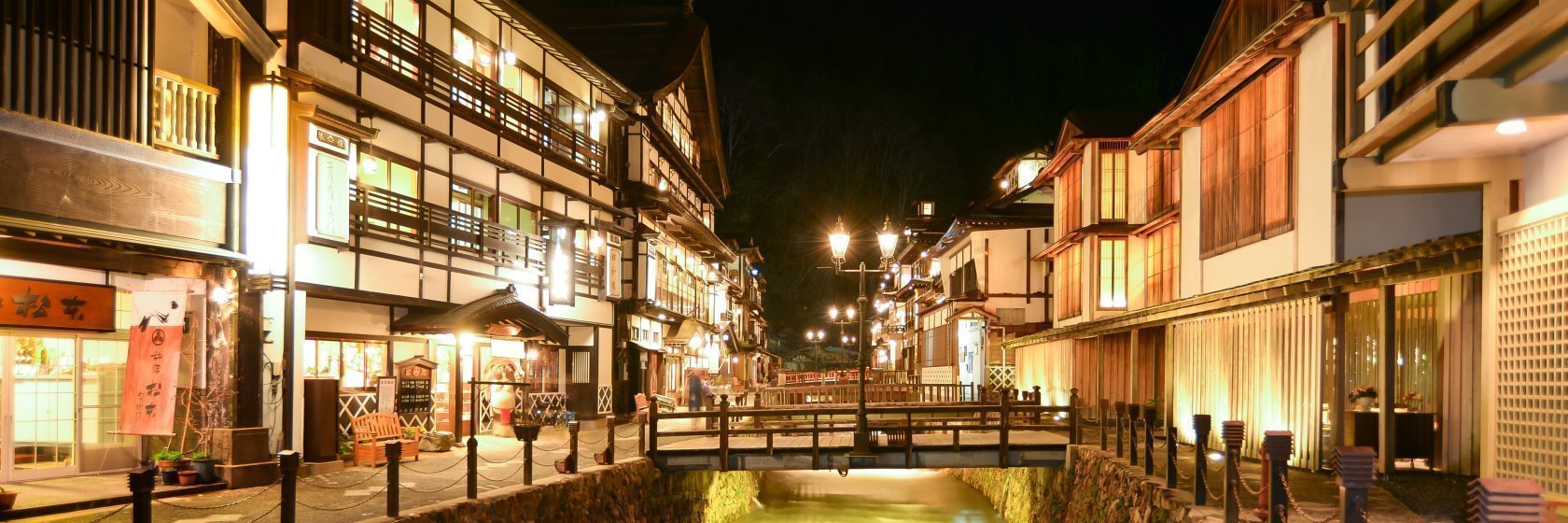
Ginzan Onsen (��R����, lit. "Silver Mountain Hot Spring") is a secluded hot spring town nestled in the mountains of Yamagata Prefecture . The area originally developed around a silver mine; however, these days it is better known as one of Japan's prettiest onsen towns with historic ryokan lined up along the river.
Ginzan Onsen's traditionally styled ryokan occupy beautiful three and four story wooden buildings that, with their exposed woodwork and white plaster walls, evoke nostalgic feelings of a bygone era. There is one exception, however, in the Fujiya ryokan at the center of town, which was recently rebuilt by famous modern architect Kuma Kengo. Although purists may find it out of place, its unique modern design incorporates many of the traditional design elements of the surrounding buildings, such as the same exposed wood and white plaster.
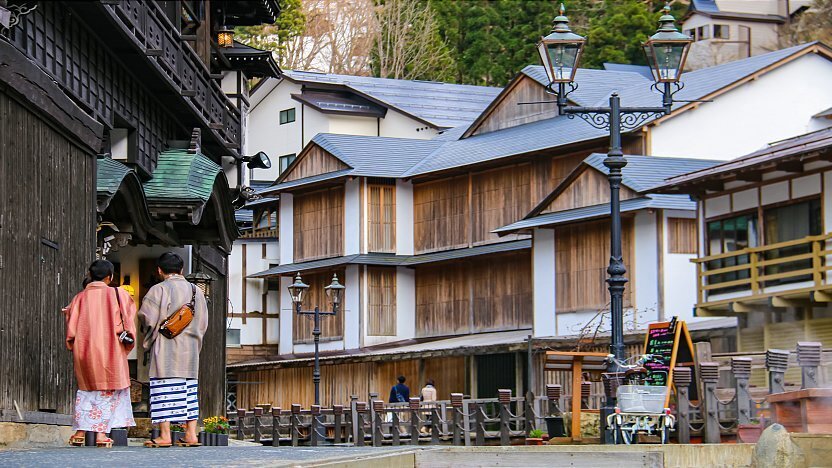
The town center of Ginzan Onsen is a pedestrian-only zone due to the narrow streets and lack of parking. It is particularly nice in the evenings when the ryokan are all lit up and the streets and bridges are illuminated by gas lights. In winter, the scenery is enhanced by heavy snow that clings to the rooftops and walkways, while during the warmer months the ryokan guests are more likely to be out strolling about town in their yukata .
Two public baths (500 yen each) and a foot bath (free of charge) can be found around the town center. One of the public baths, the Shiroganeyu, was also designed by Kuma Kengo. Further available is the Omokageyu, a public bath for private use (2000 yen per 50 minutes). In addition, many of the town's ryokan open their baths to non-staying guests during daytime for typically 500 to 1500 yen. Most feature historic indoor baths.
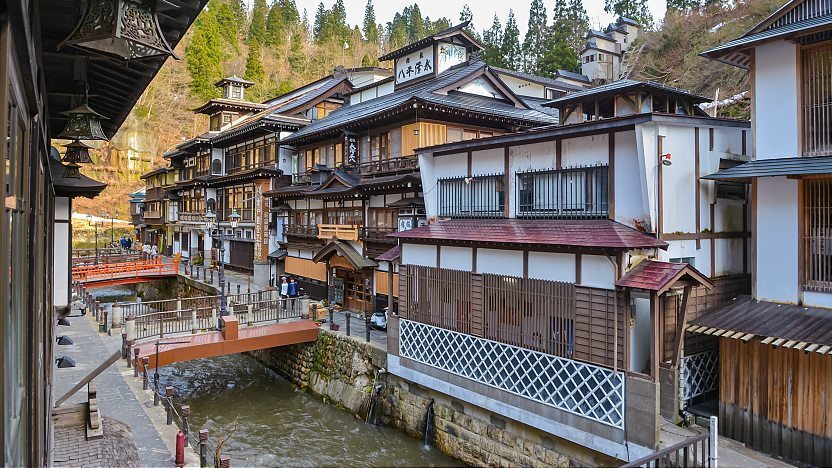
A spectacular, 22 meter tall waterfall rushes constantly at the back of the town. Not far from its base is one of the entrances to the historic silver mine that was built here over 500 years ago and served as the town's lifeblood during the early Edo Period . Visitors can enter the lit-up tunnel, although they cannot go very far in as it is only accessible for about twenty meters.
Tourists can see a little bit more of the mines by following a nature trail up into the valley for about 10-15 minutes past the waterfall. There, they will find a slightly longer section of the former mine for people to enter. Note, however, that the nature trail is not passable in winter and early spring due to snow.
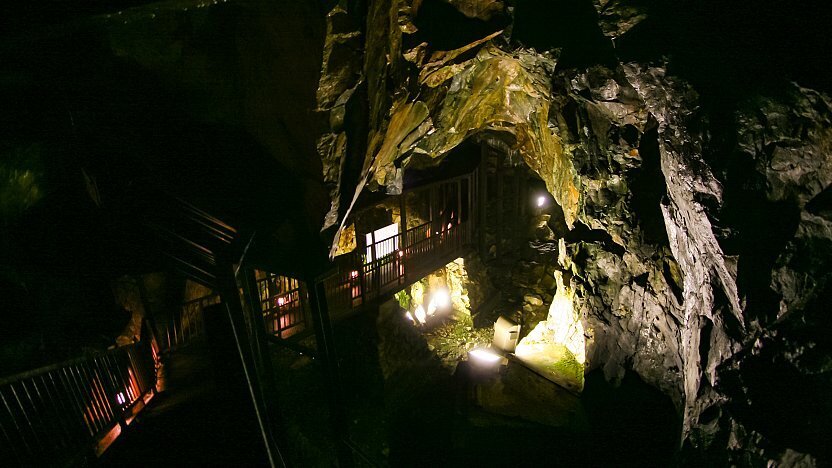
Getting there and around
Take the JR Yamagata Shinkansen from Tokyo to Oishida Station (about 200 minutes, around 12,500 yen one way), from where buses depart roughly every two hours for Ginzan Onsen (35 minutes, 720 yen one way). The train portion of the journey is fully covered by the Japan Rail Pass , JR East Tohoku Area Pass and JR East South Hokkaido Pass , but the bus ride is not.
A rental car can be convenient for exploring the area. Rental car outlets are available at stations along the Yamagata Shinkansen such as Murayama, Shinjo and Yamagata stations, as well as at Yamagata Airport. Parking is available at parking lots a 5-10 minute walk outside the town center. Many ryokan will pick up their guests from the parking lot.
There are two bus round trips per day between Yamagata Airport and Ginzan Onsen (75 minutes, 1500 yen one way) that require no prior reservations.
Questions? Ask in our forum .
Links and Resources
Hanagasa bus, yamagata airport bus.

Truly Tokyo
A Tokyo Travel Guide
Shuzenji Onsen Overnight Trip Itinerary
Make the most of a day out in the charming hot spring resort of Shuzenji Onsen in the Izu Peninsula, located 2.5 hours away from Tokyo by train and bus, with our Shuzenji Onsen Overnight Trip Itinerary.

Located to the southeast of Tokyo, the Izu Peninsula has all the elements for a great adventure – fantastic hiking trails, rugged cliffs, the deep blue of the Pacific Ocean, and dozens of great little towns to explore. While it's theoretically doable as a day trip, it's far better to take a train out and stay overnight in one of the little towns on the peninsula.
Shuzenji Onsen is a lovely option for an overnight trip out of Tokyo. Surrounded by mountains on all sides, this charming hot spring resort town has gorgeous scenery, delicious food, and an abundance of hot spring baths. It’s especially beautiful during spring for the blossoms, and in autumn for the colours. Unsurprisingly, it’s one of the most popular weekend getaways on the peninsula.
Check Hotel Availability
Destination, check-in date, check-out date.

Shuzenji Onsen is named for its principal temple, Shuzenji. It’s said that the temple was founded by Kobo Daishi, Japan’s most famous Buddhist monk. It is also believed that the same monk––in the 9th century––struck a rock with his staff and caused hot spring waters to spring forth, blessing the town with its source of onsen water. Regardless of its real origins, it’s true that the baths here are just fabulous. Besides full-body immersions, you can also soak your feet in one of the foot baths dotted around the town center.
Shuzenji Onsen Itinerary Sections
This itinerary contains the following sections:
- Notes Before You Go
The Full Shuzenji Onsen Overnight Itinerary
Shuzenji onsen overnight trip map, recommended accommodation in shuzenji onsen.

Notes Before You Go To Shuzenji Onsen
- This itinerary is a guideline. Add or subtract places as you like.
- Itinerary timings are approximate. Shuzenji Onsen is a small onsen town, and the primary draw of this place is to enjoy the ryokan. It’s a very leisurely itinerary. Adjust the timings to suit your schedule.
- It’s always worth checking train and/or bus times to make sure you won’t miss your connecting flights.
- This is a walking itinerary. Visiting the temple also involves a few flights of stairs, though these are short, can be taken slowly and should not prove too onerous. Put a comfortable pair of walking shoes on and give it a shot!

Shuzenji Onsen Itinerary: Day 1
8:30am start at tokyo station.
Begin at any of the exits to JR Tokyo Station. You’ll be traveling on the Tokaido shinkansen bullet train to Mishima Station. You can either take the Hikari or Kodama trains, which are covered by the JR Pass. The fastest Nozomi trains skip Mishima Station.
Tickets can be purchased at the Midori no Madoguchi counter or any ticket machine with a “Shinkansen” signboard above. Ticket machines now have options in English, so it’s simply a matter of following the instructions. Trains may be a little busier during peak travel seasons, so you may want to purchase reserved seats for peace of mind. At the time of writing, a reserved-seat one-way trip from Tokyo Station to Mishima Station costs JPY4400.

Follow the signs to the Shinkansen bullet trains. Make sure you always have your ticket with you. I boarded the Kodama train departing at 8:56am. For your pick of train times, consult the train timetable here or use a transport app such as Google Maps.

9:55am Arrive at Mishima Station
Travelling from Tokyo Station to Mishima Station takes just under an hour. From here, you’ll transfer to the Izu-Hakone Railway for onward travel to Shuzenji Station.

Follow the signs to the South Exit as pictured above.

10:00am Travel to Shuzenji Station by train
Your next step is to travel to Shuzenji Station. While there’s a train departing at 10:04am, don’t sweat it if you don’t make that train. Give yourself time to buy tickets, use the bathroom, and get to the platform. There’s another one departing at 10:17am; trains to Shuzenji Station depart an average of 4 times an hour.

A one-way journey from Mishima Station to Shuzenji Station costs JPY520. Buy this at the ticket machine, which has purchasing options in English.

11:00am Travel to Shuzenji Onsen by bus
You’ll arrive at approximately 10:56am. From here, you’ll take a bus to Shuzenji Onsen. The bus stops are located in front of Shuzenji Station; there’s only one exit. Head over to Bus Stop 1. Buses C10 or 修10 will take you there; check the electronic signboard in front of the ticket gates near 7-11 for more information on bus times.
It’s best to leave any suitcases at your inn before exploring town. In this case, you may want to use the travel directions provided by your accommodation. In any case, the bus journey to the centre of Shuzenji Onsen will take approximately 20 minutes.

11:45am Explore Shuzenji Onsen
Now that you’ve divested yourself of extra baggage, it’s time to explore Shuzenji Onsen. The town itself is quite compact, with most of the attractions and places to see clustered around the river. It’s mainly about enjoying the atmosphere and scenery. Shuzenji Onsen is lovely at any time of the year, but it’s particularly picturesque in autumn when the fall colours are in full red-and-gold mode.

You might begin with Hie Shrine, located just opposite Togetsu Bridge. Hie Shrine is said to have been built by Kobo Daishi––the founder of the “Esoteric” school of Buddhism, known as Kūkai when alive––and was once the tutelary shrine of nearby Shuzenji Temple.

The most impressive part of the shrine must be the pair of Japanese cedars towering over the shrine grounds. These are Meotosugi and Ichii-gashi respectively, and they are designated national treasures of Shizuoka.

Exiting Hie Shrine, follow the river upstream. You’ll see the town centre and the staircase to Shuzenji Temple on your right. En route, you’ll pass by this gift shop––a great little place for souvenirs and presents.

Shuzenji Temple was supposedly founded by the aforementioned Kobo Daishi in the 9th century. It is associated with Minamoto no Noriyori, a Japanese warlord during the early Kamakura period (1185–1333) known for his victory in the Battle of Ichinotani against the Heike clan.

In 1194, Minamoto no Noriyori was arrested and locked up in the temple by his elder brother after accusations that he was plotting against the shogunate; Noriyori subsequently committed suicide on the grounds of Hie Shrine.

You’ll see a wooden pavilion located down a flight of stairs, right on top of the river. This is Tokko-no-yu, a foot bath.

There’s also Kawara-no-yu on the path nearby. Take off your shoes and soak your feet in the hot waters––your feet will thank you for it! It will be helpful to have a towel handy for putting your shoes back on.

Cross Kokei Bridge and wander over to the other side, where there are a number of craft shops, restaurants, souvenir stores, and miscellaneous little nooks and crannies to peer into.

For example, you might find an antique knick-knack or two at this shop.

Or, you can try your hand at the old-fashioned games in this shop.

There’s also another (unnamed) foot bath overlooking the river.

1:00pm Lunch in Shuzenji Onsen
After some exploring, it’s time for lunch. Shuzenji Onsen has a surprisingly high concentration of soba restaurants, in addition to other eating options. We’ve marked some places to eat on the itinerary map located at the end of this article.

A good place for lunch is Sobadokoro Shikishi. You’ll find it on your left as you meander upstream on the left bank of the river. It can be crowded here at lunch hours during peak travel season, so depending on when you show up, you might have to wait a while.

Oddly enough for a soba restaurant, Shikishi is famous for their beef stew. It’s a far cry from buckwheat noodles but they do it well. The large hunks of tender stewed beef in a savoury gravy go beautifully with white rice.

2:00pm Continue exploring Shuzenji Onsen
Following the river upstream will take you to the little bamboo path. If you didn’t manage to make it to the famous bamboo forest in Kyoto, this is a pleasant (and generally much quieter) alternative.

Stay as close to the river as possible for all the photo opportunities.

The bamboo path is short but picturesque.

You’ll arrive at the maple grove, and you get a lovely view of the river from the bridge.

If you’re so inclined, you can veer away from the river, follow the signs and maps––Shuzenji Onsen is well sign-posted––and take a short climb up the hillside to the grave of Minamoto no Noriyori. While the grave itself may only be of Japanese interest to history buffs, it’s a pleasant walk. Afterwards, you can walk back to town via Akagaeru Park (marked on the map) near the bamboo path.

If you’re keen on a cafe break, Mangetsudo near Shuzenji Temple is a good option. It’s an old-school cafe run by an elderly couple. Take note: like most kissaten, it allows smoking; there are non-smoking sections but those sensitive to smoke may wish to skip this place.

The tea is strong and they serve generous portions of cake. The chocolate mousse cake was just right for a mid-afternoon snack.
3:30pm Check in to your accommodation
Having spent the afternoon exploring the town, it’s time to head to your inn. You’ll want to spend the rest of the afternoon soaking in the hot springs at your inn or hotel––that’s the whole point of visiting an onsen town, after all! Don’t forget to soak in the baths again after dinner.
If you are staying at a ryokan (Japanese-style inn), you will most likely have breakfast and dinner included in your stay. However, if you’re staying at a hotel, you might not necessarily want to eat there for your evening meal. Much of Shuzenji Onsen shuts down once it gets dark, but there will still be a few places open. We’ve marked some restaurants on the map at the end of this itinerary.

Shuzenji Onsen Itinerary: Day 2
9:00am bus to darumayama kogen rest house.
If you’d rather take things slow, you could just relax at your inn until it’s time to leave Shuzenji Onsen. I’ve outlined a short hiking option for those who prefer a more active holiday; as a bonus, this option gives you fantastic views of Mt. Fuji on a clear day.

You’ll begin by taking a bus to Darumayama Kogen Rest House. I’ve marked it on the itinerary map located at the end of this article. It is not the same bus stop as the one you’ll have alighted from yesterday, so beware!

You’re at the right place if you see an outdoor bus stop marked “B” located next to a small canal as above.

In the above timetable, times for buses bound for Head via Niji-no-sato can be found in the second column. As you can see, buses leave infrequently. The only time available is 9:28am––don’t miss the bus or you’ll have to wait two hours for the next one. Alternatively, you can take the 7:46am bus for an early morning hike. (But you’ll probably miss out on breakfast at the inn.)

If you’re so inclined, you could visit Niji-no-Sato. This is a ‘leisure park’ with Western and Japanese-themed areas. If you’ve ever wanted to visit an English village or a Canadian village modelled on 17th century examples, this is the place to visit––our guess is that it’s targeted at Japanese tourists. On the other hand, the Japanese village showcases local specialties and traditional crafts, and there’s a Japanese garden inside. It might be worth stopping by if you aren’t pressed for time.

Alight at Darumayama Kogen Rest House. The bus ride here from Shuzenji Onsen costs JPY570. They don’t take IC cards so make sure you have cash on hand, or break a JPY1000 note using the machine at the front of the bus when alighting.

9:55am Arrive at Darumayama Kougen Rest House
Walk over to the rest house. This overlooks the bay below, and on a clear day you’ll have a magnificent frontal view of Mt. Fuji in the distance.

10:15am Hike to Mt. Kinkan
From here, it’s time to take a hike. I walked up to Mt. Kinkan and back to the rest house, which is the shortest hike you can do in the vicinity. You’ll want comfortable hiking shoes on.

You’ll find the trail map near the public restrooms. The hike to Mt. Kinkan and back takes about 45 minutes one way.

If you’re feeling more energetic, you can hike along the Heda Pass and all the way to Mt. Daruma and back. This is a round-trip hike of approximately 8 kilometres. Make sure you time your hike so that you make the bus back to Shuzenji Onsen, as it doesn’t leave very often from the rest house––it departs at 12:23pm, 2:23pm, and 5:23pm.

The trail is clearly signposted. It’s not particularly strenuous––the trail is gently undulating, with a few steeper sections as you approach Mt. Kinkan.

The view at the top is gorgeous––more of Mt. Fuji in the distance.

Mt. Kinkan is a nice spot to have lunch. Make sure you have some food if you want to eat on the trail––it’s worth picking up some food from the Family Mart convenience store in Shuzenji Onsen before hopping on the bus. We’ve marked its location on the map at the bottom of this itinerary.

2:00pm Head back to Shuzenji Onsen
The stop for buses bound for Shuzenji Onsen is located near this statue at the rest house. If you have a very quick hike, you could theoretically make the 12:23pm bus. But it’s also fine to take your time walking and soaking up the sights. I would suggest not leaving any later than 2:23pm so that you can get back to Tokyo in time for dinner.

Alight at Shuzenji Onsen. Maybe squeeze in one last soak in one of the hot springs before picking up your luggage and making your way back to Tokyo. You’ll head back to Tokyo in reverse order: take the bus to Shuzenji Station, board the Izu-Hakone Railway train to Mishima Station, then change here for a Tokaido line bullet train back to Tokyo.
View the full size version of our Shuzenji Onsen map which has each of the places discussed above marked on it.
Arai Ryokan
(View on Booking.com or Agoda.com ) Located right in the centre of Shuzenji Onsen, Arai Ryokan is a traditional Japanese inn widely feted for its multi-course meals and fabulous hot springs. The meals here are a cut above many other inns in the area! It was established in 1872, and has since hosted many Japanese literary and cultural luminaries. The ponds and gardens inside are truly lovely. As a recognised Important Cultural Property, it’s also one of the more luxe options in town.

Asaba Ryokan
(View on Booking.com or Agoda.com ) If money is no object, Asaba is the place to stay when you’re visiting Shuzenji Onsen. There are just 17 suites at this luxury ryokan––more like private villas––and each is exquisitely designed. The inn is located on the Katsura River, and the views here are glorious. Watch paper lanterns float across the pond in the evening as you dine on a series of exquisite little bites. Retreat to your room and soak in your private hot spring baths. The only downside is having to leave.

Mizu no Sato Marukyu Ryokan
(View on Booking.com or Agoda.com ) Built in 1996, Marukyu is one of the newer ryokan in town. With 6 hot spring baths (including open air baths, stream baths, jacuzzis), saunas, in-room massages, and sumptuous multi-course dinners, this is a great choice in Shuzenji Onsen. There are options for private hot spring baths, and the rooms are en-suite with Western-style toilets. Marukyu looks significantly more modern than some of the other inns, but more importantly, they took special care to make their facilities barrier-free. Notably, there are bathrooms for wheelchair users and the physically disabled.

Onsen Yado Mizuguchi
(View on Booking.com or Agoda.com ) Located near the river that runs through town, this little guesthouse is cozy and welcoming. The Japanese-style rooms are comfortable and spacious enough, and the small shared lounge overlooking the river is a great place to relax, use the free WiFi, or read a book. The hot spring bath is really just large enough for one person at a time––ergo, a private soak for you! Note that the baths aren’t open 24 hours. Oddly enough, there’s an 11:00pm curfew. But given how sleepy the town is, you’ll probably be relaxing in your room with a drink at that hour anyway.

Shuzenji Onsen Hotel Takitei
(View on Booking.com or Agoda.com ) This centrally-located onsen hotel has traditional Japanese-style tatami mat rooms, and a communal hot spring bath that’s quite pleasant to soak in. The view from higher floors is quite nice. Facilities are a little dated but well-maintained. It’s no ryokan experience, but it is convenient and reasonably priced if everywhere else is booked out.

Tokyo Vacation Checklist
- For all the essentials in a brief overview, see my First Time In Tokyo guide
- Check Tokyo accommodation availability and pricing on Booking.com and Agoda.com - often you can book with no upfront payment and free cancellation
- Need tips on where to stay? See my one page guide Where To Stay In Tokyo
- You can buy shinkansen (bullet train) tickets online from Klook - popular routes include Tokyo to Kyoto , Tokyo to Osaka and Tokyo to Hiroshima
- You can buy a Japan SIM card online for collection on arrival at Tokyo Narita or Haneda airports. Or rent an unlimited data pocket wifi router
- See my comprehensive Packing List For Japan
- Compare airline flight prices and timings for the best Japan flight deals . Check my guides to arriving at Narita Airport and at Haneda Airport .
- If you're visiting more than one city, you might save money with a Japan Rail Pass – see if it's worth it for you
- A prepaid Welcome Suica card makes travelling around Tokyo much easier - here's how
- World Nomads offers simple and flexible travel insurance. Buy at home or while traveling and claim online from anywhere in the world
Tokyo District Map

- Imperial Palace Area
- Tokyo Station
- Shimbashi Shiodome Hamamatsucho Shinagawa
- Akihabara Kanda
- Roppongi Akasaka
- Harajuku Aoyama
- Ebisu Daikanyama Meguro
Disclosure: trulytokyo.com is a participant in the Amazon Services LLC Associates Program, an affiliate advertising program designed to provide a means for sites to earn advertising fees by advertising and linking to amazon.com and amazon.co.uk. World Nomads provides travel insurance for travellers in over 100 countries. As an affiliate, we receive a fee when you get a quote from World Nomads using this link. We do not represent World Nomads. This is information only and not a recommendation to buy travel insurance.

Takaragawa Onsen: Full Travel Guide
With over 3,000 hot springs dotted across Japan, from north to south you can find an onsen and enjoy some true relaxation.
The Takaragawa Onsen Osenkaku is located in the Minakami Onsen area and can form a day trip away from Tokyo.
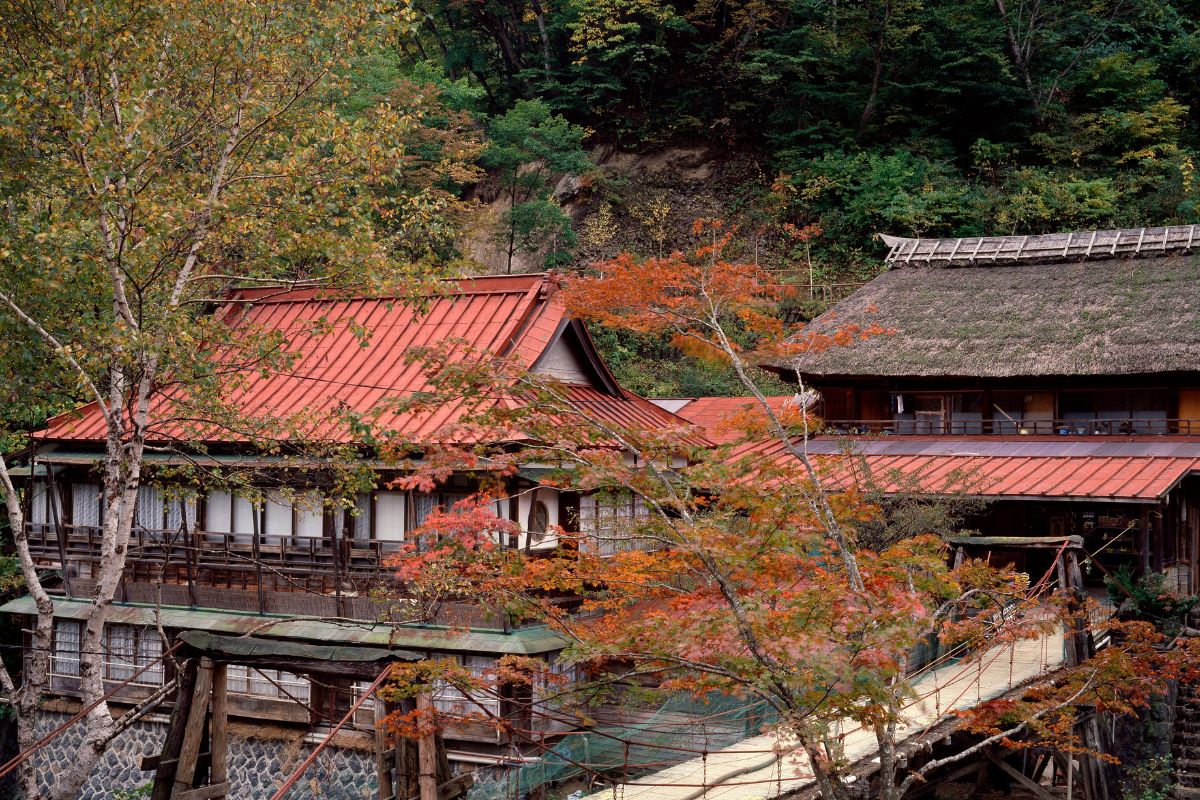
With one of the largest open-air outdoor baths, you can enjoy the sights of nature while soaking in the hot spring. The onsen is up in the mountains in Gunma Prefecture and can be accessed by train or bus.
In this guide, we will detail how to get to Takaragawa Onsen from Tokyo. This will include by train and then by bus.
We will also look at why you should visit Takaragawa Onsen including the different baths and the rates.
Getting To Takaragawa Onsen By Train And Bus
One of the best ways to get across Japan is by train and that’s certainly the case for most of the journey to get to Takaragawa Onsen.
From Tokyo Station, take the JR Joetsu Shinkansen all the way to JR Jomokogen Station which should take around one and a half hours.
Alas, that’s where the train ride ends but there is a bus and a further shuttle bus available for the final couple of legs of the journey.
The Bus To Minakami Station
After the train journey, you will need to take a bus which goes to Minakami Station.
Once there, you can decide to catch another bus to Takaragawa Onsen Iriguchi and that bus costs 1,050Y where there is a courtesy car to the resort itself.
There are two buses available directly to Takaragawa Onsen from Minakami Station during the day. The first one is at 10.45am and a further one at 1.35pm while it costs 1,150Y for the half-hour journey.
However, if you time your journey properly, you may be able to take a free courtesy bus instead. There are three shuttle buses available, two from JR Jomokogen Station and one from JR Minakami Station.
The trip to Minakami should be picturesque as there are more than a dozen hot springs to be found in the region.
Several resorts have been built amongst the valleys and mountains, including Takaragawa Onsen. Another nearby onsen tucked away in the mountains is Hoshi Onsen which is another rustic ryokan.
Then there is Sarugakyo Onsen which is a resort with a hot spring located next to Lake Akaya.
The Courtesy Bus To Takaragawa Onsen
Should you get to JR Jomokogen Station at either 1pm or 3pm, or to JR Minakami Station at 3.15pm, you can take the free courtesy bus.
Ensure that you make an advanced reservation first yet this is one of the perks of booking at the onsen.
Why You Should Visit Takaragawa Onsen
If there is one standout reason to visit Takaragawa Onsen, it is the open-air outdoor bath.
This is one of the biggest to be found in Japan, it opens ample room and is situated next to the stream of Tone River.
As you dip into the hot spring, you can gaze at nature and the scene changes with the seasons, it’s particularly enjoyable in winter when the snow falls.
The Different Baths
With one of the largest open-air outdoor baths, that should be enough to tempt you away from Tokyo for the day. However, there are a total of five different types of baths including four outdoor baths.
One of those outdoor baths is for females only while the other three are decidedly mixed-gender. Then there is one indoor bath which is separated for males and females.
For the mixed-gender baths, there is a decision to be made regarding whether to go completely naked or not. Visitors can use towels which are provided by the onsen itself.
This is one of the underlying reasons why the onsen proves so popular for visitors from overseas. That hot spring water is also of a noted high-quality with several health benefits. These include for muscle pain, arthritis, and neuralgia.
While Takaragawa Onsen has a huge open-air outdoor bath, the scenery is a huge part of the draw. The onsen also includes a ryokan and the traditional Japanese hotel has several elegant guest rooms.
You can also enjoy a range of authentic Japanese cuisine if you gain an appetite.
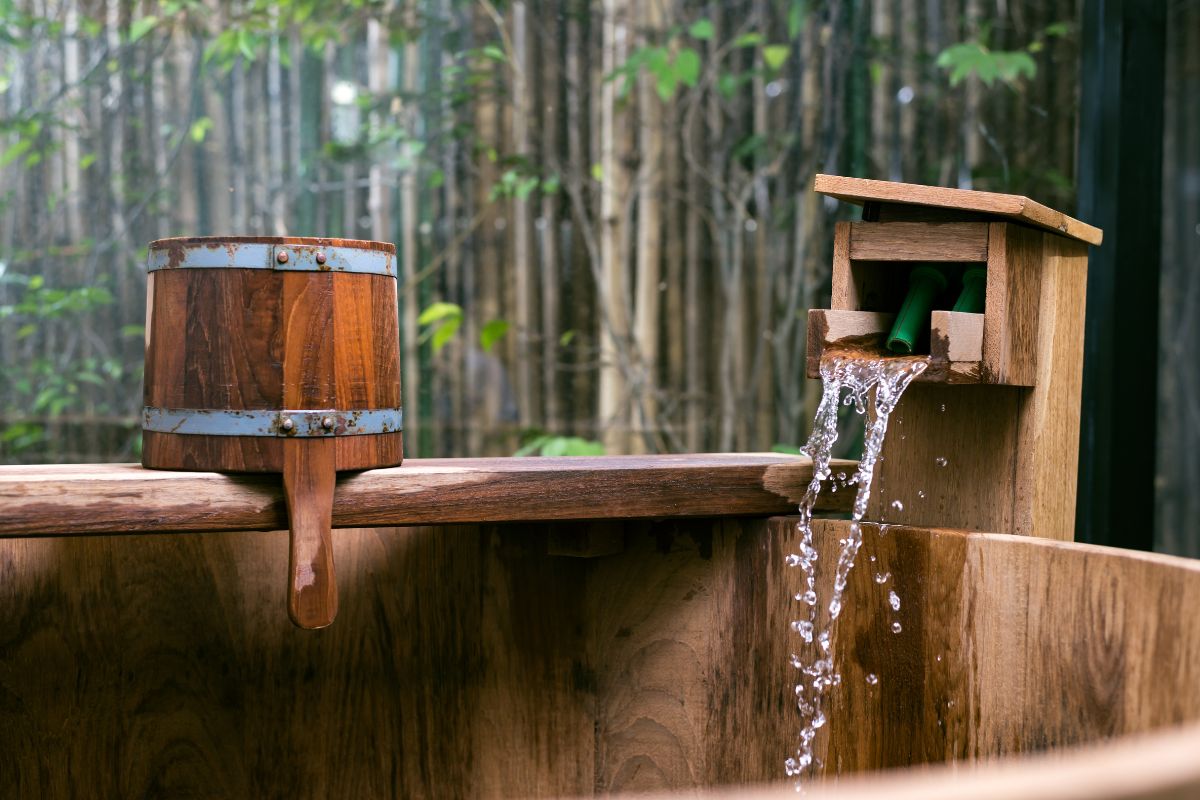
The daily rate for the onsen is 1,500Y and the facilities are open from 9am to 5pm for daily users. Staying at the ryokan starts at around 15,000Y for each person per night.
While the onsen bath is available to visitors during the day, the retreat is ideal for an overnight stay. If you do decide to stay, the onsen bath has a 24-hour availability for those guests who are staying overnight.
Final Thoughts
Takaragawa Onsen is a world-class facility in Gunma Prefecture, a northern mountain village. In 2013, it was named among the top ten hot springs in the world and little has changed since then.
Bathing outfits are insisted upon, which may be a relief for foreign visitors, and the day trip represents a part of authentic Japanese culture and hospitality.
Make sure that you take your camera as the sights to be seen from the onsen are so dreamy they are worthy of being on postcards.
Frequently Asked Questions
What is rare about takaragawa onsen.
The onsen is rare in that it is a hot spring bath that insists on a bath dress. All bathers in the Japanese facility must wear the bathing dress which is required.
The practice of nude bathing, and even using your own bathing suit, is not permitted.
What Different Types Of Accommodations Are Available At The Ryokan?
Each guest suite in the Main Building comes with a washroom and also comes with a living-room heating system too. The Main Building suites were established back in 1955 and were built from pine trees.
There are six guest suites on the first floor, five guest suites on the second floor, and another five guest suites on the third floor. Both the second and third floors also have a pantry.
The rooms on the First Annex are also built from wood and were established even earlier, in 1936.
In this two-storey building, there are three guest suites on both the first and second floors, each with a living room heating system.
The East Building is newer, even though it was built from iron and concrete in 1966. On the first floor, there is a pantry, a restaurant, a dressing room, and a public bath.
On the second floor of the East Building, there is a pantry and six guest suites, five come with a bathtub and another has a washroom.
There is a single guest suite on the third floor which has a front lobby. Every guest suite on the fourth and fifth floors comes with a washroom for that extra touch of luxury.
There are eight guest suites on the fourth floor (with a pantry) and six on the fifth floor while the East Building also has a banquet hall on the fifth floor.
- Recent Posts
- 16 Best Websites To Watch Japanese Movies With English Subtitles - May 11, 2023
- Is ZIPAIR The Best Airline For Traveling To Japan? - May 11, 2023
- Ryu Murakami Vs Haruki Murakami – Which One Should You Read? - May 11, 2023
Related Posts:
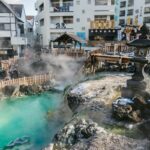
- Things to Do
- Food & Drink
- Shopping & Style
- Coca-Cola Foodmarks
- Restaurants & Cafes
- Music & Nightlife
- Neighborhoods
- Los Angeles

Ultimate guide to Nozawa Onsen ski resort: where to stay, what to do, when to go
For a relaxing ski and onsen holiday, Nagano’s lesser known winter wonderland is just a short trip from Tokyo

The little ski village of Nozawa Onsen often gets overlooked by overseas travelers in favour of more popular snowy escapes like Niseko in Hokkaido prefecture. However, this delightful Nagano destination, which is just two hours from Tokyo, is brimming with good food, fine snow, lots of character and plentiful cultural experiences.
Both fun and affordable, Nozawa Onsen gives you a little bit of everything, from a wide array of snow-heavy ski slopes to a myriad of natural hot springs within the village. Which is why the winter wonderland of Nozawa Onsen should be your next travel destination – even if you can’t ski.
RECOMMENDED: Most beautiful winter destinations in Japan

Getting there
To get to Nozawa Onsen from Tokyo, hop on the JR East Hokuriku Shinkansen bound for Nagano at either Tokyo Station or Ueno Station. It takes about 90 minutes to reach Iiyama Station, where you’ll switch to the Nozawa Onsen Liner that will take you directly to the ski resort in roughly 25 minutes.

Whether you’re skiing, snowboarding, snowshoeing or Snowscooting (like snowboarding and BMX had a love child), you’ll find everything you need at Salomon Station rental shop. To borrow gear, you’ll need to register your email address on the shop’s website and fill out an online application form (services available from November 25 2023).
The process is fairly quick; it can be done on your smartphone at the venue. Once you’ve filled out the form (specify the kind of equipment you need and for how many days), show the confirmation screen to the staff and they will get you kitted out for the day. Ski and snowboard sets are available for ¥5,000 per day for adults (¥4,000 for children). You can also rent outerwear for ¥3,500 a day if you need some extra layers.

Hit the slopes
The Nozawa Onsen snow resort boasts 46 runs in total, including standard slopes, half pipes and cross country training facilities. The 20 ski lifts mostly operate from 8.30am to around 4pm or 4.30pm, depending on which part of the mountain you’re on.
Slopes are classified in three levels of difficulty. The easiest slopes (indicated in green) can be found on the bottom half of the mountain and they make up about half of the courses. Intermediate slopes, on the other hand, are indicated in red while the black slopes are the most challenging.
If you’re just starting out or feeling a little rusty, practice on short, mellow runs like the Nagasaka course before hopping on a gondola for the longer Uenotaira slope (roughly 2km). Meanwhile, confident skiers and snowboarders can head to the Yamabiko area on the top of the mountain where you’ll be treated to breathtaking views of surrounding peaks. On a clear day, you can even see the Sea of Japan in the far distance. There are five slopes to ski down from the summit, but they’re all classified as intermediate level so make sure you know what you’re doing before going all the way to the top.
Ski and snowboard lessons are available in English. But if you’re an avid skier looking for adventure, you might be interested in joining a backcountry tour (from ¥15,000 per person for a seven-hour tour).
With all the different tracks to zip through, expect to be knackered by the early afternoon. To refuel, pop into one of the mountain huts for a hearty katsu curry paired with a crisp cold beer. Alternatively, swing by the Mt Dock Gondola Cafe for some carrot cake and a hot drink before catching the lift for one last run.

Staying in the village
Accommodation rates fluctuate depending on the time of year, but the good news is that Nozawa Onsen offers options for every budget from cheap and cheerful inns to luxurious bed and breakfasts. If it’s comfort you’re after, look no further than Residence Yasushi . The B&B offers a good balance of Japanese and Western styles – in its interior design as well as the food menu – so you’ll never feel far from home. At the end of a long day on the slopes, you can wrap yourself in a duvet and watch Netflix from the flat screen in your room, or curl up with a book by the wood stove in the cosy lounge.
Travelling in a group? You might want to book a whole apartment. The Shirakaba ryokan and Nozawa Gondola Apartments are both within walking distance of the main ski area and are well suited for groups of up to six and 10 people, respectively. The Nozawa Gondola Apartments has a modern chalet feel to it while the ryokan offers a more traditional experience with tatami mat rooms and Japanese futon.
Before you pass out on your futon, though, you’ll want to do some hot spring hopping between the village’s free bathhouses.

Onsen hopping
As a historical onsen area that flourished in the Edo period (1603-1867), Nozawa Onsen is as famous for its natural hot spring baths as it is for its ski slopes. The 13 bathhouses are housed in unique, Edo-style structures that are easy to distinguish when walking through the village centre. Plus, they are all free.
Careful when dipping in – these alkaline waters can be hot enough to cook eggs in (no, really). While the sotoyu (public baths) typically range from 45 to 49 degrees celsius, there are designated egg boiling stations in the town centre where you can slow cook your very own onsen tamago in the free-flowing spring water, whose temperature can reach up to 90 degrees celsius.
There’s one extra bathhouse that isn’t officially considered to be one of the 13 sotoyu – but it’s worth the visit. Built in 2011, the relatively new Furu Sato no Yu is bigger than the other baths and has a more modern feel to it. While it charges a small fee of ¥500, you’ll get amenities like shampoo and conditioner, which the 13 sotoyu don’t offer, as well as two baths each for men and women.

Best time to go to Nozawa Onsen
Nozawa Onsen’s ski season usually runs from December through March, but the best time to go is in January or February, when the powdery snow (colloquially known here as ‘JaPow’) is at its fluffiest. For a jaw-dropping treat, plan your trip so that you’ll be in the area on January 15, when the annual Dosojin Fire Festival takes place.
The fascinating ritual involves the village men staging a battle with burning torches as a way of bringing good fortune to locals. The whole charade can last up to four hours, ending with a magnificent bonfire and lashings of sake.
More winter destinations

Best ski resorts near Tokyo
Looking to plough through powdery slopes this winter? These idyllic ski villages are easily accessible via train or bus from Tokyo

Best illuminations and light displays in Japan
- Things to do
Get out of Tokyo to see some of Japan’s biggest and most spectacular winter light shows, from Nagasaki to Aomori

JR rail passes for foreign tourists visiting Japan
Tourists with foreign passports can explore Japan on a discount with these affordable train passes by JR
[image] [title]
Discover Time Out original video
By entering your email address you agree to our Terms of Use and Privacy Policy and consent to receive emails from Time Out about news, events, offers and partner promotions.
🙌 Awesome, you're subscribed!
Thanks for subscribing! Look out for your first newsletter in your inbox soon!
- Terms of use
- Work for Time Out
- Time Out Group
- Advertising
- Modern slavery statement
- Manage cookies
Time Out Tokyo
- Magazine subscription
- Digital edition
- Buy the guide to Tokyo
Time Out products
- Time Out Worldwide
- Skip to main content
- Skip to primary sidebar

Destinations
- Plan Your Trip
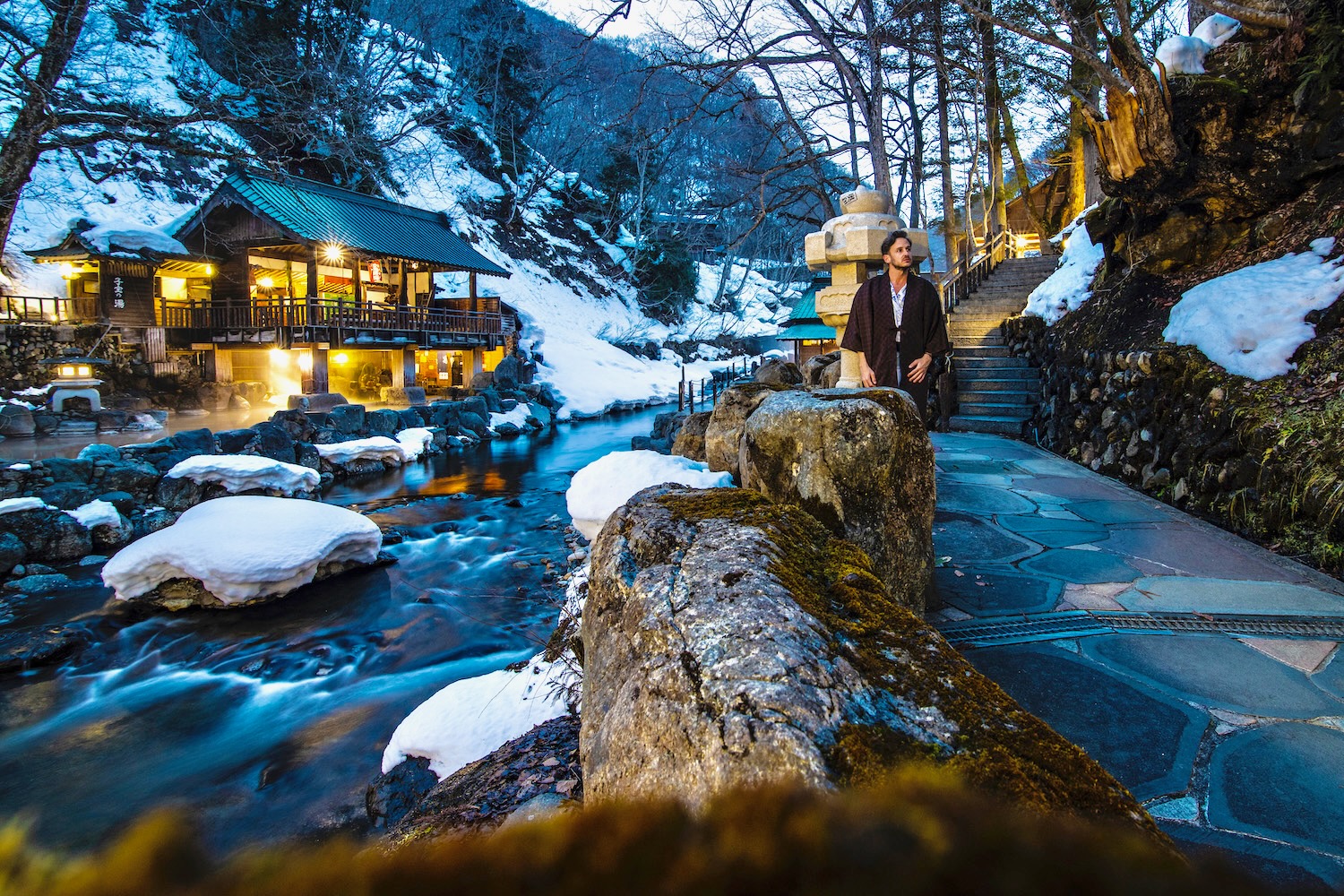
How to Soak in Japan’s Best Onsen
February 21, 2023 by Robert Schrader Leave a Comment
Onsen hot springs are as ubiquitous in Japan as stupidly cute things and cherry blossoms , so to the outside observer, a desire to find and stay in the best onsen in Japan might seem pointless.
It isn’t pointless, of course, a fact that will become almost immediately evident when you set foot onto the grounds of Takaragawa Onsen . Located in the foothills of the Japanese Alps about 90 minutes north of Tokyo by Shinkansen bullet train, this is one of my favorite places I’ve ever stayed in Japan.
The property boasts four outdoor hot springs and a ryokan that straddles—surprise—the Takara River, among its other delights. Whether you’re planning to visit Takaragawa Onsen from Tokyo on a day trip, or plan to stay here overnight as I often do, I have feeling you’re going to want to continue reading.
Takaragawa Onsen Feels Like Home
Most onsen in Japan are just, well, onsen, which is to say hot springs. When I was traipsing through the ancient cedars of Yakushima Island , for example, I would end each day at a local one, paying 200 yen to the old woman waiting in the entrance as I passed by, then relaxing to my heart’s content—but never for the night. At Takaragawa Onsen, on the other hand, the hot spring itself (which I’ll talk about in just a minute) is merely the unifying attraction.
Although I suppose you could simply bathe for the day, you’d be missing out on another amazing aspect of being here, which is staying in the attached ryokan , or traditional Japanese inn. The main building at Takaragawa dates back to 1955, which gives these traditionally-constructed and designed rooms an even more rustic feel. Featuring floor mattresses laid out on tatami mats, with indoor sitting areas that look out over the river, the rooms here are simple, but they’re exquisitely comfortable as well, all part of why I think this might be the best onsen in Japan.
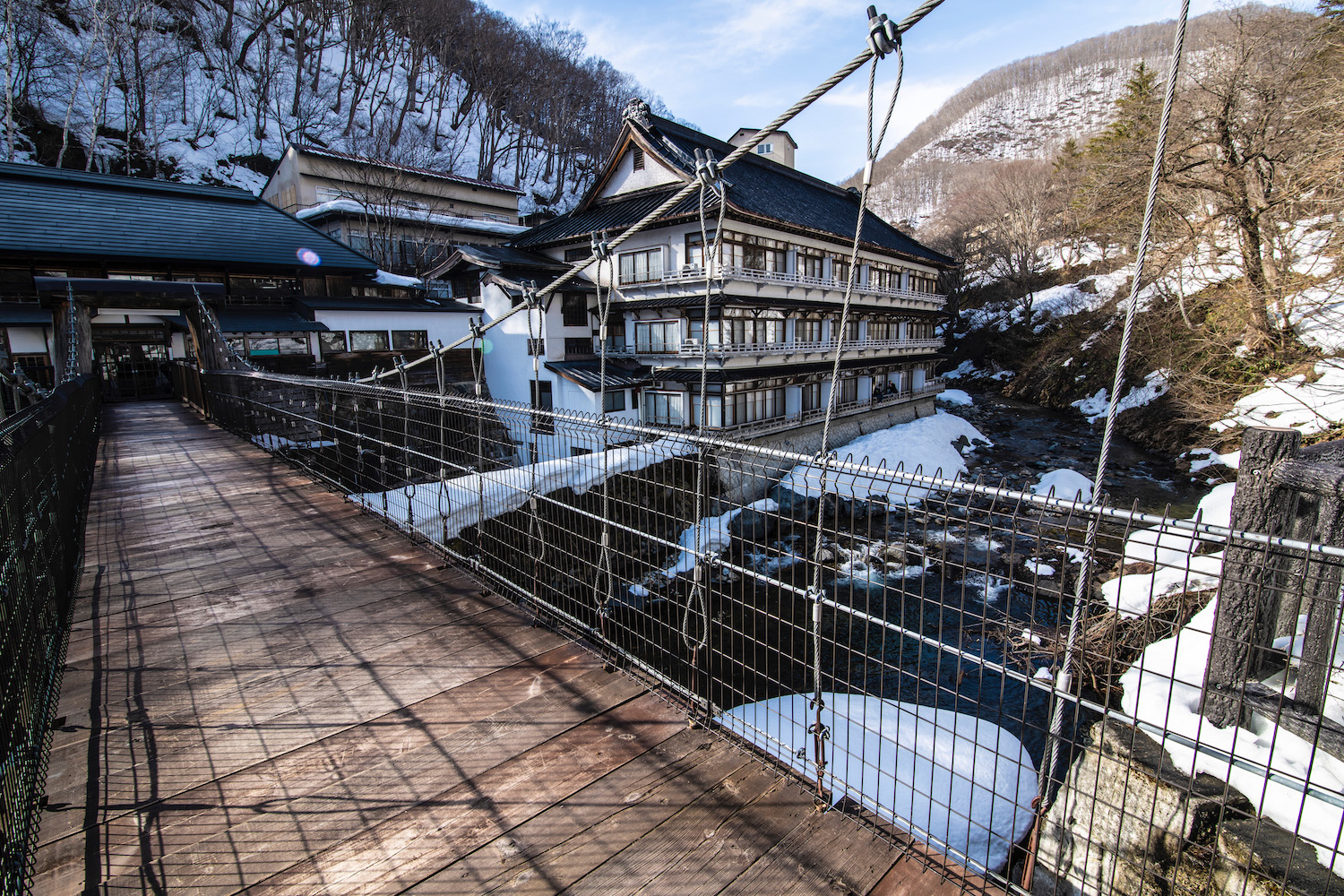
5 Reasons to Visit Takaragawa Onsen
The onsen at Takaragawa very much deserves its reputation as the best onsen in Japan. Or, I should say, their: Four outdoor onsen are available here, three co-ed and one for women only. Regardless of which onsen you choose, or how many other people accompany you, all feature relaxing stone bottoms and walls, traditional Japanese statues and wooden awnings to shield you from the rain and snow that fall here much of the year.
The seasons
Yes, you heard me right: It’s cold here much of the year. In late April, when I first visited, it hovered around 12-13ºC during the day. There were no leaves on the trees; there was still plenty of snow on the ground. In February, when I most recently visited, several feet of snow were on the ground; the air was far below freezing. These examples are to say nothing about the lushness of the green leaves in summer, which turn scarlet and golden in the Japanese autumn .
The convenience
Another great thing about the onsen at Takaragawa is that it’s open 19 out of 24 hours, which means that if you’re a night owl or an early bird, you can essentially enjoy a private onsen in Japan while everyone else is sleeping. Many onsen in Japan have short operating hours, which is not the case here. You can bathe as early at 5 AM, and as late as midnight.
In spite of its fair price, Takaragawa affords guests incredible luxuries, such as private dining rooms and microbrewed sake . Indeed, no matter how much money you end up paying to stay here, there’s something to be said about the sublime relaxation a couple of nights here affords, whether it’s at the end of one month in Japan or caps off a much shorter trip.
Even if you spend just one night at Takaragawa Onsen, it feels like taking a graduate-level course in Japanese cuisine, whether you enjoy crispy seafood tempura with green tea salt, prepare shabu-shabu and grilled fish right at your table or enjoy cold dishes like pickled umeboshi plum and, of course, sashimi , all served kaiseki -style in a private dining room.
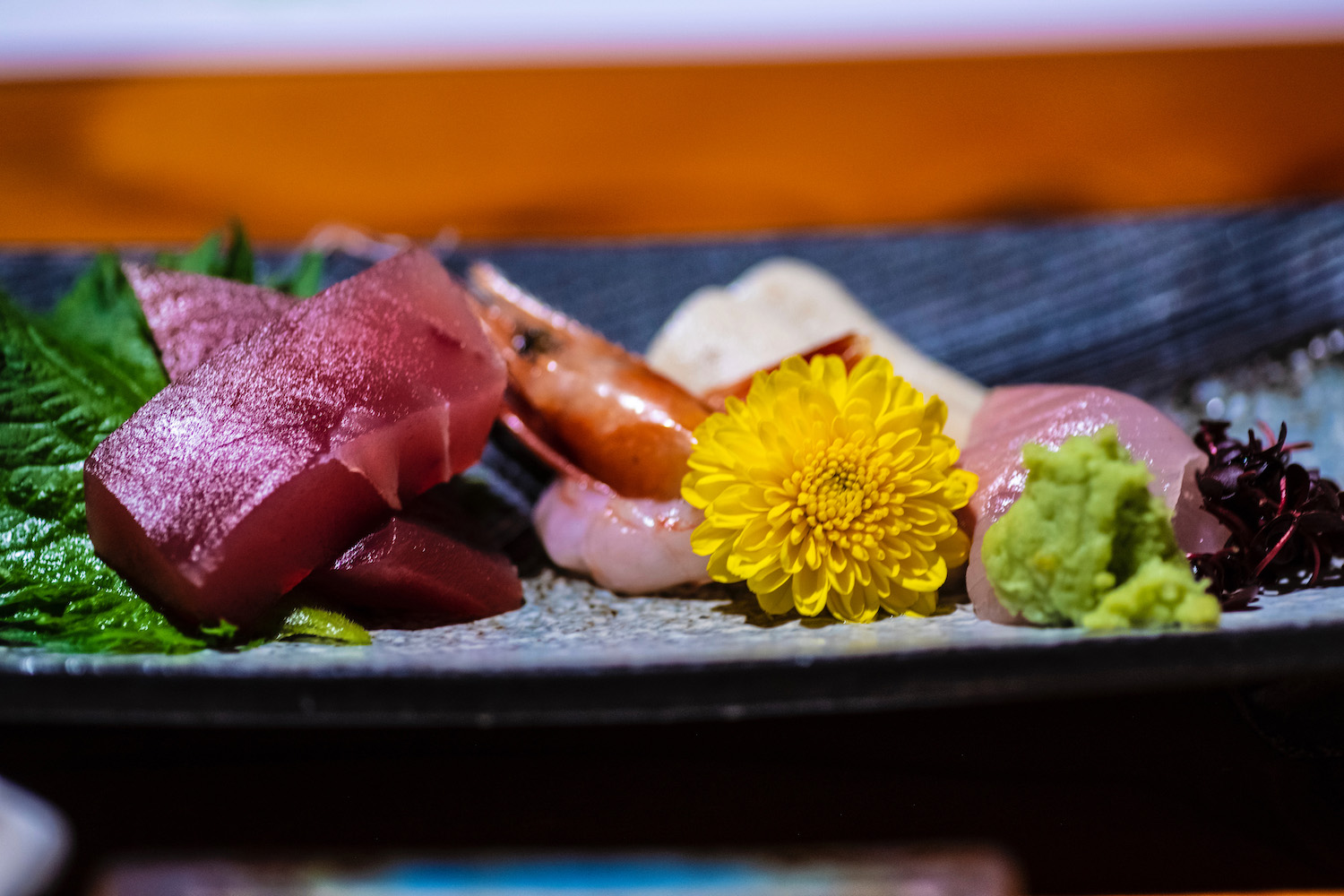
How to Get to Takaragawa Onsen
Even if you don’t end up loving Takaragawa Onsen quite as much as I do, it’s undoubtedly the best onsen near Tokyo. And it is very near Tokyo, to the extent that I often recommend it as a last stop on the custom Japan itineraries I plan for travelers —many head straight from Takaragawa to Haneda or Narita airports .
From Tokyo Station, you’ll want to ride the Joetsu Shinkansen northward to Jomo-Kogen, where shuttle buses to Takaragawa Onsen (you’ll need to reserve your spot at the time of booking) depart a couple of times per day. Depending on the location of your hotel in Tokyo, door-to-door travel time should be under three hours. While most people opt to stay here overnight, it is possible to do a Takaragawa Onsen day trip if you time things just right.
Other FAQ About Takaragawa Onsen
How do you get from tokyo to takaragawa onsen.
To reach Takaragawa Onsen from Tokyo, ride the Joetsu Shinkansen to Jomo-Kogen station, where shuttles for Takaragawa Onsen will take you onward to the ryokan . Note that you need to reserve your place on these vehicles (which are complimentary) in advance, ideally at or just after the time of booking.
Can I go to Takaragawa Onsen if I have tattoos?
Takaragawa Onsen, like most privately operated onsen in Japan, does allow guests with tattoos to bathe. However, out of cultural consideration for the Japanese guests at the hotel, you could consider covering up your tattoos if possible. Absent this, you might bathe early in the morning or late in the evening for the sake of discretion.
How much does Takaragawa Onsen cost?
Takaragawa Onsen offers a variety of accommodation plans, from à la carte rooms, to room-and-board plans with breakfast and dinner, including the option to enjoy food and drink in private dining rooms. Although you can sometimes find rates as low as ¥10,000 per night, the average person spends between ¥20,000-40,000 per night at Takaragawa Onsen.
The Bottom Line
Takaragawa Onsen is probably my favorite hot springs hotel in Japan. Superlatives notwithstanding, the reality of Takaragawa Onsen—a heritage inn set in a heavily wooded ravine, which dramatically displays all four of Japan’s seasons as you bathe amid them outdoors—is enticing to anyone with a pulse. The question (once you commit to visiting, of course) is how many nights to stay, and how to integrate this magical place into your larger Japan trip. Do you sleep here for a night or two, or take a day trip from Tokyo to Takaragawa Onsen? Answering this question correctly is yet another reason you should consider hiring me to plan your trip to Japan .
Plan Your Japan Trip

Subscribe to email updates!
Words, images and design ©2018-2024 Robert Schrader, All rights reserved. Read Privacy Policy or view sitemap .
- Media & Industry
- Meetings & Events
- Select Language 简体中文 繁體中文(香港) 繁體中文(臺灣) India (English) Bahasa Indonesia 한국어 ภาษาไทย Tiếng Việt Singapore (English) Philippines (English) Malaysia (English) Australia/New Zealand (English) Français Deutsch Italiano Español United Kingdom (English) Nordic countries(English) Canada (English) Canada (Français) United States (English) Mexico (español) Português العربية Japan(日本語) Global (English)
- India (English)
- Bahasa Indonesia
- Singapore (English)
- Philippines (English)
- Malaysia (English)
- Australia/New Zealand (English)
- United Kingdom (English)
- Nordic countries(English)
- Canada (English)
- Canada (Français)
- United States (English)
- Mexico (español)
- Global (English)
- Fujiyoshida
- Shimonoseki
- Ishigaki Island
- Miyako Island
- Kerama Island
- Tokyo Island
- Koka & Shigaraki
- Hida Takayama
- Ginza, Nihonbashi
- Beppu & Yufuin (Onsen)
- Ginzan Onsen
- Nagasaki Islands

- Kumano Kodo
- Shikoku Karst
- Amami Oshima
- Hachimantai
- Omihachiman
- Aizuwakamatsu

- Diving in Japan
- Skiing in Japan
- Seasonal Flowers in Japan
- Sustainable Outdoors
- Off the Beaten Track in Japan
- Scenic Spots
- World Heritage
- Home Stays & Farm Stays

- Japanese Gardens
- Japanese Crafts
- Temple Stays
- Heritage Stays
- Festivals and Events
- Theater in Japan
- Japanese Tea Ceremony
- Cultural Experiences in Japan
- Culture in Japan

- Local Cuisine Eastern Japan
- Local Cuisine Western Japan
- Local Street Food
- Japan's Local Ekiben
- Japanese Whisky
- Vegetarian and Vegan Guide
- Sushi in Japan Guide
- Japanese Sake Breweries

- Art Museums
- Architecture
- Performing Arts
- Art Festivals
- Japanese Anime and Comics
- Japanese Ceramics
- Local Crafts

- Scenic Night Views
- Natural Wonders
- Theme Parks
- Samurai & Ninja
- Iconic Architecture

- Wellness Travel in Japan
- Japanese Ryokan Guide
- A Guide to Stargazing in Japan
- Relaxation in Japan
- Forest Bathing (Shinrin-yoku)

- Experiences in Japan
- Enjoy my Japan
- National Parks
- Japan's Local Treasures
- Japan Heritage
- Snow Like No Other
- Wonder Around Japan

- Visa Information
- Getting to Japan
- Airport Access
- COVID-19: Practical Information for Traveling to Japan
- Anime Tourism
- Countryside Stays
- Accessible Tourism
- Hokkaido Great Outdoors
- Scenic World Heritage in Tohoku
- Shikoku’s Nature and Traditions
- Southern Kyushu by Rail

- Traveling by Rail
- How to Travel by Train and Bus
- JR Rail Passes
- Scenic Railways
- Renting a Car
- Sustainable Travel in Japan
- Travel Brochures
- Useful Apps
- Online Reservation Sites
- Eco-friendly Accommodation
- Luxury Accommodations
- Traveling With a Disability
- Hands-free Travel
- How to Book a Certified Tour Guide
- Volunteer Guides
- Tourist Information Center

- Japanese Manners
- Spring in Japan
- Summer in Japan
- Autumn in Japan
- Winter in Japan
- Cherry Blossom Forecast
- Autumn Leaves Forecast

- Japan Visitor Hotline
- Travel Insurance in Japan
- Japan Safe Travel Information
- Accessibility in Japan
- Vegetarian Guide
- Muslim Travelers
- Safety Tips

- JAPAN Monthly Web Magazine
- Arts & Cultures
- Nature & Outdoor
- Festivals & Events
- Insider Blog
- Things to do
- Local Guides
- Food & drink
- Traditional
- Hokuriku Shinetsu

My Favorites
${v.desc | trunc(25)}
Planning a Trip to Japan?
Share your travel photos with us by hashtagging your images with #visitjapanjp
- Yamagata City & Around
Ginzan Onsen 銀山温泉
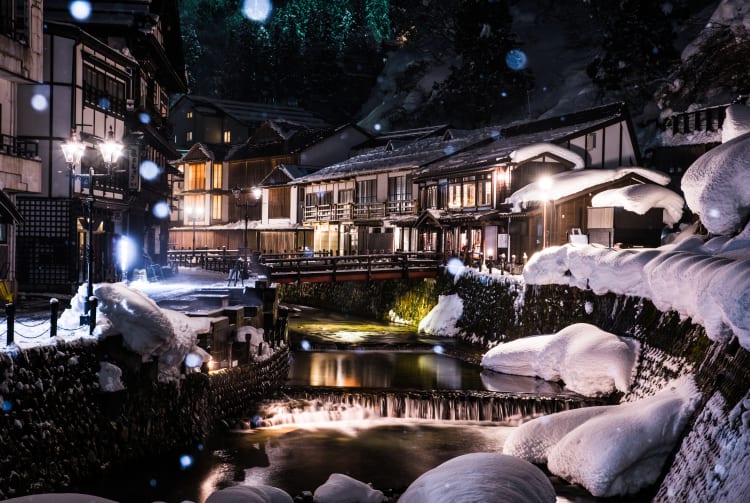
Ginzan shinhata, Obanazawa-shi, Yamagata-ken
- View on Google Maps
- Get Transit Info
Unwind, relax and step back in time
Founded on the site of a former silver mine in rural Yamagata, Ginzan Onsen Hot Spring caters to discerning guests with a taste for old-world atmosphere.
Traditional inns line the river to create picturesque scenes more evocative of a Taisho period (1912-26) novel than a modern resort. It's a long way from big city life and well worth the trip.
- Stroll along Ginzan River and the town's pedestrianized streets in your yukata
- Visit Shirogane Park and cool yourself by its waterfalls
- Stay overnight and dine at one of Ginzan Onsen's many hot spring inns
- Take an outdoor rotenburo bath or enjoy a private kashikiri soak
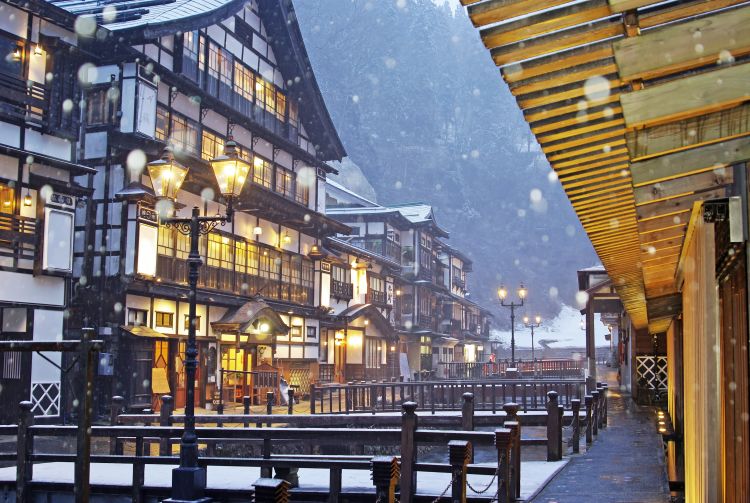
How to Get There
Ginzan Onsen can be accessed by a combination of JR trains and buses.
Visitors traveling by car are required to park at a designated parking area outside the town center. Many inns offer a shuttle service into town from the lot.
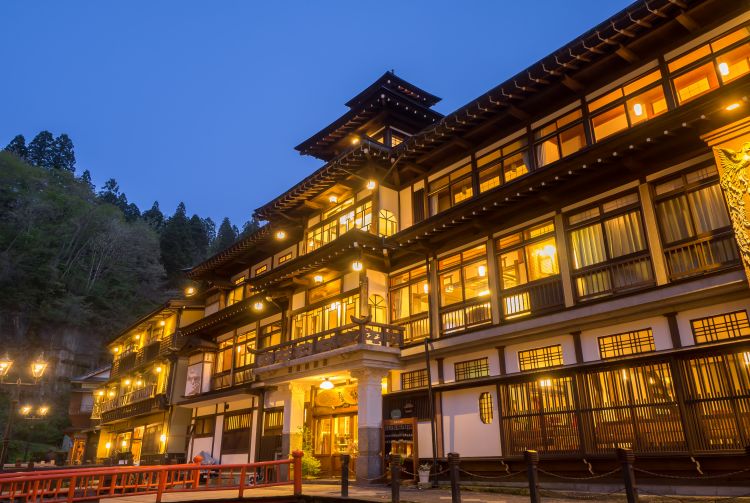
Get to know the onsen-kyo
Popular among Japanese travelers, the term onsen-kyo is associated with small, quaint towns and cozy inns that offer accommodation, food and hot spring bathing. As weekend retreats, they are popular with all age groups, from young families to retirees. This cherished aspect of travel in Japan often goes unnoticed by foreign visitors, so live like a local and dive into onsen-kyo culture.
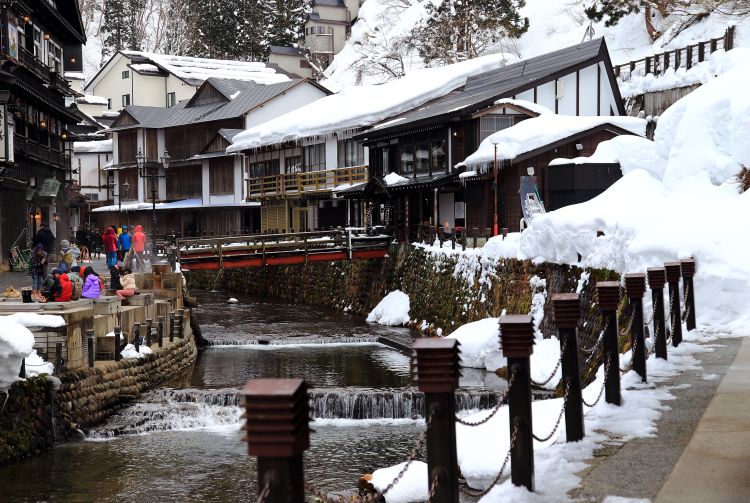
The area is a car-free town center with no modern buildings in sight.
Having checked into one of the town's many inns, visitors walk the streets without the usual concern of cars zipping past to beat the traffic light.
In the proud tradition of Japanese inns, Ginzan Onsen's ryokan offer up sumptuous local dishes to meet the standards of their mostly Japanese clientele.
Such stuff as dreams are made of
Beautiful buildings surrounded by an unspoiled rural setting ensure that Ginzan Onsen is pleasant all year round. Long summer days are perfect for lazy strolls down idyllic streets in a yukata. In winter, the town really works its magic. The sight of the buildings blanketed in snow and illuminated by the soft glow of gaslights leaves a lasting impression.
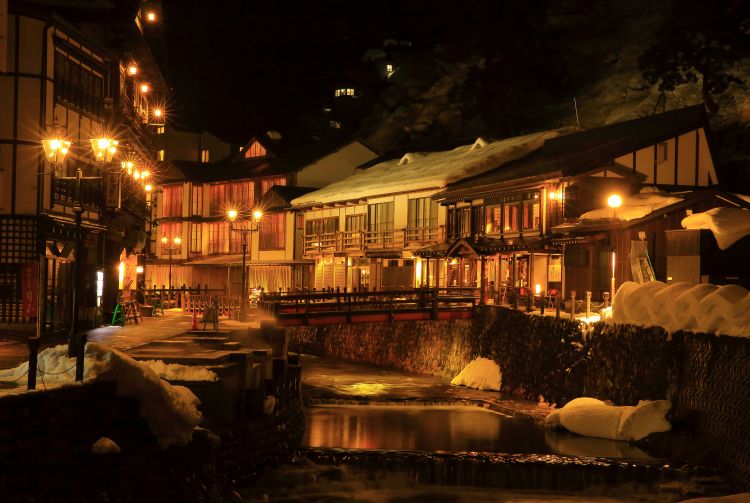
The finer points of hot spring bathing
Rotenburo are outdoor baths-usually hidden from outside view-which allow you to take in the surrounding scenery from the comfort of a hot spring. Another attractive option is arranging a kashikiri session in a private bath, whereby you and traveling companions can have a tub all to yourselves for a short time.
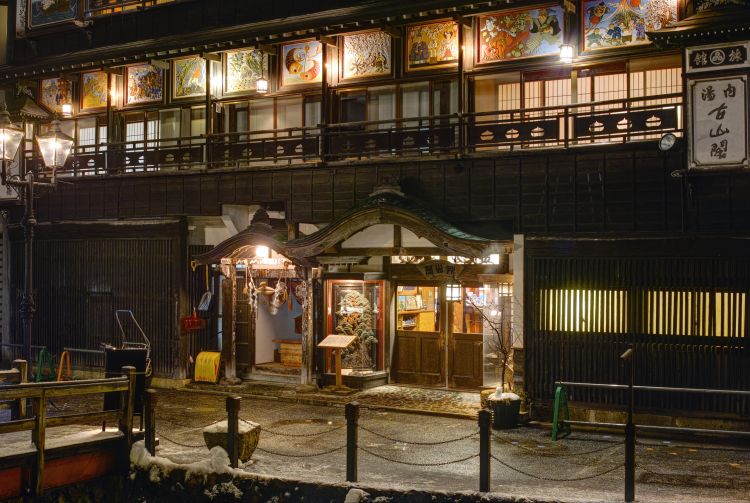
Silver everything
Unsurprisingly for a town founded on a silver mine, Ginzan Onsen takes both its name (literally, Silver Mountain) and iconography from the element. The popular Shirogane Park boasts an impressive 22 meter tall waterfall, and you'll also find an illuminated cave which is well-lit and ideal for taking pictures.
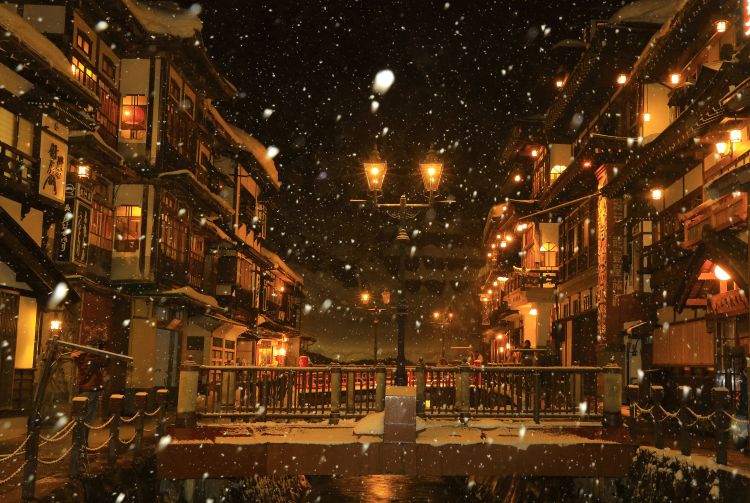
Old meets new meets old
Ginzan Onsen's one notable concession to modernity is the Fujiya ryokan, a striking building designed by famed architect Kuma Kengo. With a blend of modern and traditional elements, including the incorporation of bare timber and white plaster, it stands out from its surroundings while also keeping one foot firmly in the past.
* The information on this page may be subject to change due to COVID-19.
- Hot Springs (Onsen)
Recommended for You
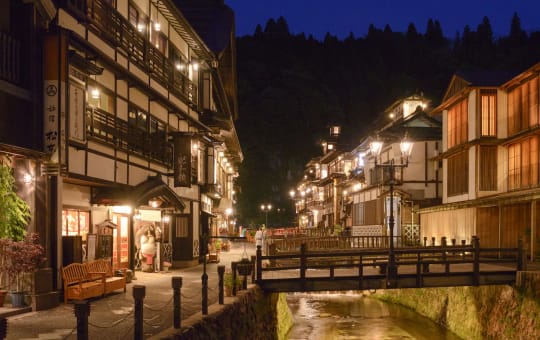
Please Choose Your Language
Browse the JNTO site in one of multiple languages
A Complete Guide to Hakone Onsen | A Short Trip Away From Tokyo
Published on 2022-04-26 by Sakura Mobile

Hakone is a famous onsen town, known for its hot spring water and fresh air, located only 80 minutes away from Shinjuku Station (Tokyo).
If you want to experience traditional Japanese culture while staying within a few hours of the city, put a trip to Hakone on your itinerary when you visit Tokyo. I, as a member of Sakura Mobile Blog Team, have created a complete guide to Hakone so that even first-time visitors to Japan can enjoy Hakone and its Onsen 120%. I have actually been to Hakone many times! This guide is based on my own experience and I tried recommending the most interesting things around Hakone.
This article will help you find the best onsen ryokan, things to do, recommended food, restaurants, and more!
Have you booked your SIM card or pocket WiFi for your trip to Japan yet?
In Japan, you’ll want to be connected without missing out on high speed data and internet!
By reserving online before departing, you can
- Lower your rental fees
- Avoid stock shortages at the airport
To learn more about data and WiFi options for your trip, check out our products below.
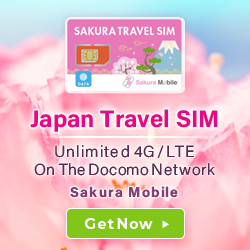
Hello readers! Sakura Mobile is a SIM & WiFi service provider for international residents and tourists in Japan.
Our global editorial team living in Japan will introduce the charms of the country based on what we have actually experienced and felt.
Table of Contents
- What kind of place is Hakone Onsen?
- Introducing Hakone Onsen’s charms
- Ryokan and hotels at Hakone Onsen
- Things to do in Hakone
- Food and restaurants around Hakone Onsen
- Two-day one-night travel itinerary
- When to visit Hakone Onsen
- How to get to Hakone Onsen
- Hakone Onsen map
- Things to keep in mind
1. What kind of place is Hakone Onsen?

Hakone Onsen is a hot spring town just a short trip away from Tokyo. Located on the southwest side of Kanagawa Prefecture and at the base of the tallest mountain in Japan, Mount Fuji.
Hakone is a historic town that was a checkpoint created on the Tokaido highway. It connected Edo (Old Tokyo) with Kyoto. One of the main roles of the checkpoint was to control weapons from coming into Edo and the families of feudal lords from fleeing their captivity in the capital. Travelers here were stopped by guards and had their travel permits and cargo checked.
As travelers rested in Hakone before starting the home stretch of their journey to Edo, they enjoyed the natural healing effects of the Onsen water in Hakone. There are many different sources throughout Hakone Onsen, but the main benefits include helping with joint and muscle pain, healing cuts and burns, moisturizing dry skin, helping with insomnia, and increasing blood circulation.
Before Covid, over 20 million people would visit Hakone every year, or about 50,000 every day. It has slowly been getting back to its pre-covid number of visitors and is one of the most visited places by Japanese and international tourists alike.
↑ Go back to the table of contents
2. Introducing Hakone Onsen’s charms
Hakone has plenty of charms and things that you can’t experience in Tokyo. This section will introduce 3 of the best parts of Hakone Onsen that we think you shouldn’t miss.
Enjoy the nature of Hakone

Something hard to do in Tokyo is enjoy nature and fresh air. Of course, there are plenty of parks like Yoyogi, but they can’t compare to the amazing nature of Hakone.
Hakone is just a small piece of the larger Fuji-Hakone-Izu National park. Enjoy Lake Ashinoko and the surrounding forests that stretch out as far as the eye can see. On clear days, you can enjoy views of Mount Fuji.
Many of the attractions in Hakone are based on nature, like Owakudani, the natural hot spring volcano, Gora Park, the beautifully kept park in the center of Gora, and Hakone Shrine, a shrine with a large red tori gate on the banks of Lake Ashinoko.
Enjoy the art

Hakone is packed full to the brim with amazing museums. Take a stroll through gardens with art installations or have a peaceful meal at a cafe that’s attached to a museum.
The Hakone Open-Air Museum has over 100 sculptures on display around its gardens. You can enjoy the works of the greats like Picasso while strolling around the gardens. Climb the complex Symphony of Happiness stained glass sculpture.
Or check out the POLA Art Museum and enjoy contemporary works that blend with the nature that surrounds them. Explore the nature walk and the surrounding forest while appreciating the large sculptures that don’t disrupt the flow of nature.
Enjoy the various onsen

Hakone has been home to some of the most famous onsen in Japan. People travel from all over the world to enjoy the healing and beautifying effects of the mineral-rich waters. Relax in a warm bath while breathing the fresh air in the Japanese wilderness.
To enjoy the waters, book a hotel or Japanese ryokan that has an onsen, or find a place that accepts daytime visitors. If you get nervous being nude around strangers, just know that you are not alone. Book a room with a private outdoor onsen attached or choose a hotel that has a private onsen that you can rent.
3. Ryokan and hotels at Hakone Onsen
Up next are a few ryokan and hotels that we recommend staying at when you visit Hakone. There are a few different price points, but if you want a more in-depth review of more ryokan in Hakone, check out the article below.
- Hotels with private onsen in Hakone
Hakone Yumoto Onsen Hotel Nanpusou

Take a taxi for 5 minutes or take a 20-minute walk from Hakone Yumoto Station to get to Hotel Nanpusou. Forget the hustle and bustle of the city and relax in nature here!
You can book a room with open-air onsen attached, a Japanese-style room, or a Western-style room. A plan with 2 meals and 1 night starts at around 13,000 JPY per person. We recommend getting the meal plan, as they serve a traditional Japanese course meal for dinner that features many seasonal items.
The inn is popular among Japanese for its reasonable prices and great Japanese hospitality. From the outdoor onsen, you can hear the river. If you want to experience traditional Japanese culture in Hakone, do it while relaxing in an outdoor onsen at Hotel Nanpusou!
- Onsen Hotel Nanpusou

Gora Kadan is a luxury hotel with an amazing and traditional Japanese atmosphere. Almost every room that they offer is different, and most come with their own private open-air onsen. They are a short 3-minute walk from Gora station, but if you give them a call when you arrive, they’ll send a car to pick you up!
Gora Kadan is expensive compared to other ryokan in the area, but the experience and hospitality are unmatched! If you want to splurge on your trip to Hakone, definitely choose Gora Kadan.
Tonosawa Ichi no Yu Honkan

If you’re interested in traditional Japanese experiences, Ichi no Yu has been in business for over 390 years. They have retro indoor baths, Taisho Modern-style family baths, and guest rooms with open-air baths for the full Hakone hot spring experience. They have a ton of different types of plans and meal sets, so you can choose whichever experience will suit your needs best!
If you’re trying to save money on your trip to Japan, just know you can get the full traditional experience, with 2 meals and 1 night costing 9,870 JPY at Ichi no Yu Honkan.
- Tonosawa Ichi no Yu
Hotel Green Plaza Hakone

If you want a beautiful view of Mount Fuji and the surrounding mountain range, Hotel Green Plaza Hakone is a good choice. Green Plaza is located 860 meters above sea level, a 3-minute walk from Ubako Station on the Hakone Ropeway.
On clear days, you’ll be able to enjoy Mount Fuji from the open-air baths. They have rooms with tatami mats and beds, so you can enjoy traditional Japanese flooring without having to sleep on the floor! Hotel Green Plaza is a convenient location for sightseeing around Hakone, and 2 meals and 1 night starts from 14,000 JPY.
- Green Plaza Hakone
4. Things to do in Hakone
Next are a couple of things that we recommend doing when you visit Hakone. They are split up into categories based on themes.
Activities – Nature

Owakudani is one of the stops on the Hakone Ropeway. It’s an active volcanic zone and was created the last time Mount Hakone erupted over 3000 years ago. Owakudani is known for the black hard-boiled eggs that are cooked in the sulfurous waters.
On clear days there are good views of Mount Fuji. There are also many hiking trails, but they may be closed off if there is a lot of volcanic activity.
To be honest, the eggs taste just like regular hard-boiled eggs to me, but eating one is said to extend your life by 7 years! Owakudani looks like a place from outer space, so we recommend taking a quick break there to explore the volcanic scenery!
Lake Ashinoko

There are multiple ways to experience and enjoy Lake Ashinoko, but we recommend riding the pirate ship ferry. There are a total of 3 stops, and they make a complete circle. Something to note is that the last ferry is pretty early in the day. The shores of the lake are largely untouched except for around the ports, so you can really take in the beautiful natural Japanese wilderness.
I’ve heard that the views of Mount Fuji over the lake are the best, but when I rode the ferry it was cloudy over the lake and I couldn’t see Fuji. If you have the option, definitely plan to ride the ferry on a clear day!
After riding the Pirate ferry, it’s easy to get back to Hakone Yumoto Station. The ports connect to the Hakone Ropeway at Togendai Station, and Hakone Tozan Bus stops at Hakone-machi and Moto-Hakone ports on the southern sides of the lake. The bus will take you back to Hakone Yumoto Station and will complete the Hakone Freepass loop, a sightseeing circle around Hakone that connects all of the popular destinations around Hakone with public transportation.

Gora Park is a French-style park located next to Gora Station. This park is the perfect spot to relax on a nice day and enjoy the Hakone fresh air. There is a botanical garden and a flower garden, both located in greenhouses within the park. There is also a restaurant in the park that sports a view of the main fountain and tea house.
If you want to take home a personal souvenir from Hakone, visit the Gora Park Craft house. They offer craft activities that range from 1,000 to 5,000 JPY and take less than an hour to finish. Try your hand in glass blowing and etching, pottery, or dried flower arrangements, located just a short walk from Gora Station.
Activities – Museums
Hakone open-air museum.

The Hakone Open-Air Museum is a quick 2-minute walk from Chokoku no Mori Station on the Hakone Tozan Railway. Enjoy sculptures that were designed to fit in perfectly with the surrounding nature. Most of the museum is outside, so if you put this on your itinerary, make sure to plan for the weather!
The paths are lined with huge sculptures, interactive exhibits, mazes, and of course, an onsen footbath. The Picasso Pavilion has over 319 of his works displayed in a way that tells the story of his life and the evolution of his art. Discover hidden lakes and secret art installations as you explore the expansive grounds in Hakone!
POLA Museum of Art

The POLA Museum of Art is a modern art museum built in the middle of the forests of Hakone. It’s designed to blend in with the surrounding nature and the nearby Hayakawa River. It’s filled with thousands of paintings, sculptures, and art installations by Japanese and European artists.
Surrounding the large underground museum is a nature trail where guests can search for sculptures among the beautiful Hakone nature. Listen to the sounds of birds and small animals while exploring the trail. The POLA Museum of Art is only a 15-minute bus ride from Gora station on the Hakone Tozan Bus.
Hakone Glass no Mori

Hakone Glass no Mori is a Venetian Glass museum located in Sengokuhara on the northern side of Hakone. It has Italian-themed buildings, museums, shops, and gardens. They display a collection of over 100 pieces of Italian glassware and even have live Italian ballads periodically throughout the day.
Outside, there is a large pond modeled after an Italian canal. Take a stroll in the garden and enjoy the large sculptures from modern and classical artists. The well-kept trees and flowers among the beautiful Hakone Mountain Range are sure to be breathtaking. Take a Hakone Tozan bus from Hakone-Yumoto Station for 20-minutes to get there.
Activities – Onsen experiences
Hakone kowakien yunessun.

Yunessun is an onsen theme park in Hakone. They offer various unique baths that you can enjoy with your friends and family. Some popular themed baths included a coffee bath made from real coffee, a wine bath, a green tea bath that is supposed to improve your blood circulation, and a Japanese sake bath that warms you up! Just know that none of them are for drinking.
When I went I forgot a towel! Luckily they have a shop where you can rent towels, bathing suits, and anything else that you would need at a water park. If you feel like packing light, or decide to go to Yunessun last minute, don’t worry! You can buy or rent everything that you need to have a fun day when you arrive.
The wine bath was cool and smelled like grapes, but my favorite was the coffee bath! Yunessun is great for people who want to get the rejuvenating effects of the Hakone Onsen water, but aren’t ready to be naked in front of strangers, or for those who aren’t 100% sure about the etiquette of Japanese onsen!
Get to Yunessun by taking the Hakone Tozan bus from Hakone-Yumoto station. If you have tattoos, you will be barred from entering the onsen side of Yunessun. Covered tattoos are allowed in the water park area, a great option if you have tattoos!
Hakone Hot Springs Baths

If you go to Hakone, the most popular onsen resort in Japan, you probably should enjoy the healing effects of the onsen water! There are many different bathhouses, ryokan, and hotels in the Hakone region that you can stay at overnight, or just visit during the day. Many of the ryokan that are open to daytime visitors are located around Hakone-Yumoto station, perfect for resting after a long day of traveling around Hakone before heading back to Tokyo.
If you’re okay with getting in a bath with strangers or are okay with spending a little extra to get a private bath for you and your friends or family, getting in an onsen is a must-do Japanese experience. Check out places like Hakone Yuryo, Yumoto Fujiya Hotel, Kappa Tengoku, and Hakone Kamon for their daytime admission costs.
Activities – History

Visit the Kyukaido, a part of the original Tokaido highway. It was a 500-kilometer stretch of road that connected modern-day Tokyo (or Edo) and Kyoto during the Edo period (1603 to 1868). A short piece had been restored and opened to the public.
The walk is 6 kilometers long and takes about 2 and a half hours to complete. The history of the route can be traced back to the times when travelers walked it in the Edo period. Many of the Ryokan and Hotels in Hakone near the Kyukaido also have long and dated histories.
Hakone Shrine

Hakone Shrine is one of the most famous power spots in the Kanto region with a history of more than 1,200 years. The entrance and grounds are lined with old cedars that create a mysterious atmosphere. If you want, you can definitely experience traditional Japanese culture here.
The famous red tori gate on the shores of Lake Ashinoko is located here. We recommend that you get there early in the morning, as there are almost always long lines of visitors taking pictures at this amazing photogenic spot!
5. Food and restaurants around Hakone Onsen
Next up, we’ll introduce some awesome lunch spots around Hakone that we recommend you stop at if you have the chance.
Restaurant35 (Western food)

Restaurant35 is a restaurant that makes Western-style foods with local specialties and seasonal ingredients from Hakone. Their dishes are made with fish and other seafoods from the nearby Odawara and vegetables from the neighboring city of Mishima. Enjoy course meals that will leave you full paired with wines and dry-aged meats. Their standard course includes 7 different dishes.
During some periods, they require an advanced reservation as ingredients are fresh and limited. Give them a call ahead of time, or make a reservation to enjoy this awesome dining experience in Hakone.
- Restaurant35
Hakone Yashima (Japanese Food)

Hakone Yashima is a traditional Japanese oden restaurant. Oden is a Japanese soup dish that is made up of various ingredients like eggs, daikon, konjac, and fishcakes boiled in soy-flavored soup stock. Oden restaurants are rare in Japan, and the taste of Hakone Yashima is on a different level compared to the flavor of 7-Eleven.
They use a golden soup stock to boil various Japanese vegetables and meats to make them delicious! They make them with high-quality ingredients and mineral-rich spring water from the Hakone onsen source and use a special rice oil when preparing ingredients so as to not destroy the natural flavors.
Hakone Yashima is quick a 5-minute walk from Motohakone Port and something that you shouldn’t pass up if you want to experience a traditional Japanese taste in Hakone.
- Hakone Yashima
Tamura Ginkatsu Tei (Japanese food)

Tamura Ginkatsu Tei is a Japanese restaurant that sells cutlet sets. Katsu is a fried cut of usually pork or chicken with a crust made from panko bread crumbs. Enjoy their specialties like Tofu Katsu and Pork Katsu.
Check out this restaurant, as it’s one of the most popular in Gora. The second-generation owner invented their popular original tofu cutlet stew, which is made from special Hakone Gin tofu, and sandwiched between minced meat, deep-fried, with dashi and egg. If you’re searching for a delicious traditional Hakone food experience, look no further!
Tamura Ginkatsu Tei is a quick 3-minute walk from Gora Station on the Hakone Tozan Railway and Hakone Cable car. Be prepared to wait in line for a while as it’s very popular!
- Tamura Ginkatsu Tei
La Terrazza (Western food)

La Terrazza is an Italian spot with a great lakeside view of Lake Ashinoko. They offer pizza, pasta, salads, coffee, wine, and much more. Eat your fill of delicious foods while taking in the Japanese lakeside views.
They offer more than 30 kinds of Neapolitan pizzas, all baked in an oven imported from Naples! They make their dishes with locally sourced ingredients, so you can enjoy delcious Italian cuisine with the freshest ingredients. When the weather is nice, we recommend eating outside. La Terrazza is located just a few minute’s walk from Motohakone Port.
- La Terrazza
Sushi Miyafuji (Japanese Food)

This cozy sushi restaurant is located near Miyanoshita Station. If you love sushi, definitely check out Sushi Miyafuji. It has become famous for its delicious rice bowl with fresh raw horse mackerel. Every morning, the owner brings in fresh horse mackerel fish from Odawara Port. They mix it with a sweet and spicy sauce and plum paste and serve it over warm rice.
If you want to try some original dishes that you can only experience in Hakone or some fresh sushi, definitely try out Sushi Miyafuji. Try and get there early, as there is usually a line before they even open!
- Sushi Miyafuji
6. Two-day one-night travel itinerary
8:45 Arrive at Shinjuku
If you are going to Hakone from Tokyo, it’s best to go from Shinjuku Station.
Before leaving Shinjuku, make sure to buy the Hakone Freepass ! It’s a money-saving pass that allows you to use Hakone’s public transport unlimited times! With the cost of the pass, you can to Hakone and get around Hakone without worrying about buying tickets and while saving money!
9:00 Depart from Shinjuku
It takes about 80-90 minutes to get to Hakone-Yumoto Station from Shinjuku! We recommend spending a little extra to take the Limited Express Romancecar, which is the most comfortable and fastest way to get there.
10:30 Arrive at Hakone-Yumoto Station
From Hakone-Yumoto Station, you’ll want to head to Gora Station on the scenic Hakone Tozan Railway. In the summer, you’ll be able to see blooming flowers on the way to Gora.
11:15 Arrive at Gora Station
Here, we recommend that you grab lunch at one of the amazing restaurants.
Eat at Tamura Ginkatsu Tei or enjoy a light lunch at COFFEE CAMP .
12:30 Walk to Gora Park
After lunch, take a stroll in Gora Park. Enjoy the flowers and relax in nature or try your hand at creating something at the craft house. If you want to enjoy a traditional Japanese experience, try the teahouse inside the garden and relax on Japanese grass-woven tatami mats. Once you’re done, head towards Sounzan Station on the Hakone Tozan Cable Car.
14:20 Arrive at Sounzan Station
Sounzan station has amazing views, as well as a footbath where you can relax and look over the Sagami Bay on clear days. From Sounzan station you’re gonna want to transfer to the Hakone Ropeway, towards Owakudani station.
14:45 Arrive at Owakudani
Owakudani is a must-see when going to Hakone. It’s a volcanic area where lots of hot water is sourced for onsen in the area. The local specialty is hard-boiled eggs. The shells are stained black from the high levels of iron and sulfur in the hot water. Eating one is said to add 7 years to your life! Afterwards, head back to the ropeway towards Togendai!
15:30 Arrive at Togendai
Togendai is the last stop on the Hakone Ropeway, but that doesn’t mean the fun rides have to stop! Transfer at Togendai to the Hakone Sightseeing cruise. Hop on a pirate ship and set sail on Lake Ashinoko towards Motohakone.
16:30 Arrive at Motohakone
Motohakone is the last stop on day 1. From here, head to your hotel and check-in for the night. Check out nearby shops and pick up some souvenirs.
17:30 Arrive at your Hotel
After a long day of traveling and sightseeing, it’s time to relax! Below are a few hotels around Motohakone that have onsen and offer plans with dinner and breakfast. Finish the day with a soak in Hakone’s healing waters and get ready for tomorrow.
- Hakone Washintei Hougetsu
- Hakone Elegence
- Hakone Fukuya
- HOTEL Ra Kuun
9:00 Breakfast
Most hotels offer meal plans. We recommend paying extra for the meal plan, as it’s not only convenient but usually of high quality. Hotels and Ryokan in Japan like to use locally sourced ingredients and offer an experience or taste that is famous in the region. After checking out, take a stroll to Hakone Shrine.
10:30 Hakone Shrine
This shrine has a ton of history and red Torii gates. One of the most famous red Torii gates in Japan is located here on the shores of Lake Ashinoko. Usually, there is a long line to snap a picture underneath it, so we recommend getting there early! Buy a charm that brings safety, and pull a fortune to see how your luck will be in the future!
11:30 Lunch
There are a ton of small restaurants around Motohakone. If you prefer sweets, try Hakone Cheese Terrace or Bakery & Table. If you want something more filling there are a ton of different restaurants in the area with a ton of different types of food.
- Hakone Cheese Terrace
- Bakery & Table
After lunch, head towards Hakone Sekisho (Checkpoint) on foot or by bus.
13:30 Arrive at Hakone Sekisho
Experience the rich history of Japan at this traveler’s checkpoint in Hakone. This checkpoint was one of two used on the Tokaido highway to help travelers and control the flow of goods and people between Kyoto and Edo (Old Tokyo). It’s been recreated to show a snapshot of the olden days, and we recommend checking it out!
After you’re done time traveling, get on the Hakone Tozan Bus towards Hakone-Yumoto station.
15:00 Arrive at Hakone-Yumoto Station
The last stop on our tour around Hakone. Get off at Hakone-Yumoto Station and walk down the shopping street right outside the station. Grab a local snack like manju, Japanese candy, Japanese soft ice cream, Japanese fried fish cakes, charcoal fried fish, and more from the stores that line the street while you look for souvenirs!
When you’re ready, hop on the Limited Express Romancecar for Shinjuku.
18:30 Arrive at Shinjuku Station
Arrive back at Shinjuku Station to conclude your trip to Hakone!
7. When to visit Hakone Onsen

Hakone is busy on the weekends when all of the workers in Tokyo try to get some fresh air away from the city. Try to go on a weekday, but don’t worry if you can’t.
Hakone is a great place to visit year-round! Depending on the season, your experience will change.
For example, if you want to ride the Hakone Tozan Railway while viewing Hydrangeas, you’ll have to visit in June and July when they bloom. You also may have to make a reservation to get a spot on the special Hydrangea viewing train car! At night during June and July, they illuminate various sections of the route to show off the flowers.
Below is a rough guide to the seasons.
March, April, and May : These months are spring in Hakone. This is the busiest time of the year as it is unlikely to rain and the weather is comfortable. Enjoy warm days while you sightsee, blooming sakura trees, and cold nights when you hop in the onsen.
June, July, and August : These months are summer in Hakone. Be prepared for hot and humid weather. During the summer, the skies should be clearer and you’ll be likely to see Mount Fuji from everywhere.
September, October, and November : These months are autumn in Hakone. The weather is generally cooler and more unpredictable. If you go during these months, make sure to have a backup plan for the outside attractions in case it starts to rain.
December, January, and February : These months are winter in Hakone. Enjoy snowcapped mountain ranges and clear weather. Make sure to dress warm and book a hotel with an indoor onsen in case you get cold at night.
8. How to get to Hakone Onsen

There are various ways to get to Hakone Onsen from Tokyo, but we recommend the Limited Express Romancecar from Shinjuku, as it’s the fastest (80 minutes), most comfortable, and has a discount when you buy the Hakone Freepass. It costs 2,330 JPY, or just 1,110 JPY if you have the Hakone Freepass.
Take the Odakyu Hakone Highway Bus from Shinjuku Station to the Lake Ashiko area. You’ll be taken to the Gotemba and then the Togendai area in 2 and a half hours for about 2,000 JPY.
From Kyoto Station, you can take the Shinkansen to Odawara Station for about 11,000 JPY. It takes about 2 hours. Transfer at Odawara Station to the Romance car to get to Hakone Yumoto Station in about 20 minutes. This last section of the trip is 230 JPY or free with the Hakone Freepass.
If you’re trying to save some money, it might be best to take an overnight bus and then arrive at Odawara Station in the morning. The price starts for the bus service below at 5,000 JPY and will take about 9 hours. Make sure to select the Kyoto station departure.
- Japan Bus Online
From Shin-Osaka Station, you can take the Shinkansen to Odawara station for about 12,000 JPY. It takes about 2 and a half hours. Transfer at Odawara Station to the Romance car to get to Hakone Yumoto Station in about 20 minutes. This last section of the trip is 230 JPY or free with the Hakone Freepass.
If you’re trying to save some money, it might be best to take an overnight bus and then arrive at Odawara Station in the morning. The price for the bus service below starts at 5,000 JPY and will take about 10 hours. Make sure to select the Osaka station departure.
9. Hakone Onsen map
Here is a map of all of the places, attractions, restaurants, and museums that we’ve mentioned so far.
10. Things to keep in mind

The number one thing that we recommend for first-timers in Hakone, or people who want to see everything is the Hakone Freepass . It makes traveling around Hakone much easier and cheaper. If you want to save money, you can take the regular express train to Hakone from Shinjuku for free with this pass or get a discount on the Romancecar. It also gets discounts at various attractions and museums. You can go all around Hakone for 6,100 JPY from Shinjuku or 5,000 JPY from Odawara.
Many of the attractions, restaurants and other things require reservations. Check ahead of time on the official websites when making your travel itinerary to make sure that they are open and that you reserve a spot if they require it. For example, the Owakudani trails are closed when there are high amounts of volcanic activity. Be careful to not plan the trails and other things if they’re closed!
If you’re unfamiliar with the rules of onsen, make sure to review them before getting in. Many hotels and ryokan do not allow people with tattoos or affiliations with gangs to enter onsen. It’s very disappointing, but it’s just the rules in Japan. If you still want to bathe in the rejuvenating waters, make sure to book a hotel or ryokan with a private onsen, or check out the Yunessun waterpark!
Many stores and restaurants only take cash! Make sure to bring enough money with you to Hakone, as money exchange machines are rare outside of the big cities. You can also withdraw Japanese money using foreign credit and debit cards at most convenience stores like 7-11 and Lawson, but you’ll have to pay small fees.
There are many activities that you can enjoy even if you don’t know Japanese! Be careful not to get lost, as there will probably be very few people and staff members who will be able to speak English. If you want to focus on relaxing, check out various English-guided tours of Hakone like the one below and leave it up to your tour guide!
- Hakone English Tour
11. Conclusion
We hope our article was able to help you decide how to spend your vacation in Hakone! It’s a short trip from Tokyo and one of the most visited places in Japan by tourists and Japanese alike.
Enjoy Hakone National Park, which is only a short distance from Tokyo. If possible, try to spend two days in nature to truly relax. If your time in Japan is limited, we recommend going for at least a day to experience a traditional culture that you will not want to miss when visiting Japan.
CUSTOMER’S VOICE
Share this:.
- Share on Tumblr

- Share full article

Now One Fast Train From Tokyo: Culture, Crafts and Hot Springs
A new high-speed train stop unlocks Kaga, a destination for onsen, nourishing food and traditional crafts, as an easy-to-reach getaway from Japan’s capital.
A riverside cafe pops up from spring through fall on the Kakusenkei gorge in Yamanaka. Credit... Andrew Faulk for The New York Times
Supported by
By Hannah Kirshner
Hannah Kirshner lives in Yamanaka, Japan, and wrote a book about the people crafting and cultivating the town’s culture, including sake brewers, woodworkers and foragers.
- May 17, 2024
At the southwest corner of Ishikawa, a verdant prefecture hugging the Sea of Japan, traditional craftsmanship thrives alongside contemporary art and architecture in the small towns that make up Kaga City.
Three of these towns — Katayamazu Onsen, Yamashiro Onsen and Yamanaka Onsen — are famous for their onsen, or hot springs. In centuries past, monks and merchant seamen made pilgrimages to these restorative waters. The 17th-century haiku master Matsuo Basho even penned two poems during a visit.
Japanese tourists still flock to Kaga’s onsen towns every fall, when the leaves turn fiery and snow crab is in season. But few foreigners find their way here, in part because the journey from Tokyo has not been easy.
That changed in March. A new extension of the Hokuriku Shinkansen, the high-speed train that rockets passengers from Tokyo to this region, now includes a stop at Kagaonsen station. The trip takes less than three hours on a single train.
When I first came to Kaga in 2015, the journey took two trains and nearly four hours from Tokyo. There was little English signage at the station and Google Maps didn’t yet list the (infrequent) local buses.
I had come to apprentice at a bar in Yamanaka, where I met people who craft wooden bowls, brew sake and make paper from mountain shrubs. Enchanted, I returned to write a book about how their work weaves into the vibrant local culture and community; by the time it was published, Yamanaka had become my home.
I set out earlier this year to be a tourist in my adopted home, looking for places that express the unique character of each of Kaga’s three onsen towns.

Katayamazu: Where retro meets modern
In Kaga, public bath houses (segregated by gender) are so ingrained in daily life that many homes were built without a shower or bath. I lived for a time in such an apartment, enjoying the daily ritual of showering among the softly echoing voices of neighbors and soaking in a communal pool of onsen water shrouded in steam.
Katayamazu , a fading red-light district, is the least traditional of Kaga’s onsen towns. Its public bathhouse, a glass and steel box, gleams along the edge of Shibayama Lagoon. The building was designed by Yoshio Taniguchi — the architect of New York’s Museum of Modern Art expansion — as part of a revitalization effort. It stands in contrast to Katayamazu’s dated hotels and shuttered shops, remnants of an exuberant domestic tourism boom from the ’60s through the ’80s, followed by decades of economic stagnation .
I frequent the bathhouse on odd-numbered days, when women get to bathe on the side overlooking the lagoon. In winter, it’s possible to spot migratory Mandarin ducks gliding across the reflection of snow-capped Mt. Haku, the tallest peak in Ishikawa. A cafe upstairs overlooks the same panorama, but I prefer the coffee across the street at Mie Coffee , served in local pottery. (Like many small businesses here, they take irregular holidays, so check their Instagram for hours.)
I stayed one night at Besso , a spare but cozy inn converted from a massage parlor, and walked along silent streets to a bar called Kikko , a 1970s time capsule with stained glass windows draped in red velvet, jazz and soul albums decorating the walls and a record player in the corner. The barman, 85-year-old Tokio Kameya, jokes that “even I am retro now.”
A group of amateur sumo wrestlers were wrapping up a karaoke party as I sat down. Kameya-san poured me a Japanese whiskey over perfectly clear ice and played a bossa nova record as he tidied up. He told me his bar caters to locals (it is cash only, no written menu, and no English spoken) and he doesn’t think Katayamazu has much to offer tourists. But to me the town’s charm is its anachronistic mix of modernity and kitsch.
Yamashiro: A meditation on art and fish
Onsen go hand in hand with ryokan, Japanese inns where guests luxuriate over elaborate seasonal meals and soak in mineral-rich baths. On my birthday in January, as snow blanketed Yamashiro, I checked into Beniya Mukayu , a 16-room ryokan tucked into the woods.
Guests who stay at least two nights can book experiences with artisans — making paper, shaping Japanese sweets or roasting tea — but I would happily spend days of quiet contemplation in the ryokan’s communal spaces. I hardly saw anyone as I soaked in a hinoki-wood onsen that frames a vignette of swaying bamboo, its rustling leaves harmonizing with the sound of running water.
On a map of the garden’s 13 varieties of moss, I recognized the spare typography of the designer and thinker Kenya Hara (best known as the art director of Muji, the Japanese retailer). Beniya Mukayu’s owners, Sachiko and Kazunari Nakamichi, share with Hara a decades-long friendship and exploration of minimalist Japanese aesthetics.
Later, while other guests trickled into the ryokan’s dining room for crab shabu shabu and duck hot pot, I stalled in the entryway, mesmerized by Hara’s kinetic sculpture on permanent display. Beads of water spun across a white lotus-like disc and disappeared into a small black hole described as a ho-sun, a Zen term referring to one’s mind.
In Yamashiro’s town center, I followed the trail of another artist, Kitaoji Rosanjin , a sought-after engraver and calligrapher who came to Yamashiro to study ceramics in 1915 (his pottery is now in collections around the world). I visited a cottage called Iroha Souan , where Rosanjin stayed and carved signboards for several nearby ryokan; guests of Araya Totoan can view his work, including a painting of a crow composed of loose brush strokes, in the ryokan’s lobby.
Next, I took a dip at Kosoyu , a bathhouse rebuilt to look as it did during Rosanjin’s time. Sunlight poured through stained glass onto Kutaniyaki tiles, Kaga’s style of brightly painted porcelain. (Kosoyu is for soaking only, so it’s best to arrive freshly bathed; there are showers at Yamashiro’s main public onsen across the street.)
Rosanjin was known as a gourmand as much as an artist — he became the creative force behind an exclusive restaurant , pairing ceramics and food — and he was said to have enjoyed the exceptional freshness and variety of ingredients in Kaga. These days, tourists and locals line up for unpretentious 2,000-yen lunch sets (they could easily cost five times as much in Tokyo) at Ippei Sushi . On a recent Friday, the chef, Yukio Nimaida, showed me three kinds of local prawns he’d sourced early that morning. The rice he uses, a bouncy sweet cultivar called Koshihikari, grows nearby in paddies fed by clean mountain water.
I asked Nimaida-san what he hopes visitors to Kaga will experience. “Hot springs and fish,” he said. “That’s all you need, isn’t it?”
Yamanaka: A pathway through woodlands and lacquerware
With Kiku no Yu public bathhouse at its heart, Yamanaka’s downtown stretches along one side of the Kakusenkei gorge. On the other side, a peaceful walking path meanders beside the icy aquamarine river; I walk there often, especially in spring, when wildflowers emerge from lush tufts of moss.
Yamanaka is also known for wooden tableware and teaware finished with lacquer made from the sap of urushi trees. The best of this lacquerware is not for sale in the souvenir shops along the main street but is on display in small museums and in service at tearooms, bars and ryokan.
One such place is Mugen-an , a house-turned-museum near the south end of the Kakusenkei walking path. Its shoin-style architecture — including paper doors decorated with gold and rare spalted persimmon-wood railings, naturally streaked with black — reflects the status of its original residents, a former high-ranking samurai family.
In early May, I brought friends from New York to Mugen-an to sip matcha — the same bright green as the new maple leaves outside — and admire displays of tea ceremony utensils decorated in maki-e, lacquer illustrations dusted with precious minerals.
A scenic hinoki-wood bridge, Korogi-bashi, leads back toward town. Up a steep stone-paved side street next to a shrine is Washu Bar Engawa (the bar I apprenticed at when I first came to Yamanaka), where sake and food are served in an exquisite collection of local lacquerware and antique pottery. Last time I stopped by, I drank from an elegant horse chestnut cup made by the craftsman Takehito Nakajima specifically to suit the local sake, Shishi no Sato . On any given night, there’s a good chance of running into a few craftsmen at the bar.
It’s not easy for tourists to access craftspeople’s studios, but at Urushi-za , a lacquerware showroom, visitors can make an appointment to tour the attached training institute — where students learn every step from forging their own tools to applying maki-e — and even try shaping a bowl by applying a sharp gouge to a fast-spinning piece of wood on Yamanaka’s unique style of lathe.
The most immersive experience of Yamanaka’s distinct culture is a stay at one of its high-end ryokan, like Kayotei , where the owner, Masanori Kamiguchi, has spent decades cultivating appreciation of local crafts and ecology among his guests. Across the street, the young proprietors of Hanamurasaki ryokan, Kohei and Manami Yamada, pursue a similar vision. And visitors don’t have to stay overnight to reserve afternoon tea in their sabo, a tearoom designed by the Tokyo-based restaurateur and designer Shinichiro Ogata to feature locally quarried stone and Japanese paper, along with teaware in shades of charcoal and porcelain.
“I believe that in order to pass down something traditional it has to fit into modern life,” Kohei-san told me. Manami-san added: “Ryokans have always been cultural salons.” This kind of hospitality encourages patronage of local crafts, and brings new people and ideas to small towns. Visitors who come on the extended Hokuriku Shinkansen can be part of that legacy, helping Yamanaka, Yamashiro and Katayamazu thrive.
Follow New York Times Travel on Instagram and sign up for our weekly Travel Dispatch newsletter to get expert tips on traveling smarter and inspiration for your next vacation. Dreaming up a future getaway or just armchair traveling? Check out our 52 Places to Go in 2024 .
Open Up Your World
Considering a trip, or just some armchair traveling here are some ideas..
52 Places: Why do we travel? For food, culture, adventure, natural beauty? Our 2024 list has all those elements, and more .
The Alaska Highway: On an epic road trip, a family plots a course from Alaska to the Lower 48, passing through some of Canada’s most spectacular scenery .
Minorca: Spend 36 hours on this slow-paced Spanish island , which offers a quieter and wilder retreat than its more touristy neighbors.
Japan: A new high-speed train stop unlocks Kaga, a destination for hot springs, nourishing food and traditional crafts , as an easy-to-reach getaway from Tokyo.
London: The Victoria and Albert Museum is a treasure trove of art and design. Here’s one besotted visitor’s plan for taking it all in .
Advertisement

5 Best Day Trips from Tokyo by Train
Explore beyond the Japanese capital on one of these easy day trips
May 21, 2024
The fast-paced hustle of Tokyo is exhilarating, but sometimes, we need a break in the form of a brief nature escape to restore our balance. While navigating public transportation in central Tokyo is a breeze, venturing further out can pose challenges with finding train-accessible destinations. To make your search for nature escapes easier, we’ve curated a list of five train-friendly destinations perfect for a day trip from Tokyo.
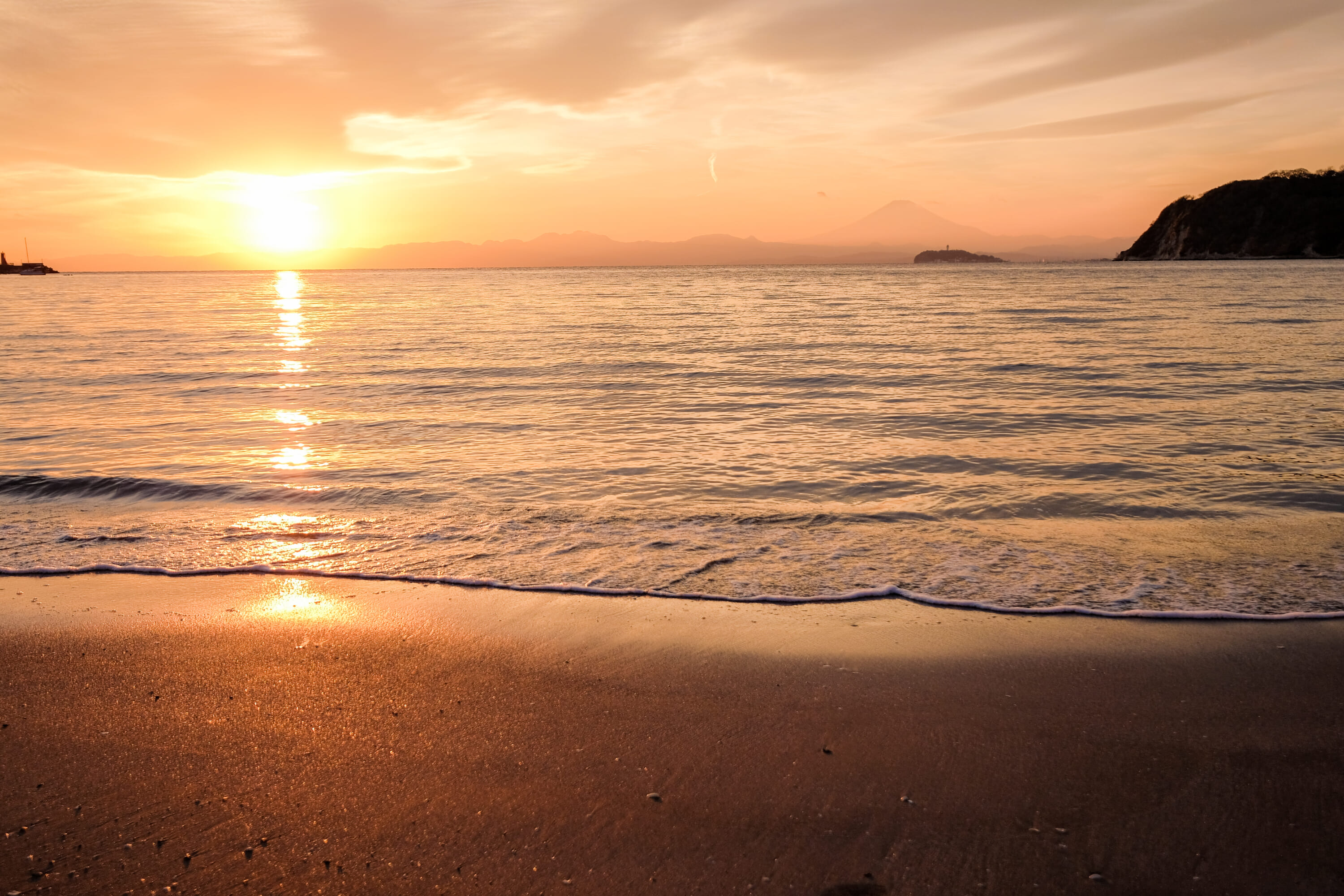
1. Zushi Beach
Can you believe it takes only a little more than one hour to get from the concrete jungle of Shibuya to the salt breezes of Zushi? From Shibuya Station, board a local Shonan-Shinjuku Line train stopping in Zushi, a beachside town located between Kamakura and Yokosuka. Within the hour, you’ll arrive at Zushi Station, from where a 15-minute walk will take you to the idyllic sandy shores of Zushi Beach, a tranquil escape where you can enjoy shallow waves and bask under the sun. From the shore, you can also catch a stunning view of Mount Fuji.
Stroll to Hayama Marina , where you can shop, enjoy lunch and savor a gelato served from a charming yellow school bus. Save room for a second dessert, as Misaki Donuts , a local specialty store known for its handmade donuts, is conveniently located near the station.
With a belly full of donuts or a hefty to-go bag, head back to Tokyo — and be sure to aloe up overnight to prevent sunburn!
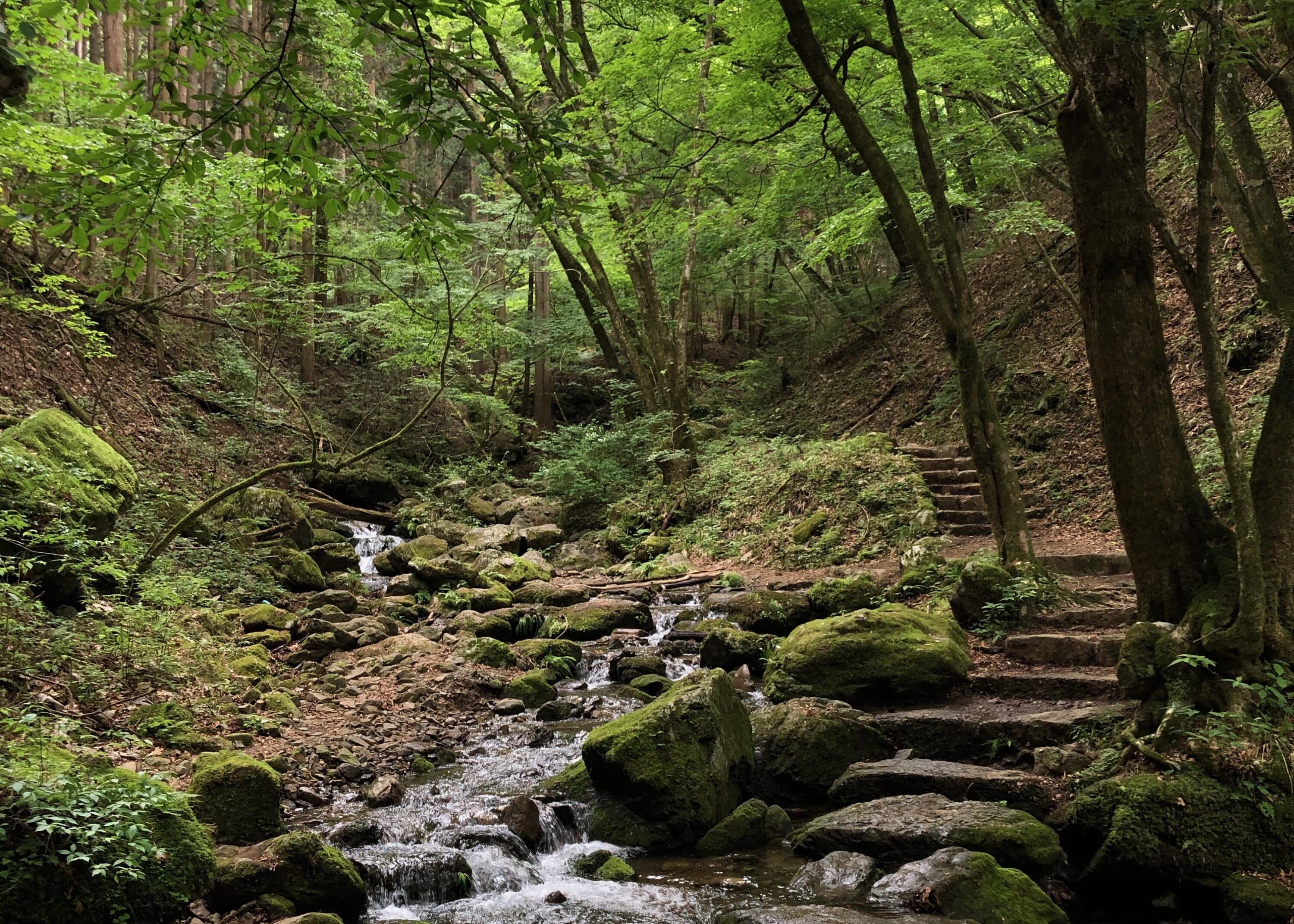
2. Mount Mitake
Though nearby Mount Takao often steals the limelight due to its easy accessibility and the many festivals held there throughout the year, Mount Mitake is not a mountain to be overlooked. Famous for its Rock Garden hike, a beginner-friendly 1.5-kilometer loop, Mitake provides the perfect opportunity to top up your chi.
Take a moment to listen to the sounds of running water and native birds as you make your way up the rocky stream. On the way back, stop by the summit to visit Musashi-Mitake-jinja Shrine . Founded during the reign of Emperor Sujin (97–30 BCE), this shrine worships Oguchimagami, a divinity that protects farmers from disasters.
After visiting the shrine, enjoy a home-cooked meal and dessert prepared by locals while taking in the stunning views of the mountain range. Before heading back to the station, browse the small souvenir shops selling traditional Japanese otsukemono (pickled vegetables) and plush toys.
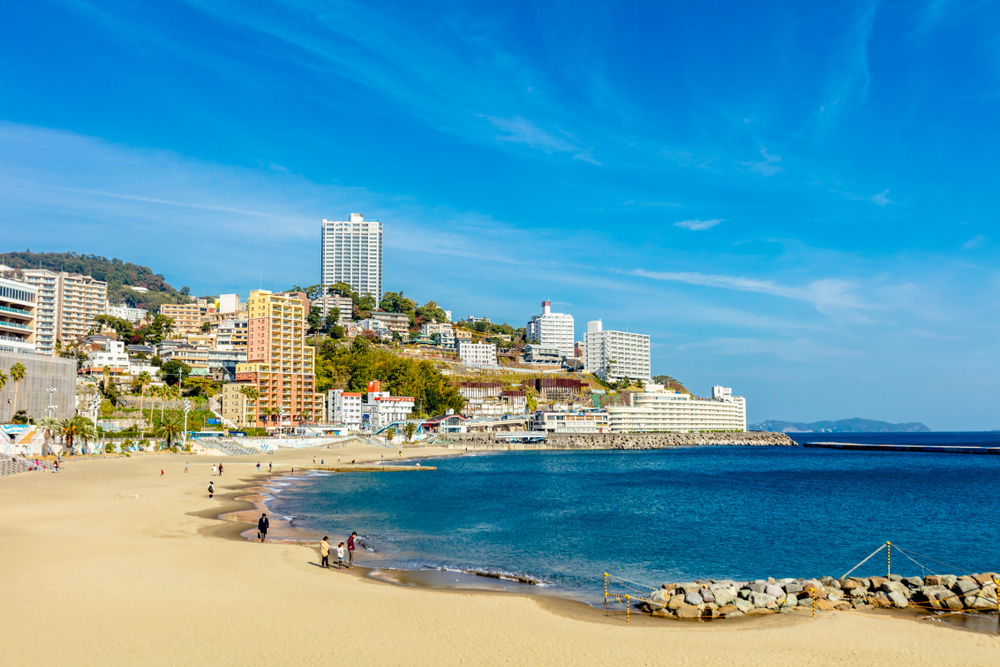
Atami, a beautiful seaside city in Shizuoka Prefecture that retains its traditional charm, is an easy 45-minute shinkansen ride from Tokyo Station. Explore the city’s winding shopping streets filled with shops selling traditional Japanese snacks and other food before finding a spot — whether on the beach or higher ground — to watch a 20-minute nighttime fireworks show.
The historic Atami Fireworks Festival , held over 10 times a year, attracts crowds from all over the region. Each firework explosion sends sparkling tendrils of light up over the sea, creating a reflection on the water’s mirror-like surface. The interplay of reflections and sounds — from both the explosions and the waves — exemplifies the beauty and power possible when nature and human creativity come together.
Once the show ends, the station gets very congested, so be sure to purchase a round-trip train ticket when leaving Tokyo.
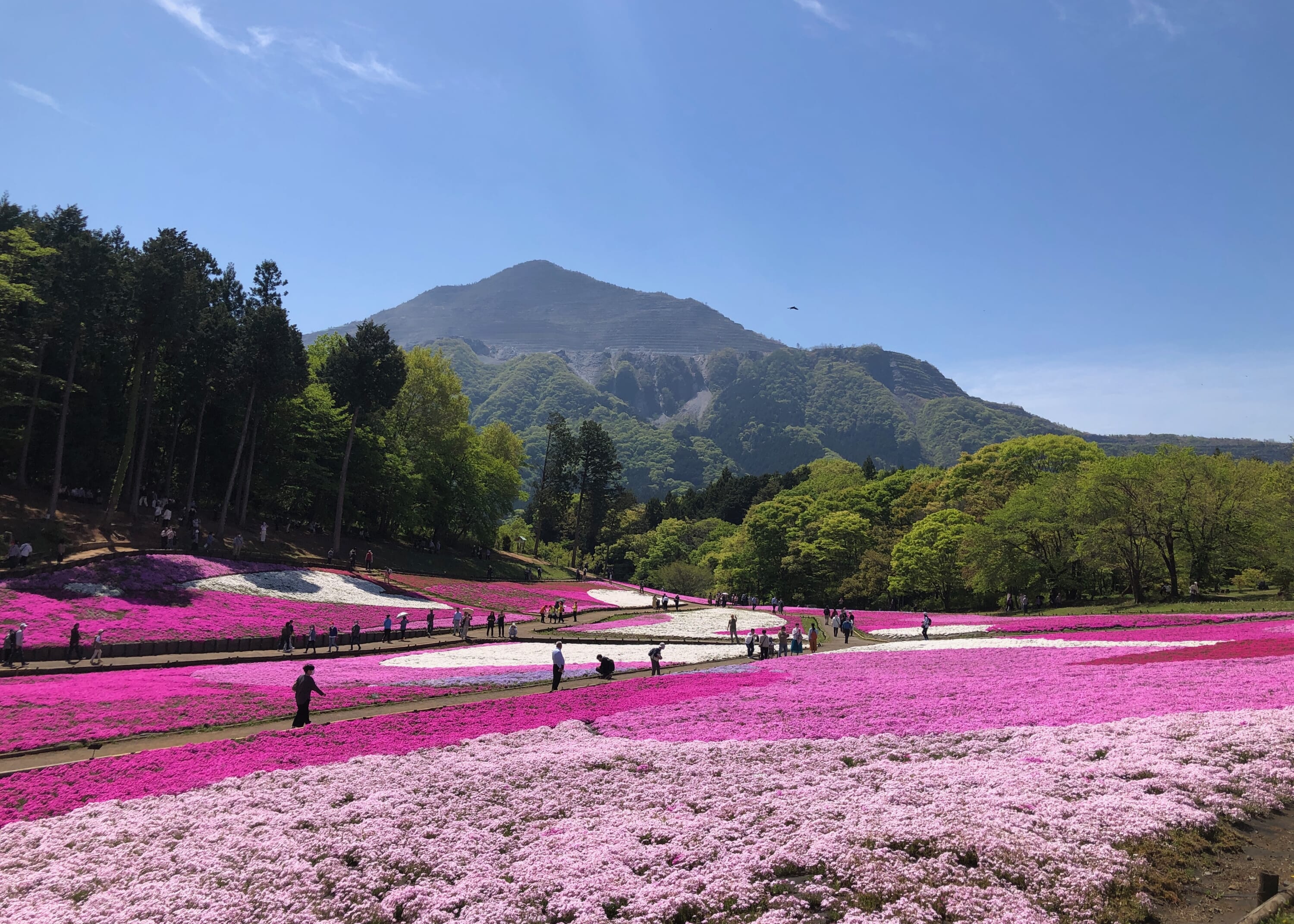
4. Hitsujiyama Park
This park northwest of Tokyo is known for its 400,000 shibazakura plants that bloom each April. While shibazakura season may be over, don’t let that stop you from planning your next trip to the park. Located about a 15-minute walk from Chichibu Station — itself around 1.5 hours from Tokyo’s Ikebukuro Station — Hitsujiyama Park is a breathtaking scenic escape from Tokyo.
While you’re there, be sure to visit the springtime markets that sell locally crafted wares and traditional foods, including wooden utensils, flower mochi and skewered grilled fish. If you prefer to sit in a restaurant, try one of the 60 soba restaurants in the town’s center. The Chichibu region cultivates buckwheat flour — the main ingredient in soba — making the noodles a must-try local dish.
Meander around the shopping district and visit the local temples before heading back to the station for some heavy-duty souvenir shopping and the return trip to Tokyo.
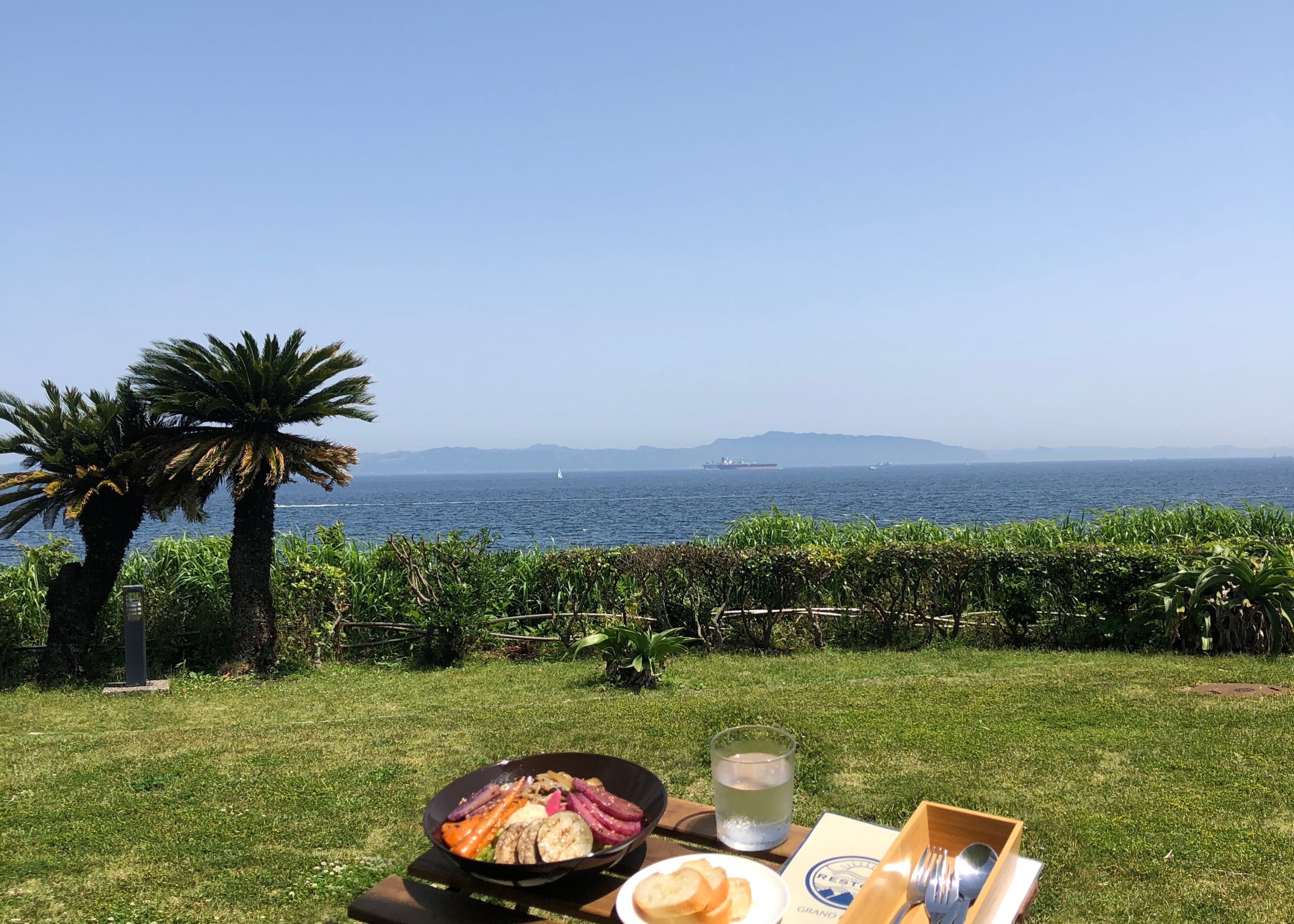
5. Kannonzaki Park
Kannonzaki Park, located in Yokosuka, will no longer be gatekept! A secret spot beloved by locals, the park is a beautiful place an hour from Tokyo that ticks all the boxes for a nature-filled day trip. At the easternmost point of the Miura Peninsula, Kannonzaki makes you forget you’re in Japan. Not only does the park feature panoramic ocean views, it also boasts attractions like the Kannonzaki Nature Museum, Kannonzaki Lighthouse and the Yokosuka Museum of Art.
Enjoy a slow lunch at a café looking out over Tokyo Bay, or bring food to grill and sizzle away the afternoon at one of the many barbecue picnic spots in the area. Unwind on the white, sandy shores and, if it’s warm enough, dip your toes into the clear blue water before heading back up the beach to the bus stop for the ride back to the station.
Related Posts
- Day Trips From Tokyo: 7 Things To Do, See and Eat in Chichibu
- Day Trips From Tokyo: Sunbathing in Hayama, Kanagawa Prefecture
- Day Trip From Tokyo: Explore Shonan by Boat or by Board
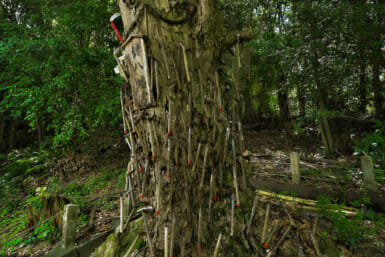
Japan's Scariest Shrine: Kama Hachimangu
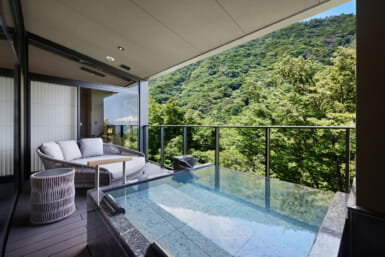
A Private Onsen in Hakone Worth the Visit: Hatsuhana
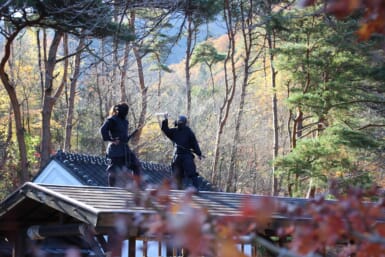
8 Places to Experience the Ninja Lifestyle in Japan
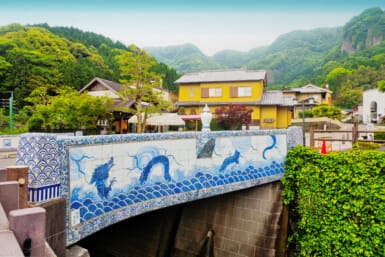
Living History in Okawachiyama: The Village of Secret Kilns

Tara: A Mystical Oceanside Town Where You Can Feel the Moon’s Power

Super Delivery International: Bringing Japan to Your Door

Stay in Style at DoubleTree by Hilton Kyoto Station

A Culinary Wonderland in Hyogo Prefecture

COMMENTS
Located in the west part of Kanagawa prefecture, Hakone attracts numerous tourists all year round with a range of tourist attractions and scenic spots around.Because Hakone is easily accessible from Tokyo, it takes only 1.5 hours to get to the area from Tokyo by train, it is a popular day trip destination as well!. Popular attractions around Hakone Yumoto Onsen
10 Best Hotels In Tokyo With Airport Shuttle - Updated 2024. 1. Enjoy the great view of Mount Fuji from Hakone Yumoto (from USD 159) Show all photos. Hakone Yumoto is an area filled with various facilities and is well-known for its great natural hot spring. It is a popular area among local tourists, especially families.
3. Ikaho: Iron-rich waters and slurp-worthy noodles. 4. Atami: A seaside resort. 5. Kinugawa: A riverside onsen town near Nikkō. Home. Things to do in Tokyo. Japan has more hot spring facilities than almost anywhere in the world, so it's the perfect place to warm up this winter with a good soak.
1. Hakone Onsen (1.5h from Tokyo) One of the Best Onsen Towns Near Tokyo. Location: Hakone, Fuji Hakone Izu National Park, Kanagawa Prefecture. General Information: Hakone Onsen (箱根温泉) is one of Japan's most popular hot spring resorts and one of the most popular day trip destinations from Tokyo.
Visit Onsen in Tokyo - Relaxing Hot Springs. An essential part of any trip to Japan is relaxing at an onsen, or hot spring.When it comes to onsen, well-known hot spring areas such as Hakone and Beppu soon come to mind, but you can also enjoy onsen in Tokyo as well.. Also, if you you go to Hakone, Nikko, or any of the other onsen areas, you can enjoy delicious cuisine and relax in hot springs ...
Just 3 hours from Tokyo is the DHC Akazawa Onsen Kyo. Unlike other hot springs, this place is run by DHC, a resort company, and a trip to Akazawa will not only be about the natural hot springs there! DHC Akazawa Onsen Kyo is a multi-purpose resort with a wide array of facilities including fitness clubs and swimming pools.
5. Nasu Onsen (Tochigi): A leading hot spring resort near Tokyo. Nasu Onsen Resort is a group of amazing hot springs situated in the area surrounding Mt. Chausu, the only active volcano in Tochigi Prefecture. The resort includes 11 different hot springs, with Nasu Onsen (also known as "Kanoyu") being the most well-known, having been discovered ...
Tokyo included, the Nippon Onsen Research Association counts over 3,000 onsen spread around Japan, in locations ranging from Hokkaido to the southernmost islands of Okinawa.
The hot spring in the Mitsui Garden Nihonbashi is clean and tidy, and the quality and hospitality here are top notch throughout the stay. You will like the Japanese bath in this Tokyo onsen hotel. Address: Japan, 〒103-0022 Tokyo, Chuo City, Nihonbashimuromachi, 3 Chome−4−4 9階. Phone: +81 3-3270-1131.
Information for a wonderful trip. The official Hakone travel guide for your visit for hot springs, hiking, and to discover things to do, popular attractions, and places to stay. Hakone has easy access from Tokyo for art museums, ryokan, historic attractions and more.
Here are five great and most popular onsen towns near Tokyo: 1. Hakone Onsen. An outdoor onsen of Hotel Green Plaza Hakone and Mount Fuji in the distance, Hakone. Hakone has been a popular area for natural hot spring baths for centuries. The town has many bathhouses, drawing from more than a dozen springs.
A trip to this nearby prefecture means serene nature packed with beautiful mountains and soothing hot springs. Very different from the hustle and bustle of Tokyo. If you take a trip to Takaragawa Onsen, go through the list of ryokan (traditional Japanese inn) and book yourself a traditional onsen stay. 2. Niwa no Yu. Location: Nerima Ward, Tokyo
Kurokawa Onsen, Kumamoto. Popular for being one of the most picturesque hot spring destinations in Japan, this town in Kyushu features nearly 30 onsen baths for visitors to hop between. Kurokawa ...
After shopping and sightseeing in Tokyo, there's no better relief for tired muscles than hot springs surrounded by nature. This article will introduce 10 of the best onsen (hot spring) resorts in Japan's Kanto region, including popular areas such as Nikko or Kusatsu. These onsen are easily accessible from Tokyo, with some even doable on a day trip! We will also introduce the highlights and ...
By train. Take the JR Yamagata Shinkansen from Tokyo to Oishida Station (about 200 minutes, around 12,500 yen one way), from where buses depart roughly every two hours for Ginzan Onsen (35 minutes, 720 yen one way). The train portion of the journey is fully covered by the Japan Rail Pass, JR East Tohoku Area Pass and JR East South Hokkaido Pass, but the bus ride is not.
Photo by Pixta Kusatsu Onsen is a hot spring district in Gunma Prefecture, located about three to four hours by bus from Tokyo. The amount of natural hot spring water flowing at Kusatsu Onsen is the highest in Japan. Kusatsu is known for its high-quality, free-flowing springs that are thought to warm the body and help kill bacteria.
Shuzenji Onsen is a lovely option for an overnight trip out of Tokyo. Surrounded by mountains on all sides, this charming hot spring resort town has gorgeous scenery, delicious food, and an abundance of hot spring baths. It's especially beautiful during spring for the blossoms, and in autumn for the colours. Unsurprisingly, it's one of the ...
We will introduce them below. 1. Boso Kamogawa Onsen - ZEKUU - (房総鴨川温泉 是空-ZEKUU-) Photo courtesy of Boso Kamogawa Onsen. Boso is a Japanese-style hot spring inn located along the coast of Chiba Prefecture, about a two-hour train ride from Tokyo Station.
Contents show. The Takaragawa Onsen Osenkaku is located in the Minakami Onsen area and can form a day trip away from Tokyo. With one of the largest open-air outdoor baths, you can enjoy the sights of nature while soaking in the hot spring. The onsen is up in the mountains in Gunma Prefecture and can be accessed by train or bus.
The Nozawa Onsen snow resort boasts 46 runs in total, including standard slopes, half pipes and cross country training facilities. The 20 ski lifts mostly operate from 8.30am to around 4pm or 4 ...
From Tokyo Station, you'll want to ride the Joetsu Shinkansen northward to Jomo-Kogen, where shuttle buses to Takaragawa Onsen (you'll need to reserve your spot at the time of booking) depart a couple of times per day. Depending on the location of your hotel in Tokyo, door-to-door travel time should be under three hours.
Ginzan Onsen can be accessed by a combination of JR trains and buses. From Tokyo, take the JR Yamagata Shinkansen to Oishida Station (three hours, 20 minutes), then catch a bus to Ginzan Onsen (35 minutes). The train is covered by the Japan Rail Pass, but the bus is not. Be aware that buses only depart Oishida Station every 60-90 minutes.
From Tokyo. By train. There are various ways to get to Hakone Onsen from Tokyo, but we recommend the Limited Express Romancecar from Shinjuku, as it's the fastest (80 minutes), most comfortable, and has a discount when you buy the Hakone Freepass. It costs 2,330 JPY, or just 1,110 JPY if you have the Hakone Freepass.
A new high-speed train stop unlocks Kaga, a destination for onsen, nourishing food and traditional crafts, as an easy-to-reach getaway from Japan's capital. A riverside cafe pops up from spring ...
5. Kannonzaki Park. Kannonzaki Park, located in Yokosuka, will no longer be gatekept! A secret spot beloved by locals, the park is a beautiful place an hour from Tokyo that ticks all the boxes for a nature-filled day trip. At the easternmost point of the Miura Peninsula, Kannonzaki makes you forget you're in Japan.